Edgecore Networks SMCWGBR14N2 802.11n Wireless 4-port Gigabit Broadband Router User Manual user guide
Edgecore Networks Corporation 802.11n Wireless 4-port Gigabit Broadband Router user guide
Contents
- 1. User Manual 1
- 2. User Manual 2
User Manual 2
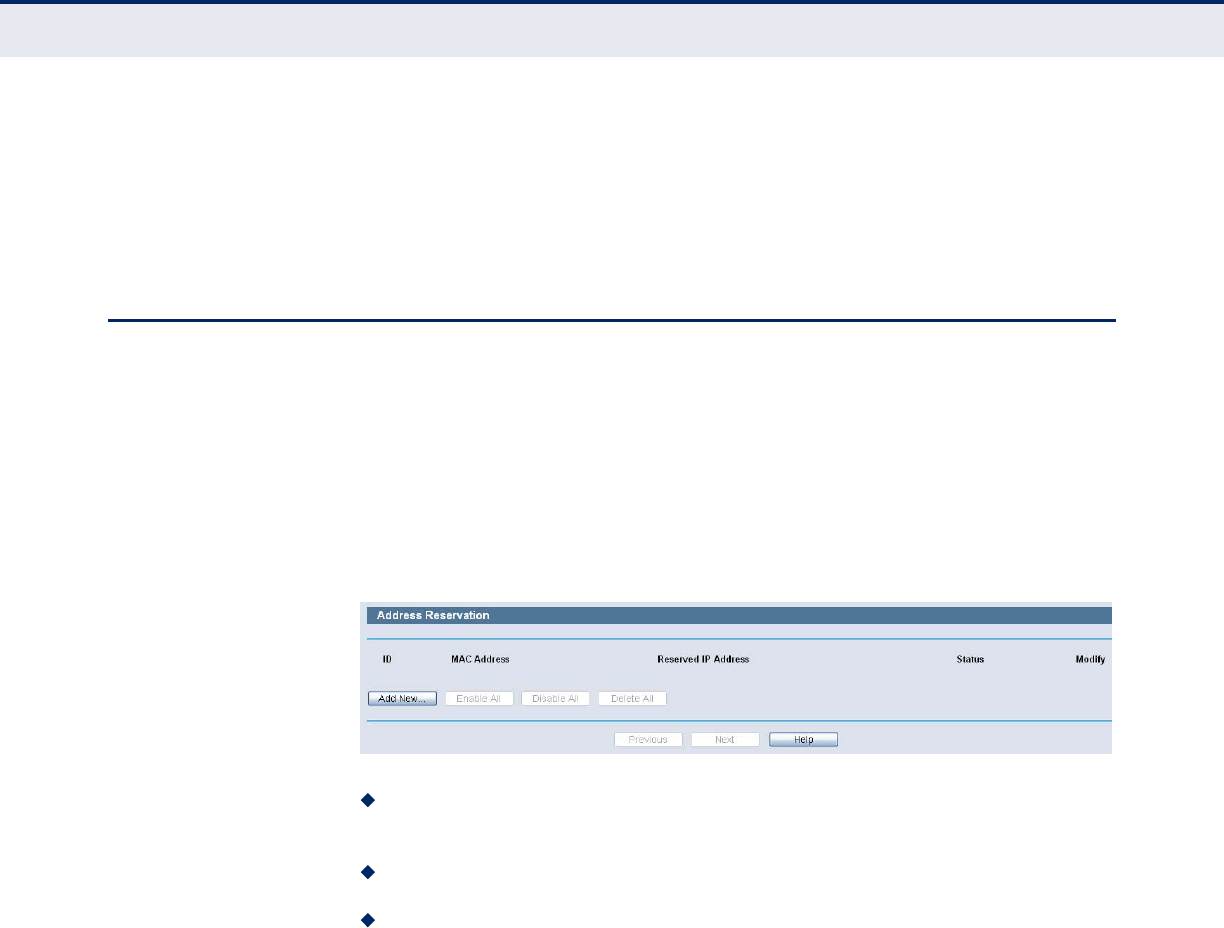
C
HAPTER
7
| DHCP Settings
Address Reservation
– 67 –
◆Lease Time - The time of the DHCP client leased. After the dynamic IP
address has expired, a new dynamic IP address will be automatically
assigned to the user.
You cannot change any of the values on this page. To update this page and
to show the current attached devices, click the Refresh button.
ADDRESS RESERVATION
Choose menu “DHCP->Address Reservation”, you can view and add a
reserved addresses for clients via the following figure.When you specify a
reserved IP address for a PC on the LAN, that PC will always receive the
same IP address each time when it accesses the DHCP server. Reserved IP
addresses should be assigned to the servers that require permanent IP
settings.
Figure 58: Address Reservation
MAC Address - The MAC address of the PC for which you want to
reserve IP address.
Assigned IP Address - The IP address of the Router reserved.
Status - The status of this entry either Enabled or Disabled.
To Reserve IP addresses:
1. Click the Add New button.
2. Enter the MAC address (in XX-XX-XX-XX-XX-XX format.) and IP address
in dotted-decimal notation of the computer you wish to add.
3. Click the Save button when finished.

C
HAPTER
7
| DHCP Settings
Address Reservation
– 68 –
Figure 59: Add or Modify an Address Reservation Entry
To modify or delete an existing entry:
1. Click the Modify in the entry you want to modify. If you want to delete
the entry, click the Delete.
2. Modify the information.
3. Click the Save button.
Click the Enable/ Disabled All button to make all entries enabled/disabled
Click the Delete All button to delete all entries
Click the Next button to go to the next page and Click the Previous button
to return the previous page.
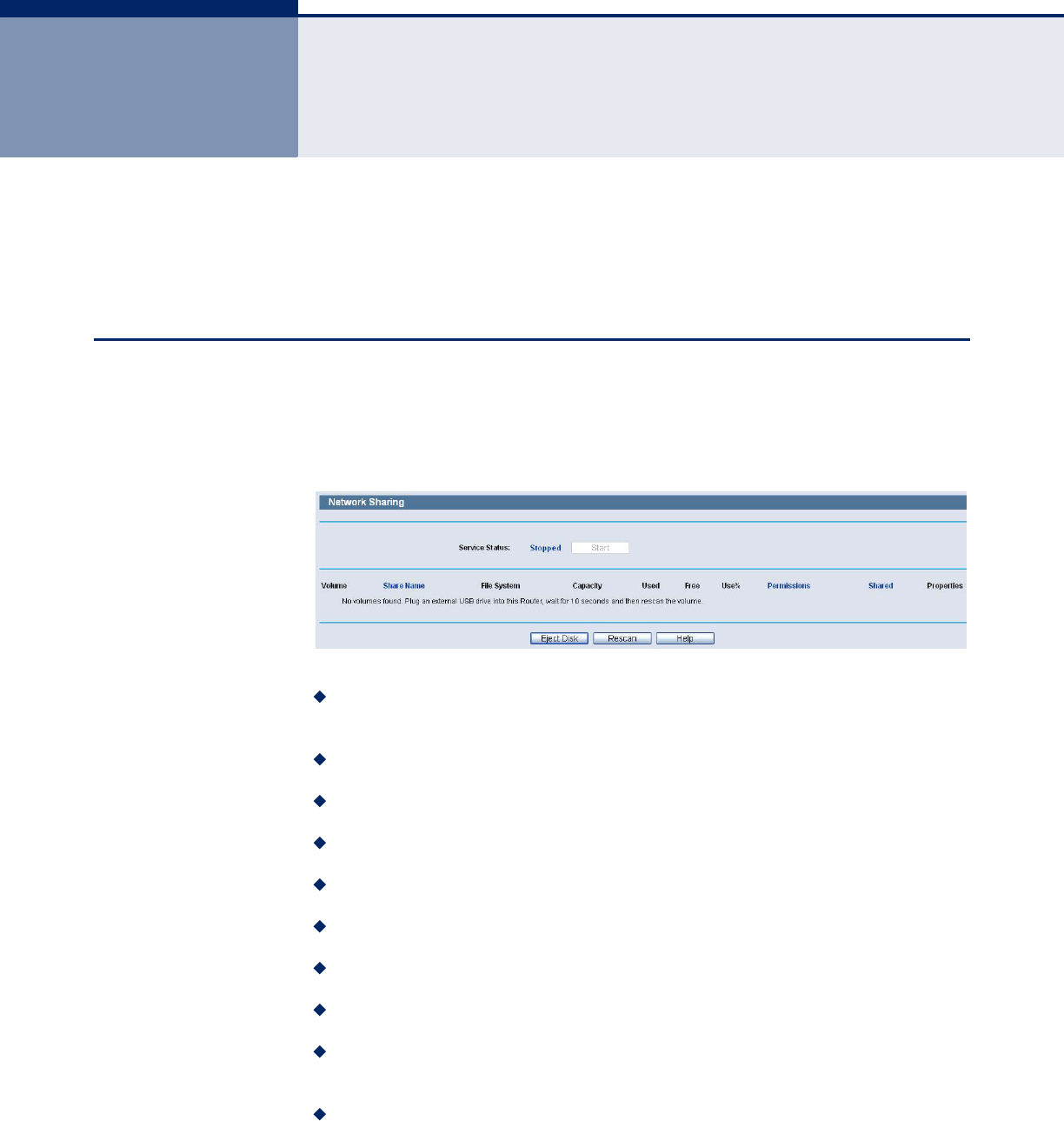
– 69 –
8USB STORAGE SETTINGS
There are two submenus under the Network Sharing menu: Sharing
Service and User Accounts. Click any of them, and you will be able to
configure the corresponding function.
SHARING SERVICE
Choose menu “Network Sharing->Sharing Service”, you can configure a
USB disk drive attached to the Router on this page.
Figure 60: Network Sharing
Service Status - Indicates the Network Sharing service's current
status.
Volume - The volume name of the USB drive the users have access to.
Share Name - The specified share name of the volume.
File System - The file system on the partition can be FAT32 or NTFS.
Capacity - The storage capacity of the USB driver.
Used - The used space of the USB driver.
Free - The available space of the USB driver.
Use% - The percentage of the used space.
Permissions - Read-Only or Read/Write access to the volume
designated as the share.
Shared - Indicates the shared or non-shared status of the volume.
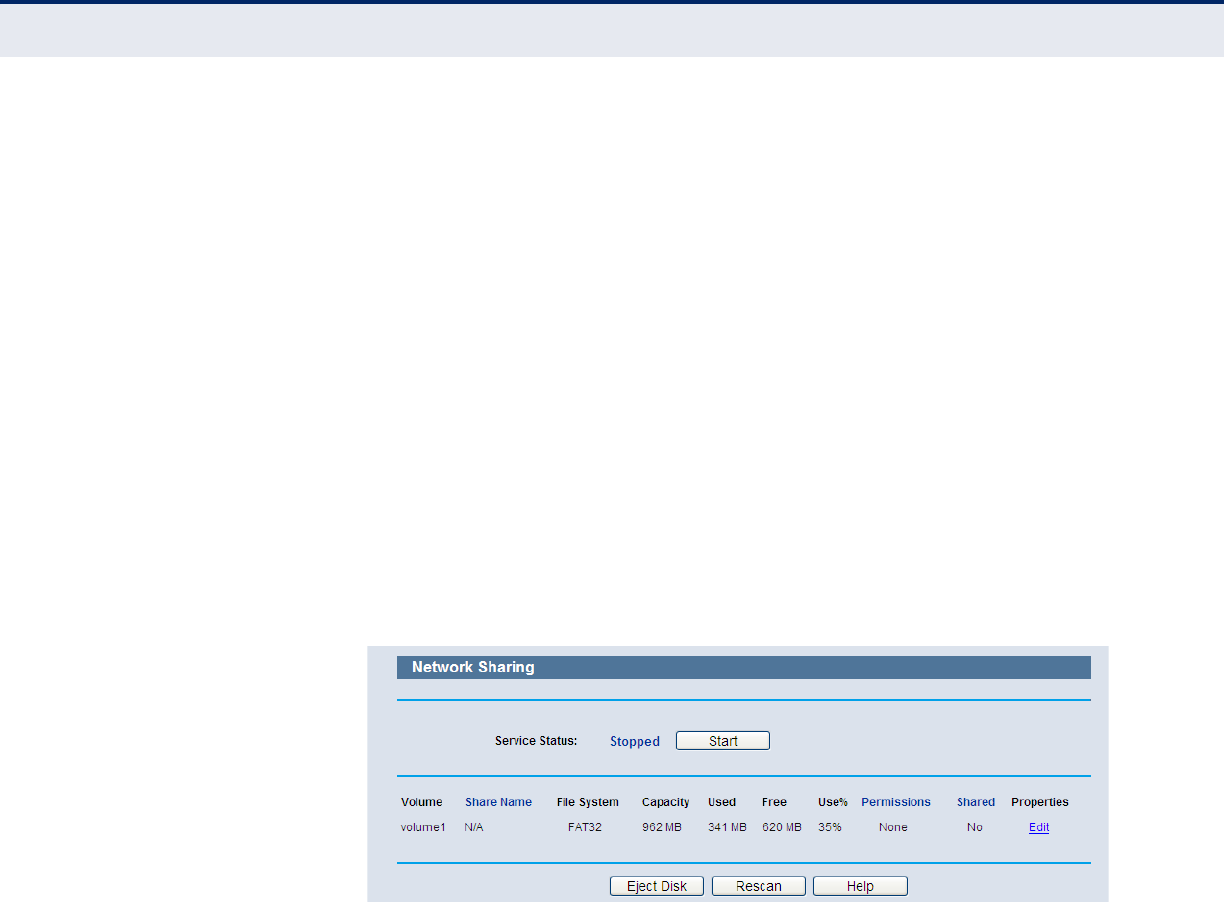
C
HAPTER
8
| USB Storage Settings
Sharing Service
– 70 –
◆Properties - Displays the Edit link to specify a volume that the
Network Sharing users can access.
Click the Start button to start the Network Sharing service.
Click the Stop button to stop the Network Sharing service.
Click the Eject Disk button to safely remove the USB storage device that is
connected to USB port. This takes the drive offline. A message will appear
on your web browser when it is safe to detach the USB disk.
Click the Rescan button to start a new scan.
Follow the instructions below to set up your Router as a file server:
1. Plug an external USB hard disk drive or USB flash drive into this Router.
2. Click the Rescan button to find the USB drive that has been attached to
the Router, and then the screen will appear as the following figure
shown.
Figure 61: Sharing Settings - Rescan
3. To specify a volume that the Network Sharing users can access, click
the Edit link in the Properties column and configure the share settings.
4. Set the Network Sharing user's username and password on User
Accounts page.
5. Click the Start button to start the Network Sharing service.
6. Now the Network Sharing users inside your local network can access
files on the USB drive from Internet Explorer at its Share Name
followed by the Router's LAN IP address, for example:
\\192.168.2.1\MyShare.
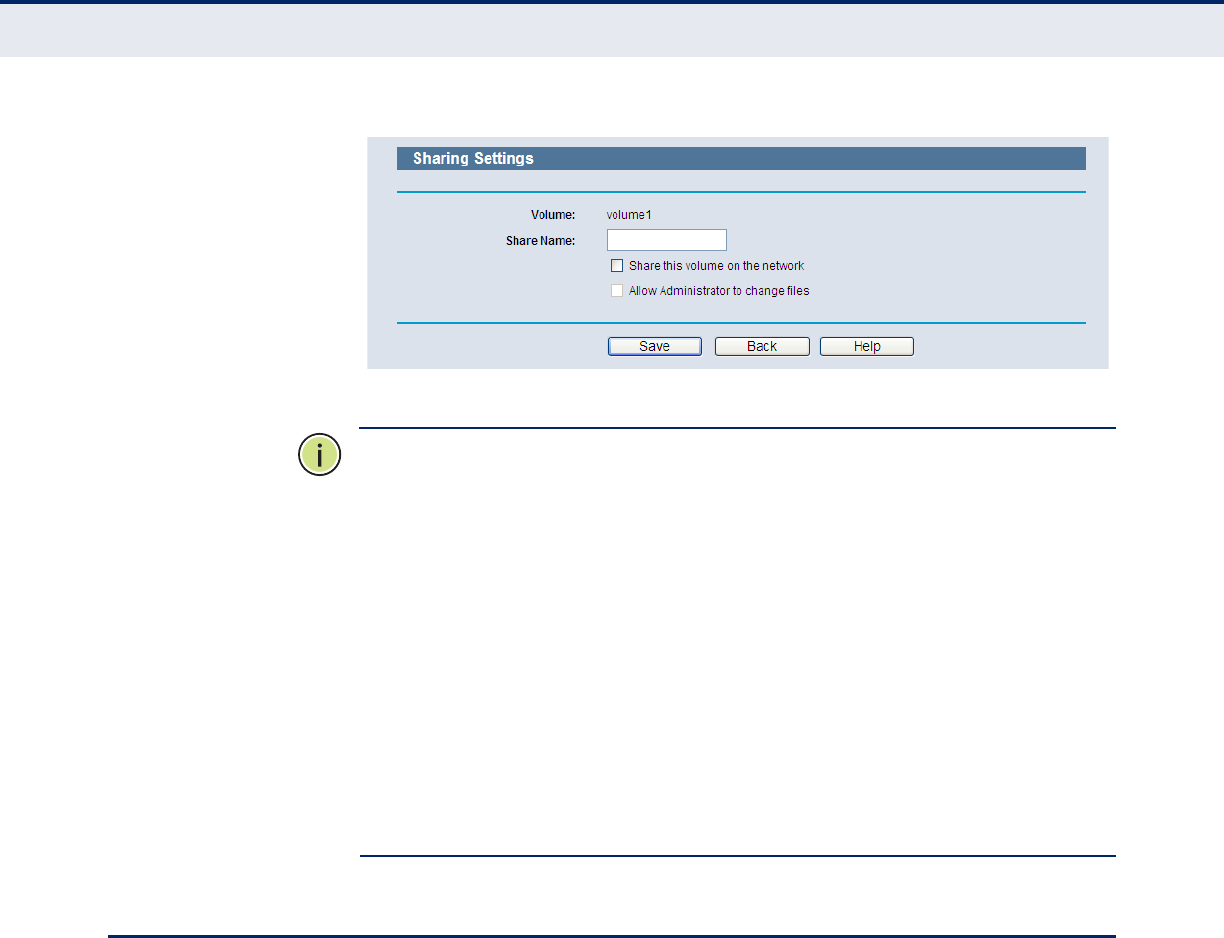
C
HAPTER
8
| USB Storage Settings
User Accounts
– 71 –
Figure 62: Sharing Settings - Edit
N
OTE
:
The Router cannot automatically locate new USB drive. You have to
click the Rescan button manually to display a list of volumes and
information about them.
N
OTE
:
The new settings will not take effect until you restart the service.
N
OTE
:
To unplug the USB drive, click Eject Disk button first. Simply pulling
USB drive out of the USB port can cause damage to the device and loss of
data.
N
OTE
:
Mounted volumes are subject to the 8-volume limit. So you cannot
access more than 8 volumes on the USB storage device.
N
OTE
:
NTFS is the recommended file system for Network Sharing because
it supports several features that the other file systems do not, such as
large files and large volume support.
USER ACCOUNTS
You can specify the user name and password for Network Sharing users on
the following User Accounts page. Network Sharing users can use Internet
Explorer to access files on the USB drive.
There are two Network Sharing users that can access the shares. They are
Administrator and Guest. Administrator has read/write access while Guest
has read-only access.
Only Administrator can use a Web browser to transfer the files from a PC to
the Writable shared volume on the USB drive.
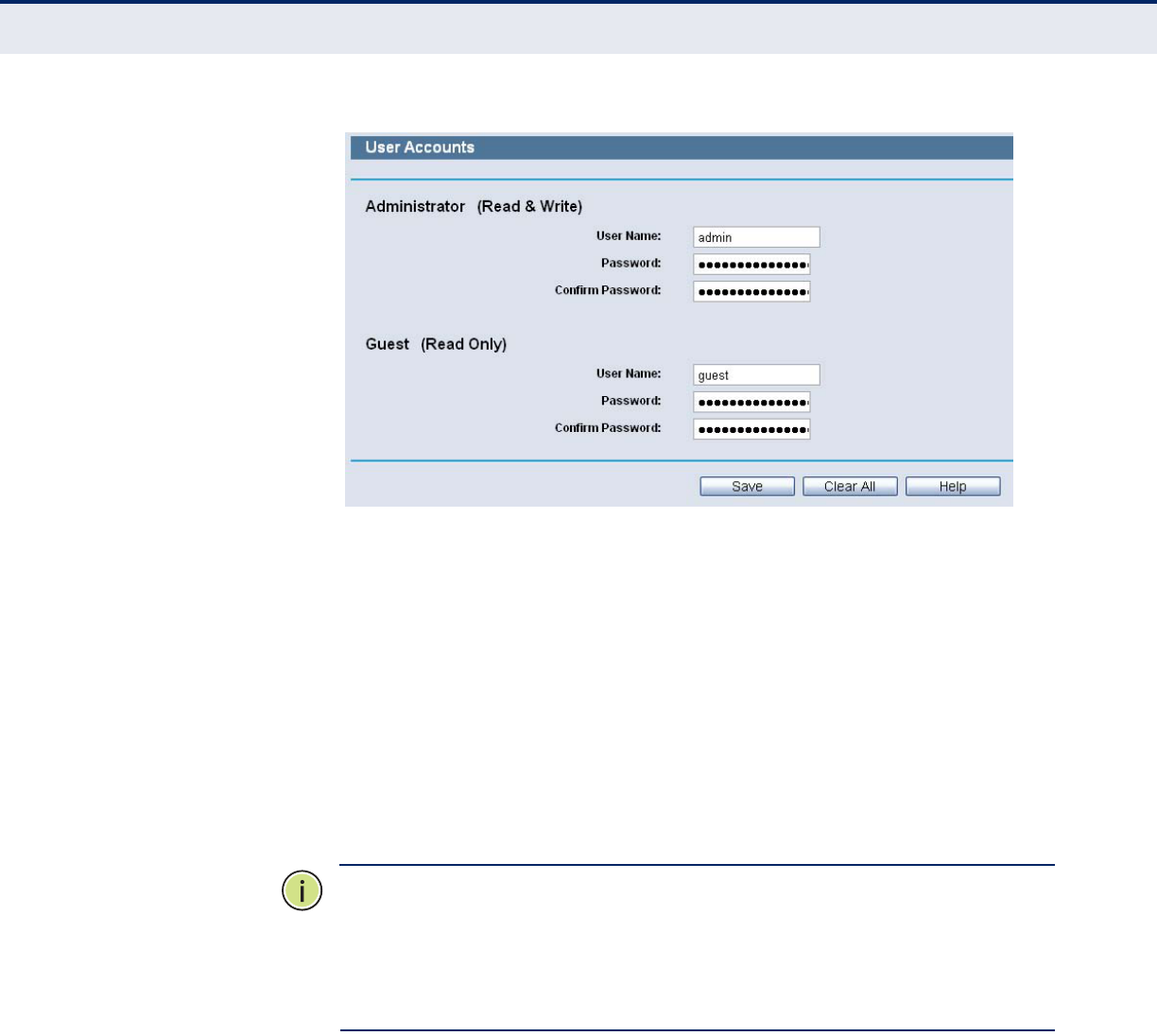
C
HAPTER
8
| USB Storage Settings
User Accounts
– 72 –
Figure 63: User Accounts
◆User Name - Type the user name that you want to give access to the
USB drive. The user name must be composed of alphanumeric symbols
not exceeding 15 characters in length.
◆Password - Enter the password in the Password field. The password
must be composed of alphanumeric symbols not exceeding 15
characters in length. For security purposes, the password for each user
account is not displayed.
◆Confirm Password - Re-enter the password here.
Click the Save button to save your settings.
Click the Clear All button to clear all the fields.
N
OTE
:
1. Please restart the service for the new settings to take effect.
2. If you cannot use the new user name and password to access the
shares, press Windows logo + R to open the Run dialog box and type net
use \\192.168.2.1 /delete /yes and press Enter. (192.168.2.1 is your
Router's LAN IP address.)
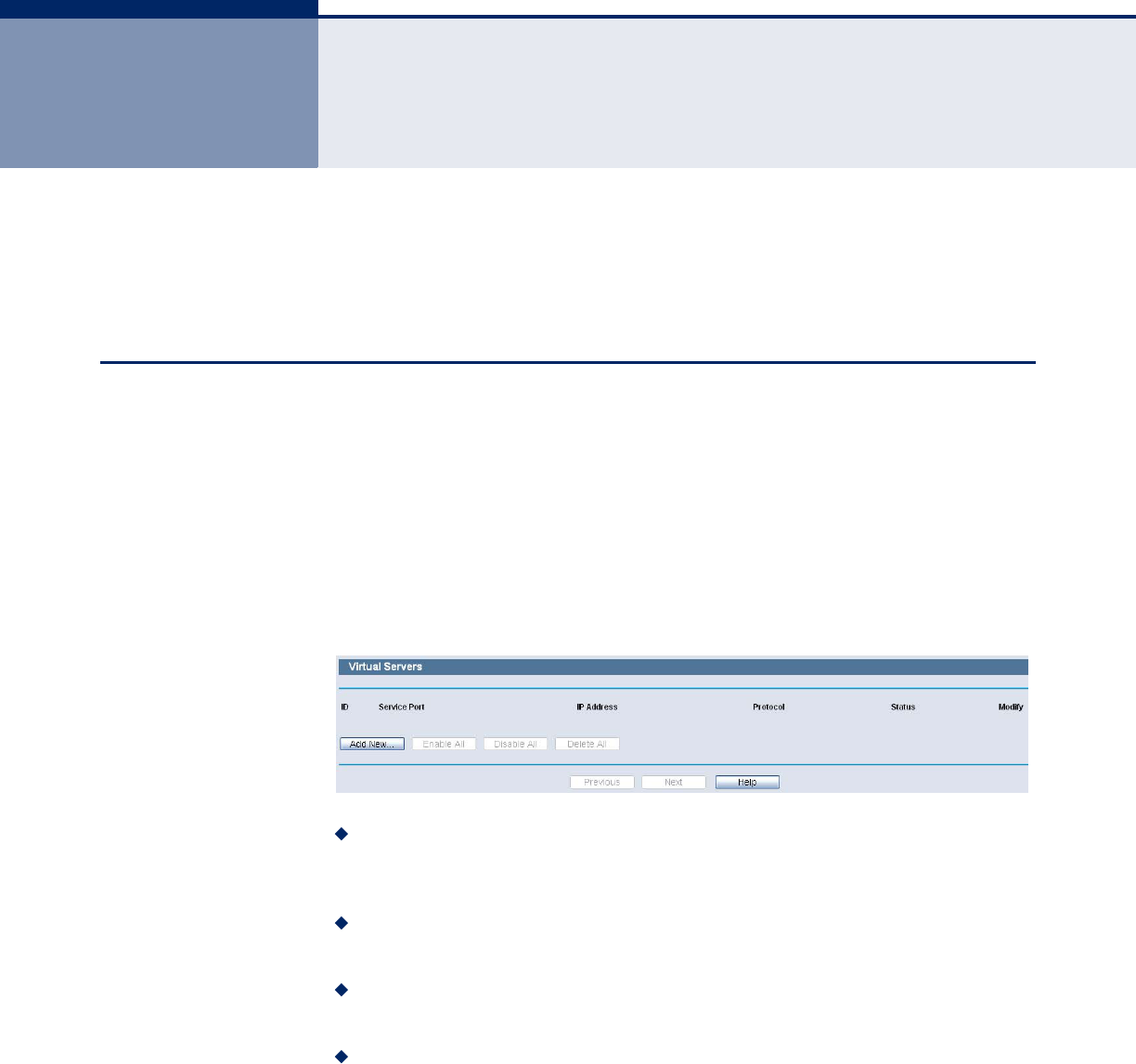
– 73 –
9SPECIAL APPLICATION SETTINGS
There are four submenus under the Special Application menu: Virtual
Servers, Port Triggering, DMZ and UPnP. Click any of them, and you will be
able to configure the corresponding function.
VIRTUAL SERVERS
Choose menu “Special Application->Virtual Servers”, you can view and add
virtual servers in the following screen. Virtual servers can be used for
setting up public services on your LAN, such as DNS, Email and FTP. A
virtual server is defined as a service port, and all requests from the
Internet to this service port will be redirected to the computer specified by
the server IP. Any PC that was used for a virtual server must have a static
or reserved IP Address because its IP Address may be changed when using
the DHCP function.
Figure 64: Virtual Servers Settings
Service Port - The numbers of External Ports. You can type a service
port or a range of service ports (in XXX – YYY format, XXX is the start
port number, YYY is the end port number).
IP Address - The IP Address of the PC providing the service
application.
Protocol - The protocol used for this application, either TCP, UDP, or All
(all protocols supported by the Router).
Status - The status of this entry either Enabled or Disabled.
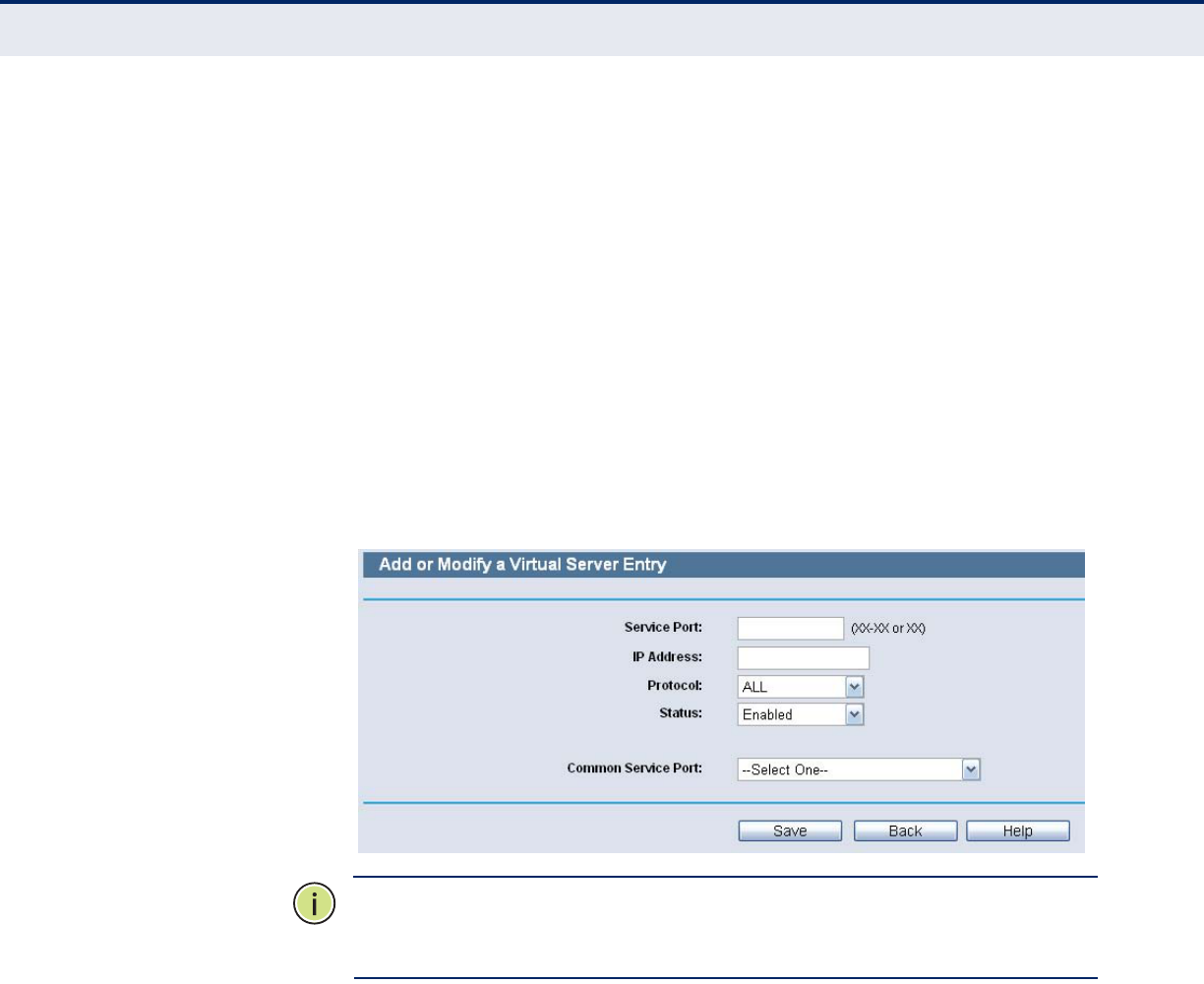
C
HAPTER
9
| Special Application Settings
Virtual Servers
– 74 –
To setup a virtual server entry:
1. Click the Add New button.
2. Select the service you want to use from the Common Service Port list.
If the Common Service Port list does not have the service that you want
to use, type the number of the service port or service port range in the
Service Port box.
3. Type the IP Address of the computer in the IP Address box.
4. Select the protocol used for this application, either TCP or UDP, or All.
5. Select the Enable check box to enable the virtual server.
6. Click the Save button.
Figure 65: Add or Modify a Virtual Server Entry
N
OTE
:
If your computer or server has more than one type of available
service, please select another service, and enter the same IP Address for
that computer or server.
To modify or delete an existing entry:
1. Click the Modify in the entry you want to modify. If you want to delete
the entry, click the Delete.
2. Modify the information.
3. Click the Save button.
Click the Enable/ Disabled All button to make all entries enabled/ disabled.
Click the Delete All button to delete all entries.
Click the Next button to go to the next page and click the Previous button
to return the previous page.
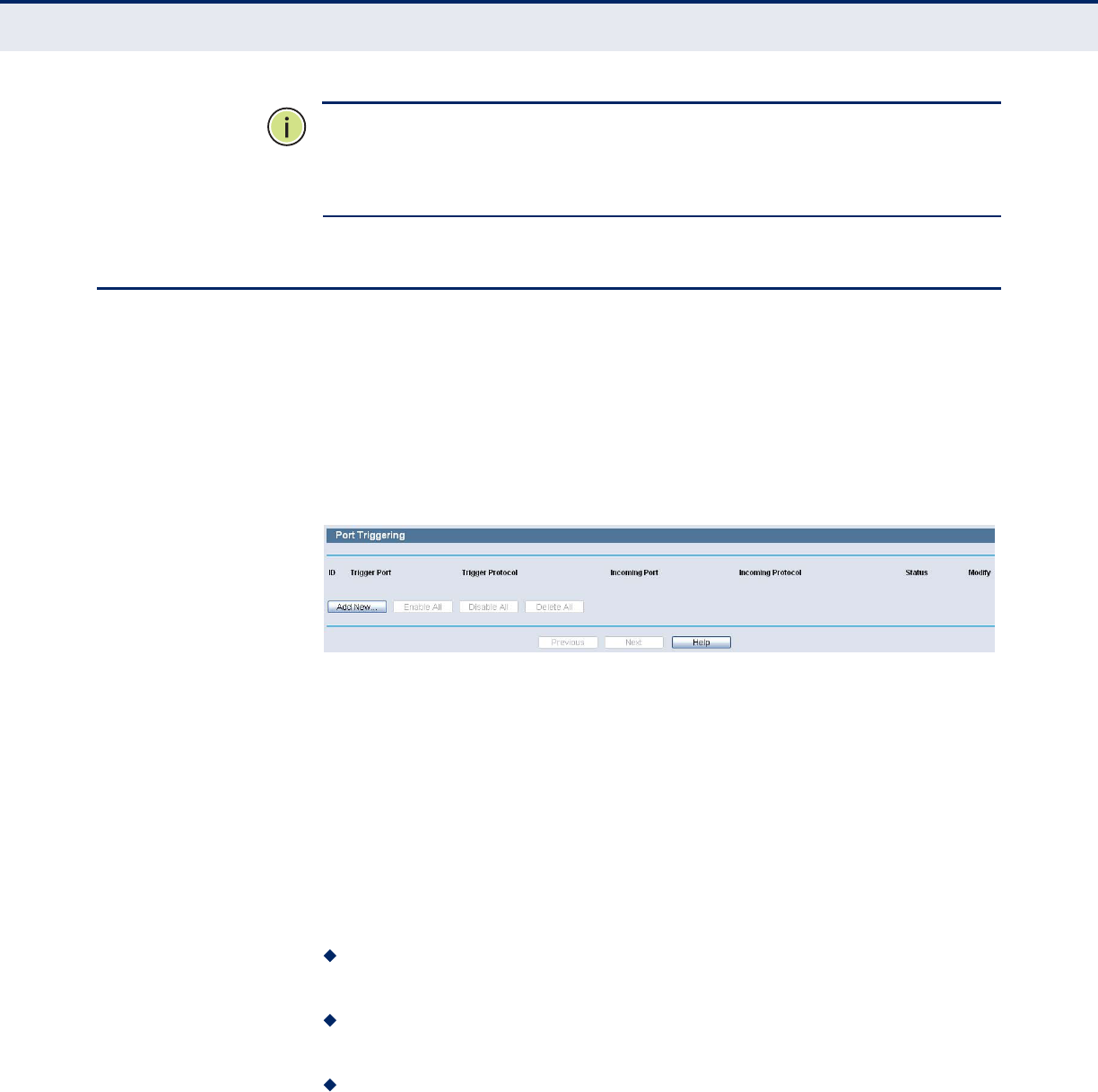
C
HAPTER
9
| Special Application Settings
Port Triggering
– 75 –
N
OTE
:
If you set the service port of the virtual server as 80, you must set
the Web management port on System Tools –> Remote Management page
to be any other value except 80 such as 8080. Otherwise there will be a
conflict to disable the virtual server.
PORT TRIGGERING
Choose menu “Special Application->Port Triggering”, you can view and add
port triggering in the following screen. Some applications require multiple
connections, like Internet games, video conferencing, Internet calling and
so on. These applications cannot work with a pure NAT Router. Port
Triggering is used for some of these applications that can work with an NAT
Router.
Figure 66: Port Triggering
Once the Router is configured, the operation is as follows:
1. A local host makes an outgoing connection using a destination port
number defined in the Trigger Port field.
2. The Router records this connection, opens the incoming port or ports
associated with this entry in the Port Triggering table, and associates
them with the local host.
3. When necessary the external host will be able to connect to the local
host using one of the ports defined in the Incoming Ports field.
Trigger Port - The port for outgoing traffic. An outgoing connection
using this port will "Trigger" this rule.
Trigger Protocol - The protocol used for Trigger Ports, either TCP,
UDP, or All (all protocols supported by the Router).
Incoming Ports Range - The port or port range used by the remote
system when it responds to the outgoing request. A response using one
of these ports will be forwarded to the PC that triggered this rule. You
can input at most 5 groups of ports (or port section). Every group of
ports must be set apart with ",". For example, 2000-2038, 2050-2051,
2085, 3010-3030.
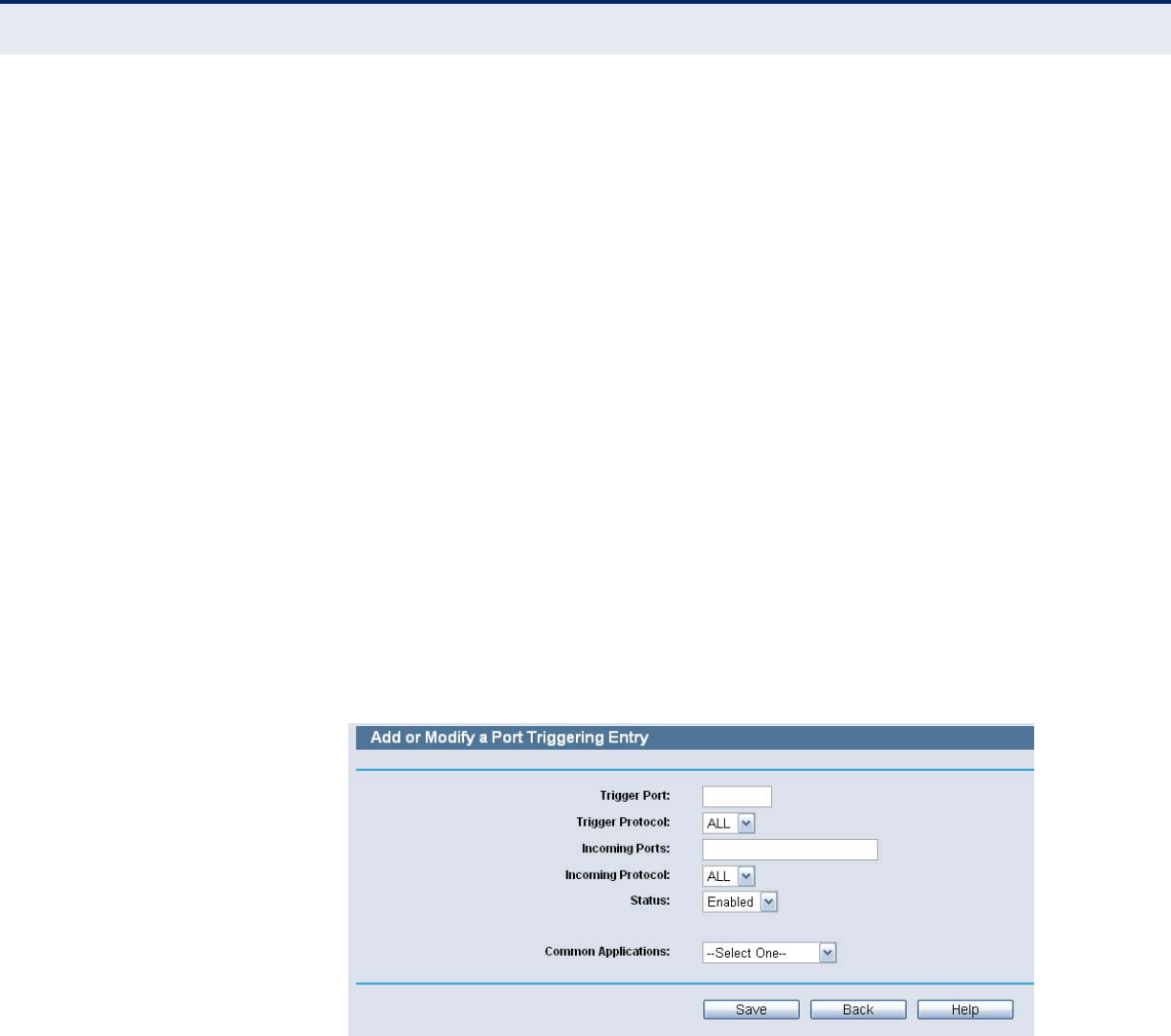
C
HAPTER
9
| Special Application Settings
Port Triggering
– 76 –
◆Incoming Protocol - The protocol used for Incoming Ports Range,
either TCP or UDP, or ALL (all protocols supported by the Router).
◆Status - The status of this entry either Enabled or Disabled.
To add a new rule, follow the steps below.
1. Click the Add New button.
2. Select a common application from the Common Applications drop-down
list, then the Trigger Port field and the Incoming Ports field will be
automatically filled. If the Common Applications do not have the
application you need, enter the Trigger Port and the Incoming Ports
manually.
3. Select the protocol used for Trigger Port from the Trigger Protocol drop-
down list, either TCP, UDP, or All.
4. Select the protocol used for Incoming Ports from the Incoming Protocol
drop-down list, either TCP or UDP, or All.
5. Select Enable in Status field.
6. Click the Save button to save the new rule.
Figure 67: Add or Modify a Triggering Entry
To modify or delete an existing entry:
1. Click the Modify in the entry you want to modify. If you want to delete
the entry, click the Delete.
2. Modify the information.
3. Click the Save button.
Click the Enable All button to make all entries enabled
Click the Disabled All button to make all entries disabled.
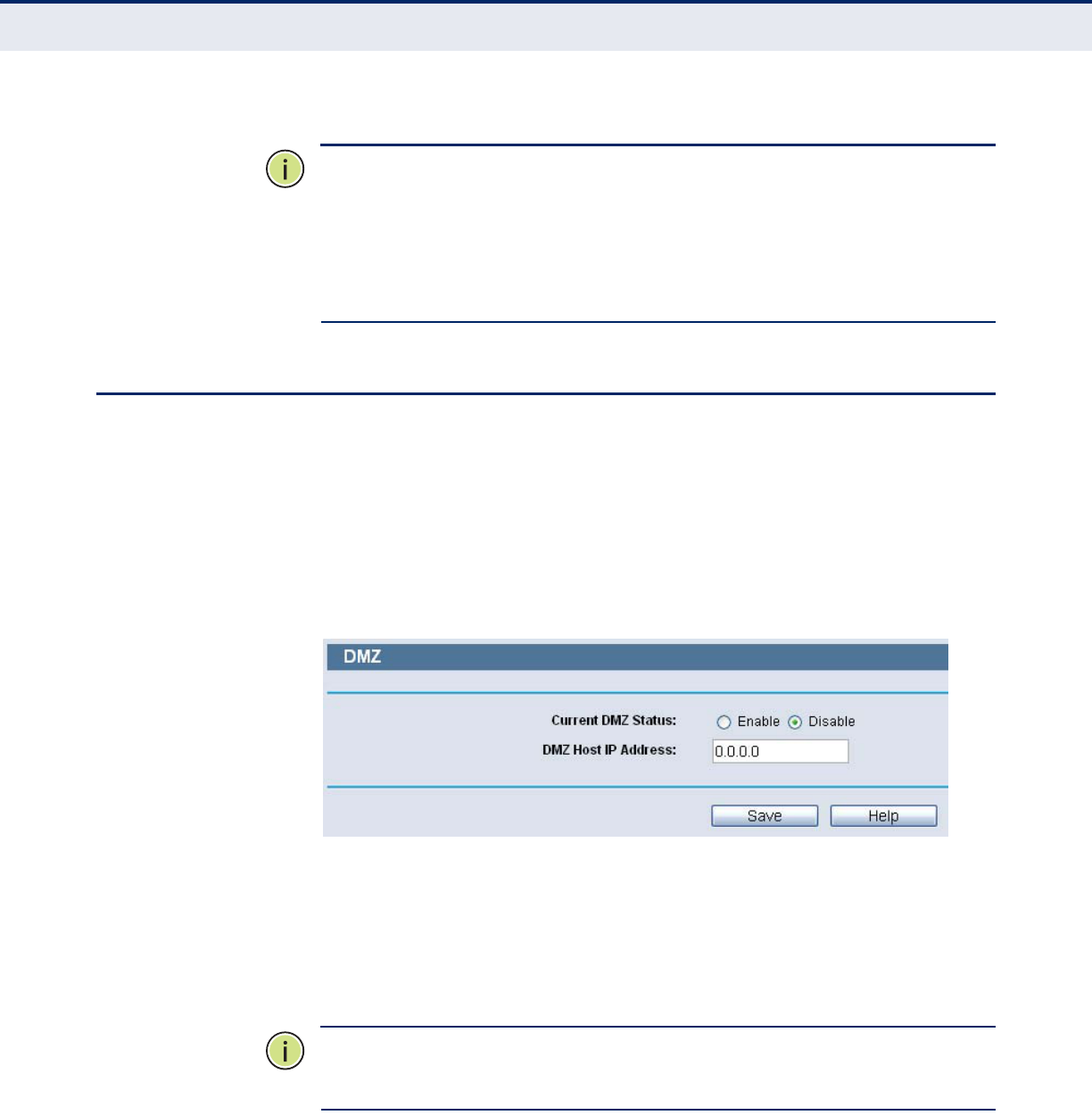
C
HAPTER
9
| Special Application Settings
DMZ
– 77 –
Click the Delete All button to delete all entries
N
OTE
:
1. When the trigger connection is released, the according opening
ports will be closed.
2. Each rule allowed to be used only by one host on LAN synchronously.
The trigger connection of other hosts on LAN will be refused.
3. Incoming Port Range cannot overlap each other.
DMZ
Choose menu “Special Application->DMZ”, you can view and configure
DMZ host in the screen. The DMZ host feature allows one local host to be
exposed to the Internet for a special-purpose service such as Internet
gaming or videoconferencing. DMZ host forwards all the ports at the same
time. Any PC whose port is being forwarded must have its DHCP client
function disabled and should have a new static IP Address assigned to it
because its IP Address may be changed when using the DHCP function.
Figure 68: DMZ Settings
To assign a computer or server to be a DMZ server:
1. Click the Enable radio button
2. Enter the local host IP Address in the DMZ Host IP Address field
3. Click the Save button.
N
OTE
:
After you set the DMZ host, the firewall related to the host will not
work.
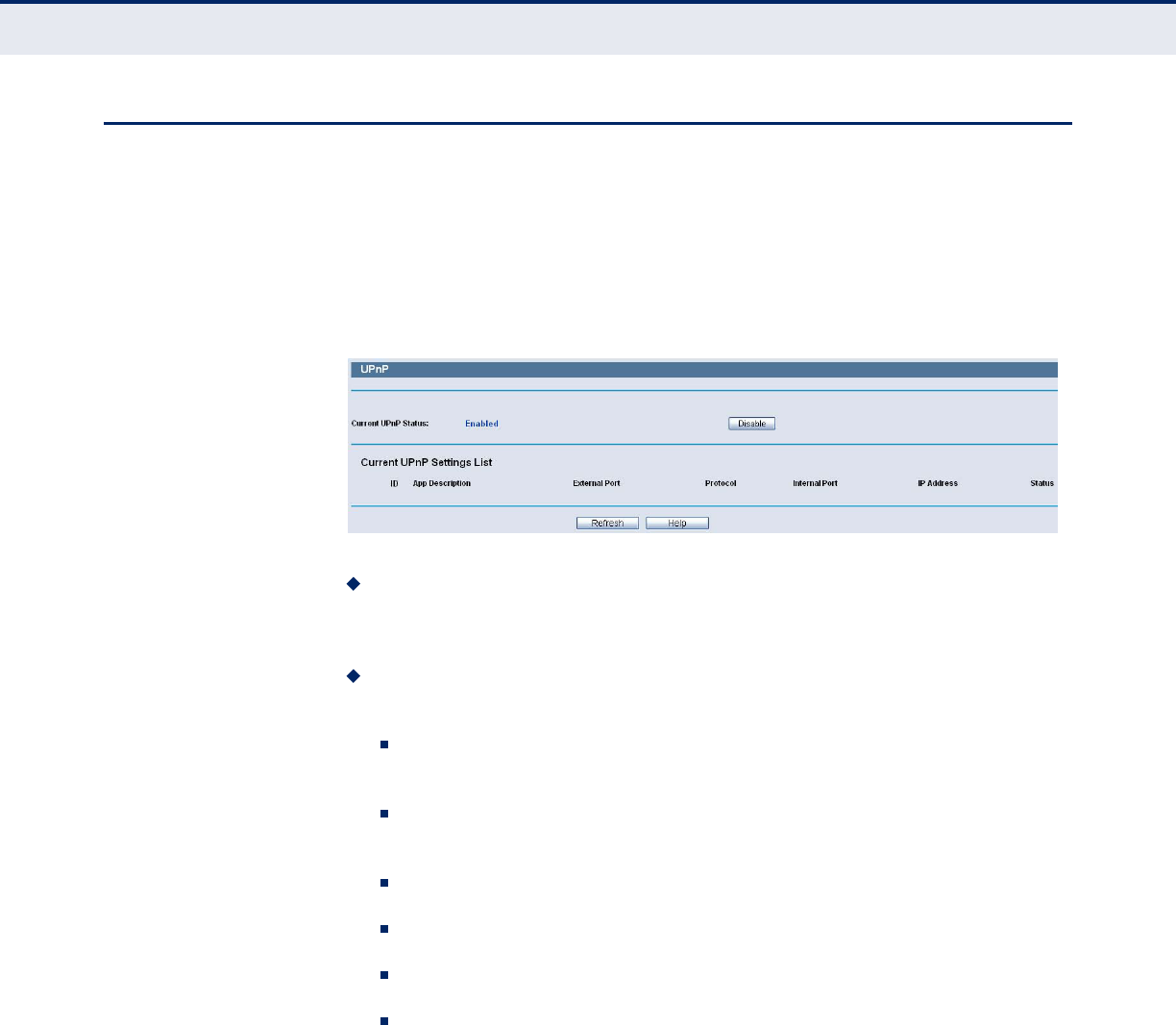
C
HAPTER
9
| Special Application Settings
UPnP
– 78 –
UPNP
Choose menu “Special Application->UPnP”, you can view the information
about UPnP(Universal Plug and Play) in the screen. The UPnP feature allows
the devices, such as Internet computers, to access the local host resources
or devices as needed. UPnP devices can be automatically discovered by the
UPnP service application on the LAN.
Figure 69: UPnP Settings
Current UPnP Status - UPnP can be enabled or disabled by clicking
the Enable or Disable button. As allowing this may present a risk to
security, this feature is enabled by default.
Current UPnP Settings List - This table displays the current UPnP
information.
App Description -The description provided by the application in the
UPnP request
External Port - External port, which the router opened for the
application.
Protocol - Shows which type of protocol is opened.
Internal Port - Internal port, which the router opened for local host.
IP Address - The UPnP device that is currently accessing the router.
Status - The port’s status displayed here. “Enabled” means that port
is still active. Otherwise, the port is inactive.
Click Refresh to update the Current UPnP Settings List.
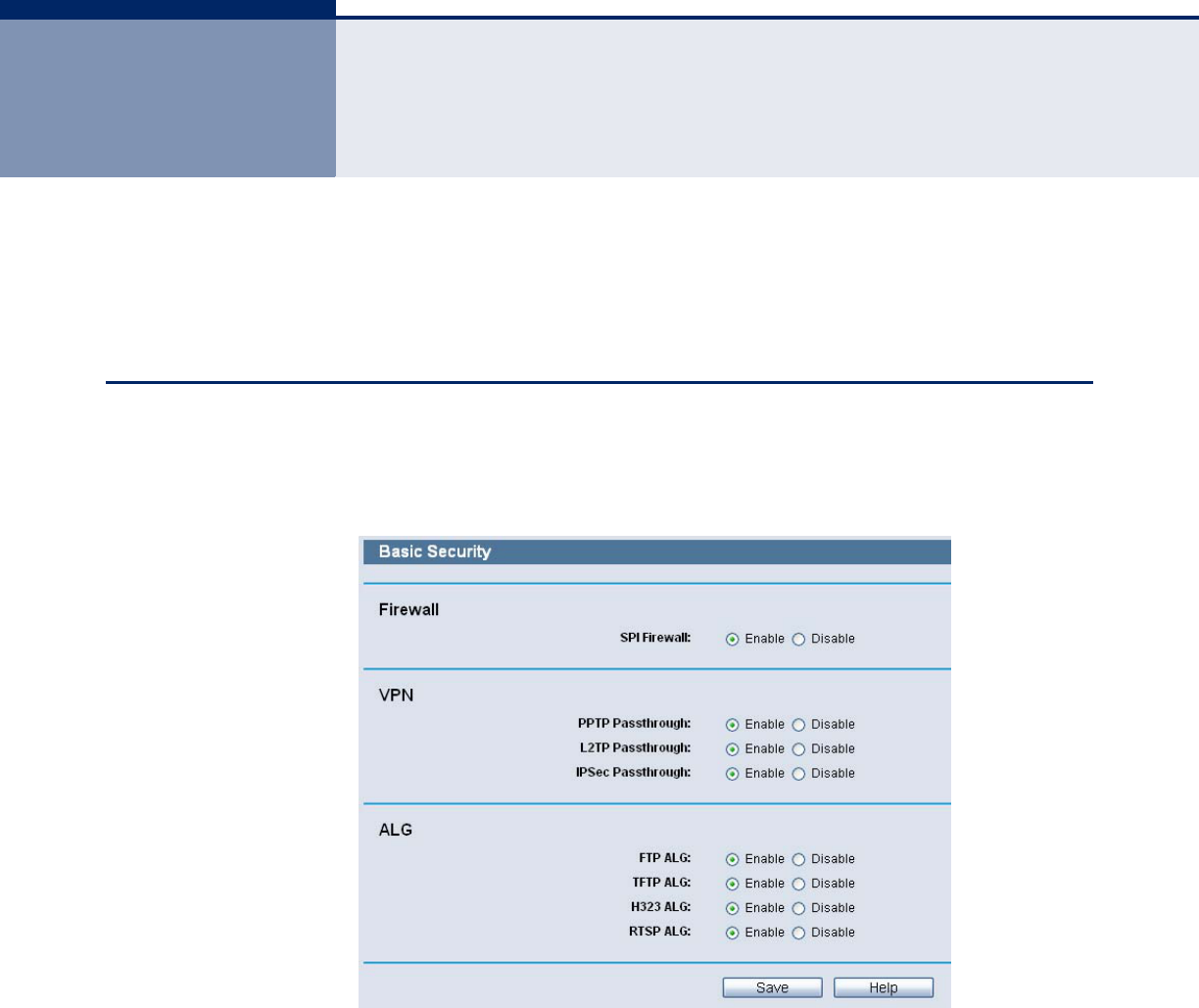
– 79 –
10 SECURITY SETTINGS
There are two submenus under the Security menu: Basic Security, and
Advanced Security. Click any of them, and you will be able to configure the
corresponding function.
BASIC SECURITY
Choose menu “Security->Basic Security”, you can configure the basic
security in the following screen.
Figure 70: Basic Security Settings
◆Firewall - A firewall protects your network from the outside world.
Here you can enable or disable the Router’s firewall.
■SPI Firewall - SPI (Stateful Packet Inspection, also known as
dynamic packet filtering) helps to prevent cyber attacks by tracking
more state per session. It validates that the traffic passing through
the session conforms to the protocol. SPI Firewall is enabled by
factory default. If you want all the computers on the LAN exposed
to the outside world, you can disable it.
◆VPN - VPN Passthrough must be enabled if you want to allow VPN
tunnels using IPSec, PPTP, or L2TP protocols to pass through the
Router’s firewall.

C
HAPTER
10
| Security Settings
Basic Security
– 80 –
■PPTP Passthrough - Point-to-Point Tunneling Protocol (PPTP) allows
the Point-to-Point Protocol (PPP) to be tunneled through an IP
network. To allow PPTP tunnels to pass through the Router, keep the
default, Enabled.
■L2TP Passthrough - Layer 2 Tunneling Protocol (L2TP) is the method
used to enable Point-to-Point sessions via the Internet on the Layer
2 level. To allow L2TP tunnels to pass through the Router, keep the
default, Enabled.
■IPSec Passthrough - Internet Protocol Security (IPSec) is a suite of
protocols for ensuring private, secure communications over Internet
Protocol (IP) networks, through the use of cryptographic security
services. To allow IPSec tunnels to pass through the Router, keep
the default, Enabled.
◆ALG - It is recommended to enable Application Layer Gateway (ALG)
because ALG allows customized Network Address Translation (NAT)
traversal filters to be plugged into the gateway to support address and
port translation for certain application layer "control/data" protocols
such as FTP, TFTP, H323 etc.
■FTP ALG - To allow FTP clients and servers to transfer data across
NAT, keep the default Enable.
■TFTP ALG - To allow TFTP clients and servers to transfer data across
NAT, keep the default Enable.
■H323 ALG - To allow Microsoft NetMeeting clients to communicate
across NAT, keep the default Enable.
Click the Save button to save your settings.
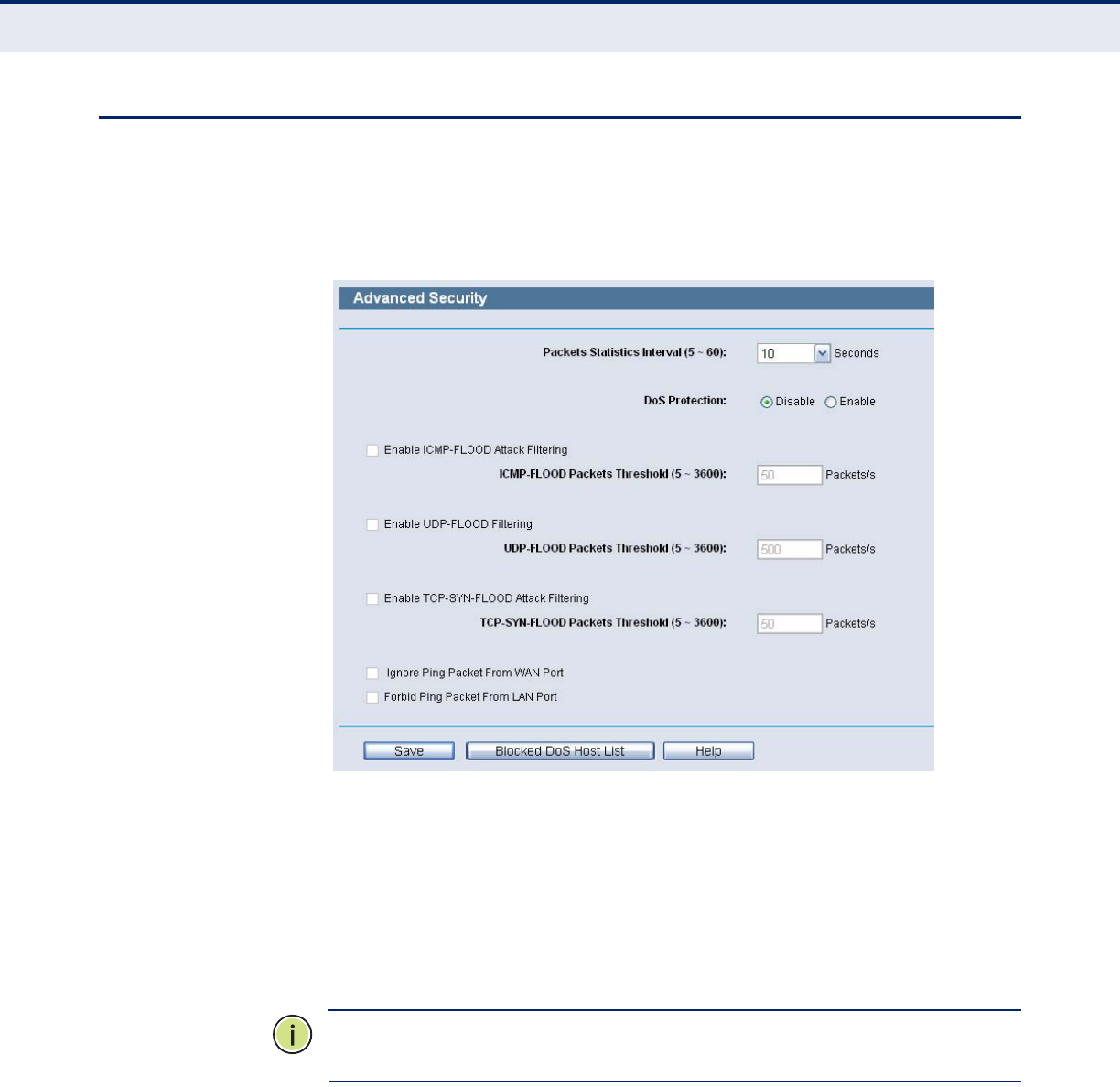
C
HAPTER
10
| Security Settings
Advanced Security
– 81 –
ADVANCED SECURITY
Choose menu “Security->Advanced Security”, you can protect the Router
from being attacked by TCP-SYN Flood, UDP Flood and ICMP-Flood in the
following screen.
Figure 71: Advanced Security Settings
◆Packets Statistics Interval (5~60) - The default value is 10. Select
a value between 5 and 60 seconds from the drop-down list. The Packets
Statistics Interval value indicates the time section of the packets
statistics. The result of the statistics is used for analysis by SYN Flood,
UDP Flood and ICMP-Flood.
◆DoS Protection - Denial of Service protection. Check the Enable or
Disable button to enable or disable the DoS protection function. Only
when it is enabled, will the flood filters be enabled.
N
OTE
:
Dos Protection will take effect only when the Traffic Statistics in
“System Tool->Traffic Statistics” is enabled.
◆Enable ICMP-FLOOD Attack Filtering - Enable or Disable the ICMP-
FLOOD Attack Filtering.
◆ICMP-FLOOD Packets Threshold (5~3600) - The default value is
50. Enter a value between 5 ~ 3600. When the current ICMP-FLOOD
Packets number is beyond the set value, the Router will startup the
blocking function immediately.

C
HAPTER
10
| Security Settings
Advanced Security
– 82 –
◆Enable UDP-FLOOD Filtering - Enable or Disable the UDP-FLOOD
Filtering.
◆UDP-FLOOD Packets Threshold (5~3600) - The default value is
500. Enter a value between 5 ~ 3600. When the current UPD-FLOOD
Packets number is beyond the set value, the Router will startup the
blocking function immediately.
◆Enable TCP-SYN-FLOOD Attack Filtering - Enable or Disable the
TCP-SYN-FLOOD Attack Filtering.
◆TCP-SYN-FLOOD Packets Threshold (5~3600) - The default value
is 50. Enter a value between 5 ~ 3600. When the current TCP-SYN-
FLOOD Packets numbers is beyond the set value, the Router will startup
the blocking function immediately.
◆Ignore Ping Packet From WAN Port - Enable or Disable Ignore Ping
Packet From WAN Port. The default setting is disabled. If enabled, the
ping packet from the Internet cannot access the Router.
◆Forbid Ping Packet From LAN Port - Enable or Disable Forbid Ping
Packet From LAN Port. The default setting is disabled. If enabled, the
ping packet from LAN cannot access the Router. This function can be
used to defend against some viruses.
Click the Save button to save the settings.
Click the Blocked DoS Host List button to display the DoS host table by
blocking.
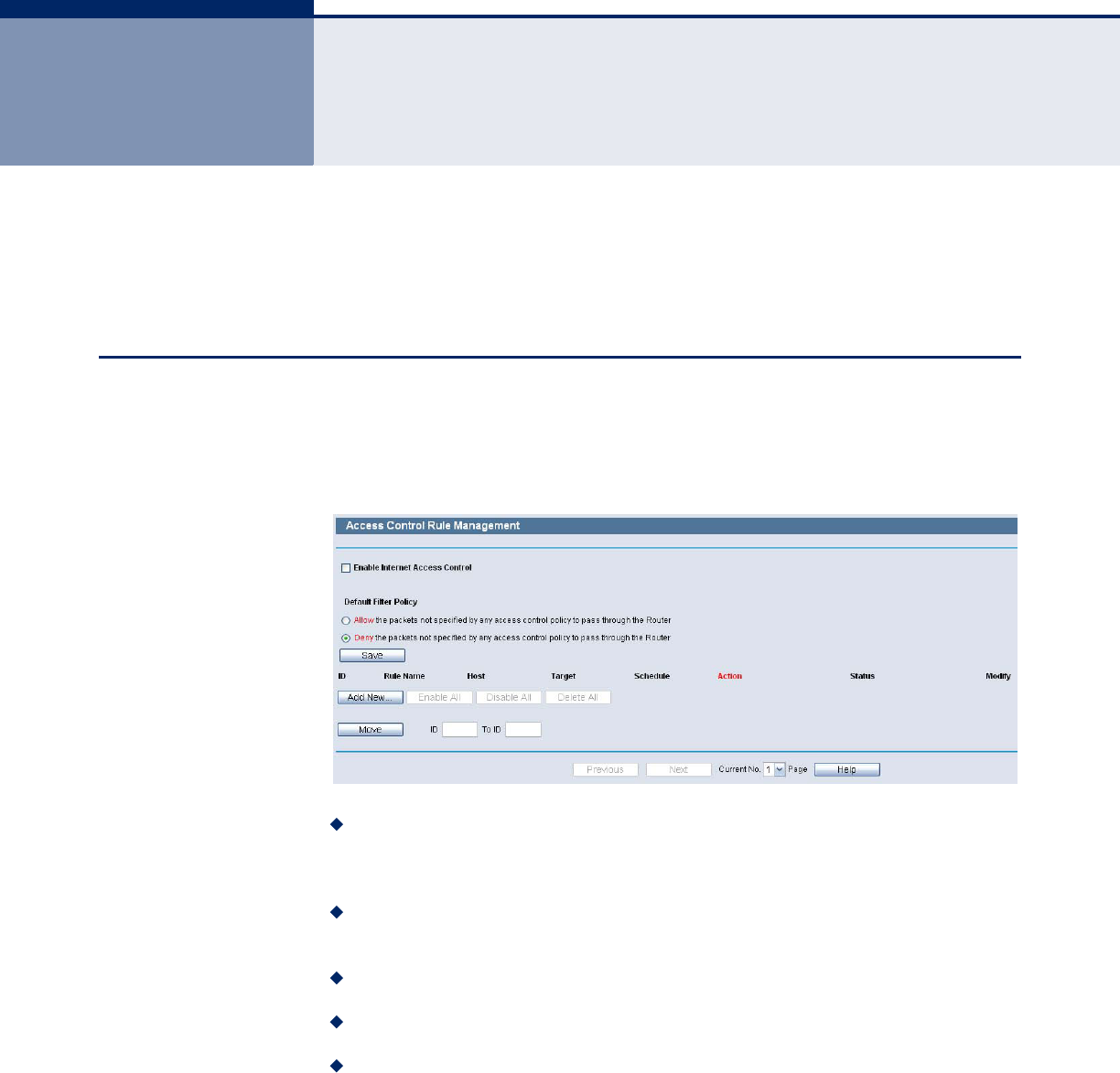
– 83 –
11 ACCESS CONTROL SETTINGS
There are five submenus under the Access Control menu: Rule, Host,
Target, Schedule and Parental Control. Click any of them, and you will be
able to configure the corresponding function.
RULE
Choose menu “Access Control->Rule”, you can view and set Access Control
rules in the screen as shown in the following.
Figure 72: Access Control Rule Management
Enable Internet Access Control - Select the check box to enable the
Internet Access Control function, so the Default Filter Policy can take
effect.
Rule Name - Here displays the name of the rule and this name is
unique.
Host - Here displays the host selected in the corresponding rule.
Target - Here displays the target selected in the corresponding rule.
Schedule - Here displays the schedule selected in the corresponding
rule.

C
HAPTER
11
| Access Control Settings
Rule
– 84 –
◆Action - Here displays the action the Router takes to deal with the
packets. It could be Allow or Deny. Allow means that the Router permits
the packets to go through the Router. Deny means that the Router
rejects the packets to go through the Router.
◆Status - This field displays the status of the rule. Enabled means the
rule will take effect, Disabled means the rule will not take effect.
◆Modify - Here you can edit or delete an existing rule.
To add a new rule, please follow the steps below.
1. Click the Add New button and the next screen will pop-up.
2. Give a name (e.g. Rule_1) for the rule in the Rule Name field.
3. Select a host from the Host drop-down list or choose “Click Here To Add
New Host List”.
4. Select a target from the Target drop-sown list or choose “Click Here To
Add New Target List”.
5. Select a schedule from the Schedule drop-down list or choose “Click
Here To Add New Schedule”.
6. In the Action field, select Deny or Allow.
7. In the Status field, select Enabled or Disabled to enable or disable your
entry.
Click the Save button.
Click the Enable All button to enable all the rules in the list.
Click the Disable All button to disable all the rules in the list.
Click the Delete All button to delete all the entries in the table.
You can change the entry’s order as desired. Fore entries are before hind
entries. Enter the ID number in the first box you want to move and another
ID number in second box you want to move to, and then click the Move
button to change the entry’s order.
Click the Next button to go to the next page, or click the Previous button
return to the previous page.
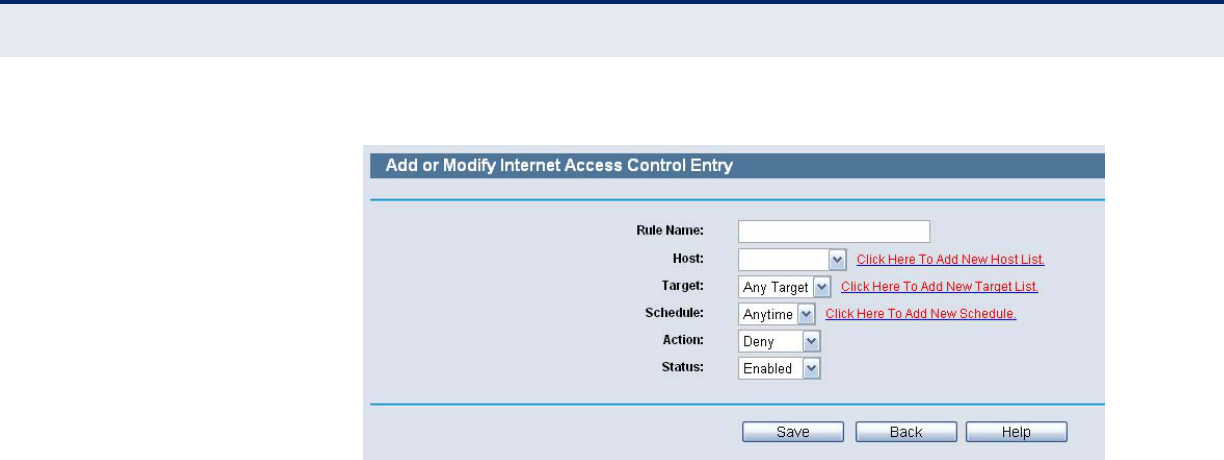
C
HAPTER
11
| Access Control Settings
Rule
– 85 –
Figure 73: Add or Modity Internet Access Control Entry
For example: If you desire to allow the host with MAC address 00-11-22-
33-44-AA to access www.google.com only from 18:00 to 20:00 on
Saturday and Sunday, and forbid other hosts in the LAN to access the
Internet, you should follow the settings below:
1. Click “Access Control->Host” in the left to enter the Host Settings page.
Add a new entry with the Host Description is Host_1 and MAC Address
is 00-11-22-33-44-AA.
2. Click “Access Control->Target” in the left to enter the Target Settings
page. Add a new entry with the Target Description is Target_1 and
Domain Name is www.google.com.
3. Click “Access Control->Schedule” in the left to enter the Schedule
Settings page. Add a new entry with the Schedule Description is
Schedule_1, Day is Sat and Sun, Start Time is 1800 and Stop Time is
2000.
4. Click “Access Control->Rule” in the left to return to the Access Control
Rule Management page. Select “Enable Internet Access Control” and
choose "Deny the packets not specified by any access control policy to
pass through the Router".
5. Click the Add New button to add a new rule as follows:
■In Rule Name field, create a name for the rule. Note that this name
should be unique, for example Rule_1.
■In Host field, select Host_1.
■In Target field, select Target_1.
■In Schedule field, select Schedule_1.
■In Action field, select Allow.
■In Status field, select Enable.
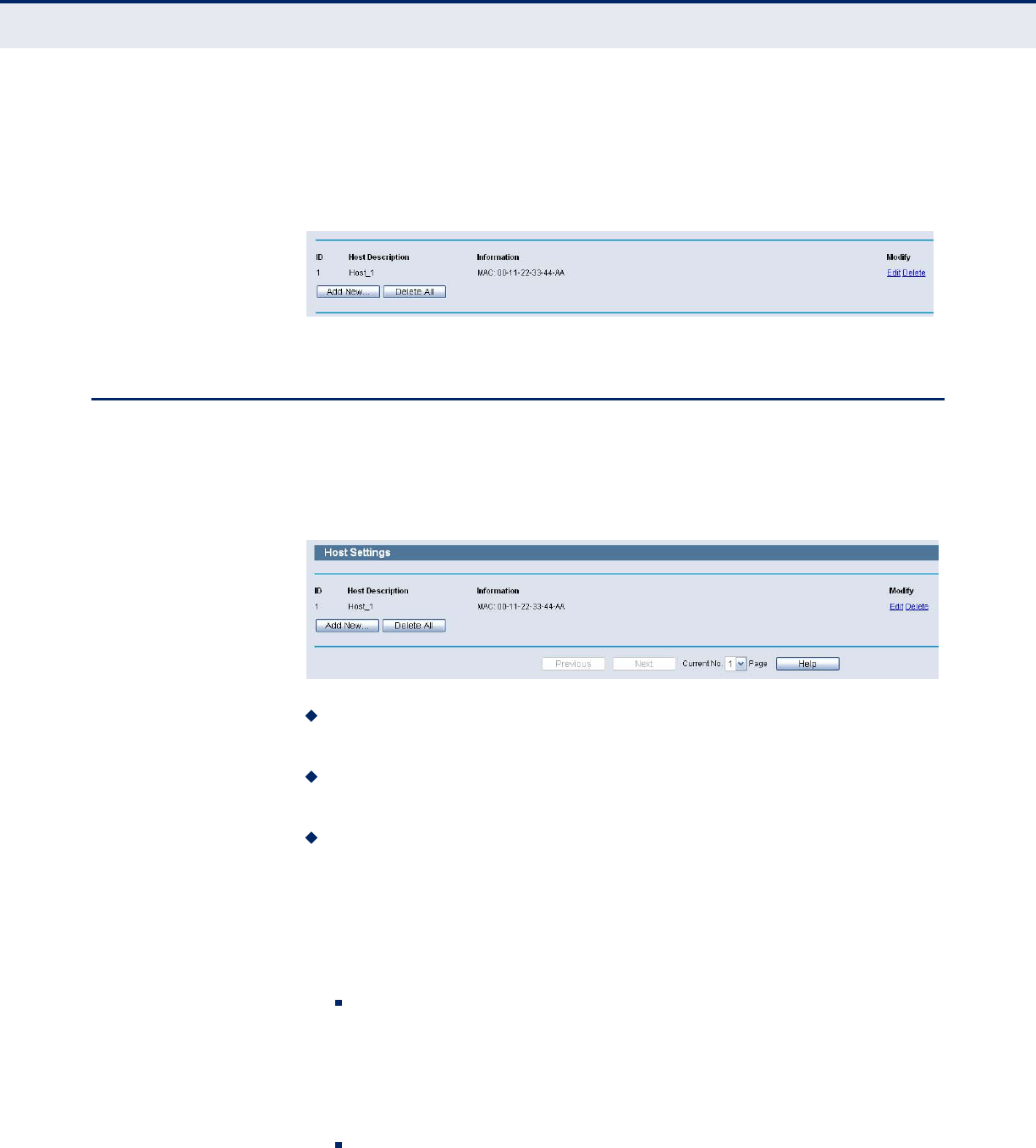
C
HAPTER
11
| Access Control Settings
Host
– 86 –
■Click Save to complete the settings.
Then you will go back to the Access Control Rule Management page and
see the following list.
Figure 74: Display Access Control Entry
HOST
Choose menu “Access Control->Host”, you can view and set a Host list in
the following screen. The host list is necessary for the Access Control Rule.
Figure 75: Host Settings
Host Description - Here displays the description of the host and this
description is unique.
Information - Here displays the information about the host. It can be
IP or MAC.
Modify - To modify or delete an existing entry.
To add a new entry, please follow the steps below.
1. Click the Add New button.
2. In the Mode field, select IP Address or MAC Address.
If you select IP Address, the screen shown is Figure 75.
1) In Host Description field, create a unique description for the host
(e.g. Host_1).
2) In LAN IP Address field, enter the IP address.
If you select MAC Address, the screen shown is Figure 76.
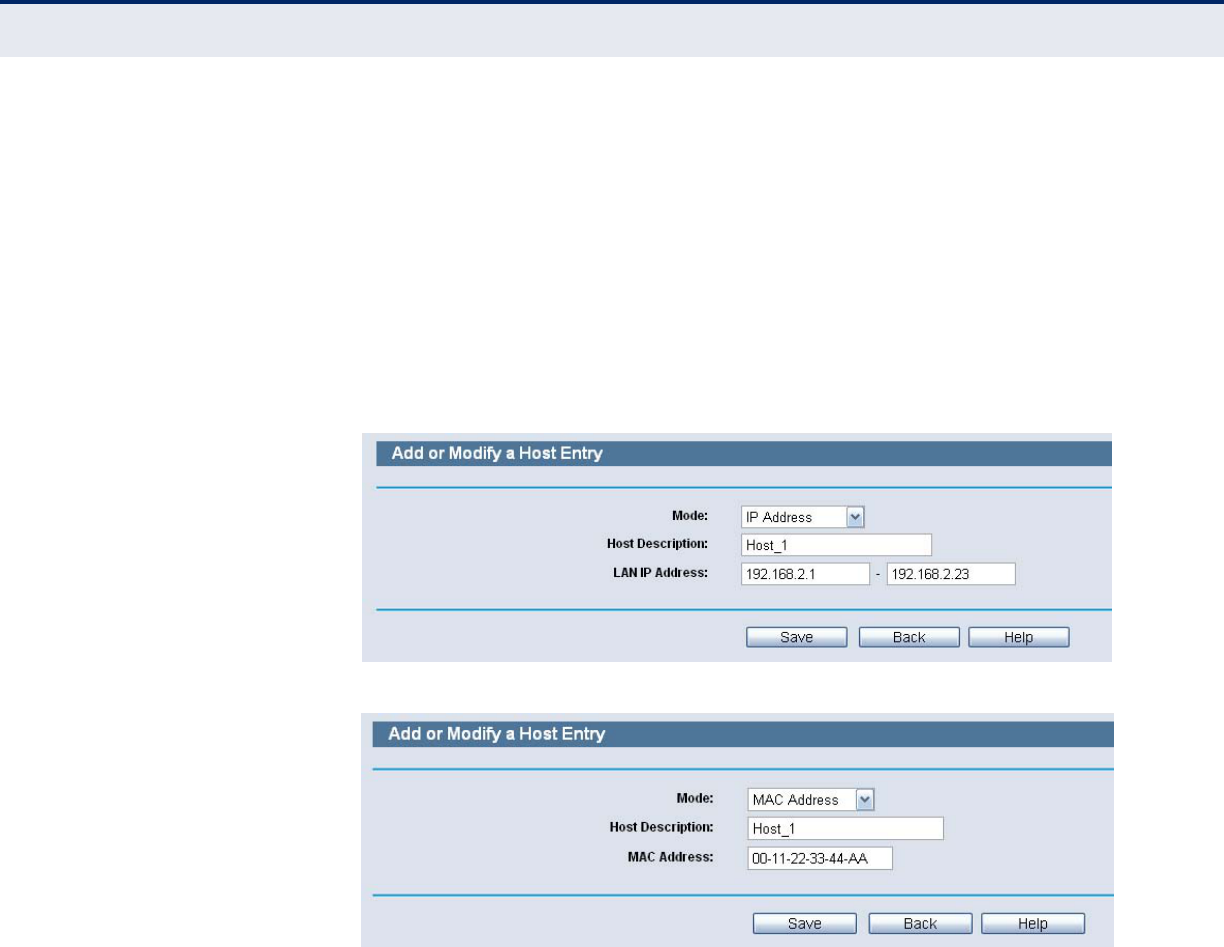
C
HAPTER
11
| Access Control Settings
Host
– 87 –
1) In Host Description field, create a unique description for the host
(e.g. Host_1).
2) In MAC Address field, enter the MAC address.
3. Click the Save button to complete the settings.
Click the Delete All button to delete all the entries in the table.
Click the Next button to go to the next page, or click the Previous button
return to the previous page.
Figure 76: Host Entry IP address Mode
Figure 77: Host Entry MAC address Mode
For example: If you desire to restrict the internet activities of host with
MAC address 00-11-22-33-44-AA, you should first follow the settings
below:
1. Click the Add New button.
2. In Mode field, select MAC Address from the drop-down list.
3. In Host Description field, create a unique description for the host (e.g.
Host_1).
4. In MAC Address field, enter 00-11-22-33-44-AA.
5. Click Save to complete the settings.
Then you will go back to the Host Settings page and see the following list.
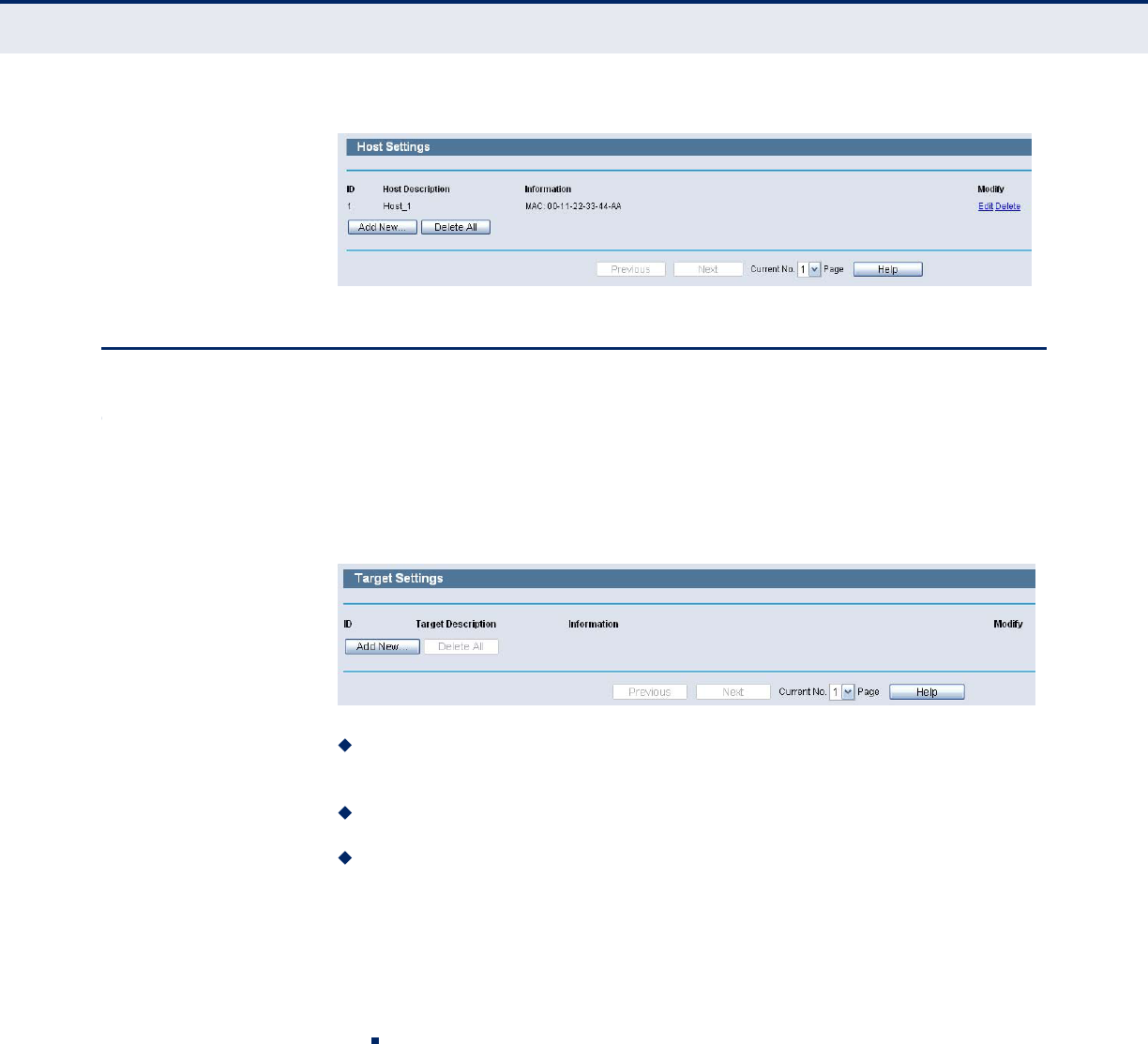
C
HAPTER
11
| Access Control Settings
Target
– 88 –
Figure 78: Host Settings
TARGET
Choose menu “Access Control->Target”, you can view and set a Target list
in the screen as shown in the following figure. The target list is necessary
for the Access Control Rule.
Figure 79: Target Settings
Target Description - Here displays the description about the target
and this description is unique.
Information - The target can be IP address, port, or domain name.
Modify - To modify or delete an existing entry.
To add a new entry, please follow the steps below.
1. Click the Add New button.
2. In Mode field, select IP Address or Domain Name.
If you select IP Address, the screen shown is Figure 79.
1) In Target Description field, create a unique description for the
target (e.g. Target_1).
2) In IP Address field, enter the IP address of the target.
3) Select a common service from Common Service Port drop-down
list, so that the Target Port will be automatically filled. If the
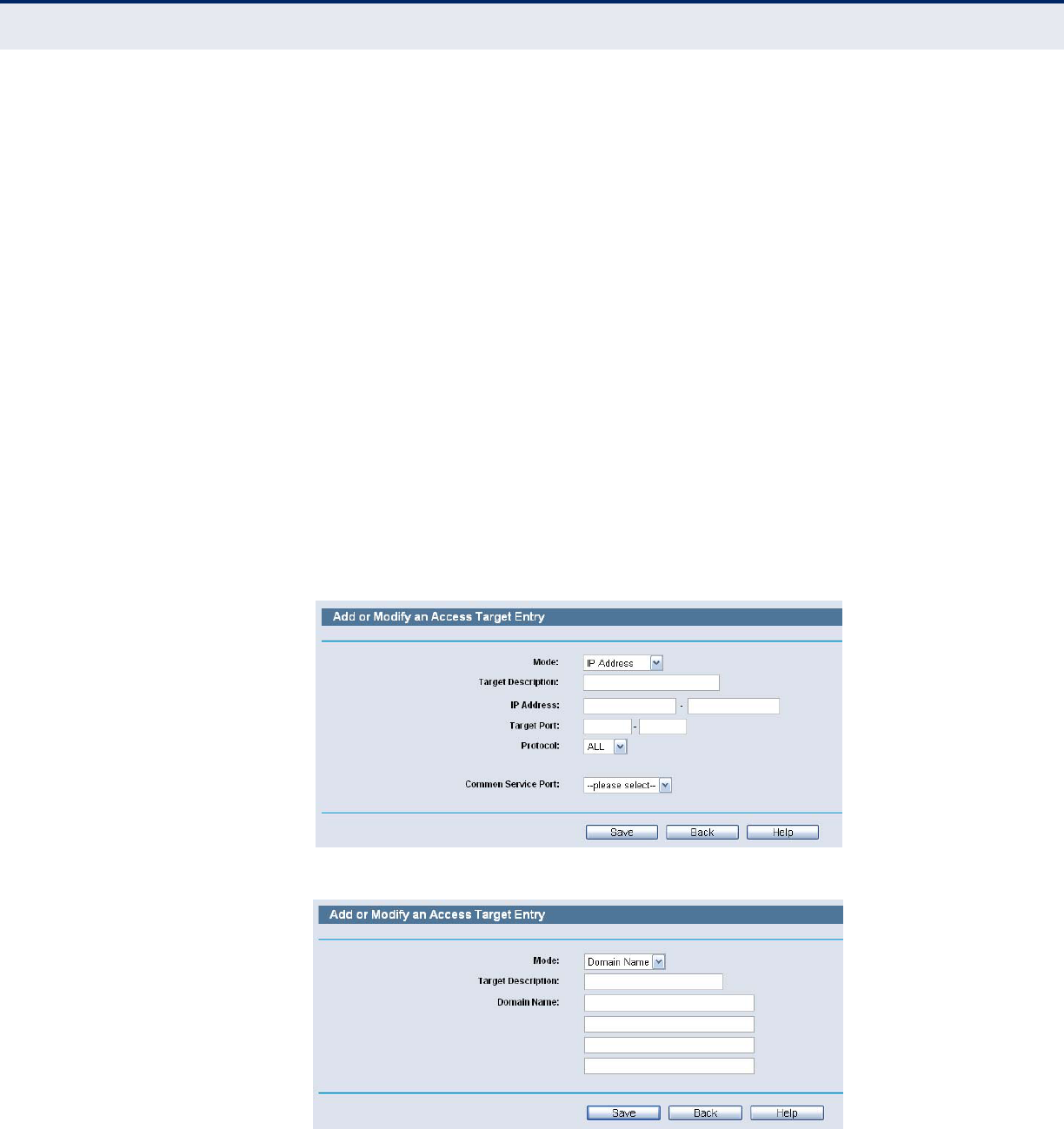
C
HAPTER
11
| Access Control Settings
Target
– 89 –
Common Service Port drop-down list doesn’t have the service you
want, specify the Target Port manually.
4) In Protocol field, select TCP, UDP, ICMP or ALL.
■If you select Domain Name, the screen shown is Figure 80.
1) In Target Description field, create a unique description for the
target (e.g. Target_1).
2) In Domain Name field, enter the domain name, either the full
name or the keywords (for example google) in the blank. Any
domain name with keywords in it (www.google.com,
www.google.cn) will be blocked or allowed. You can enter 4 domain
names.
3. Click the Save button.
Click the Delete All button to delete all the entries in the table.
Click the Next button to go to the next page, or click the Previous button
return to the previous page.
Figure 80: Target Settings-IP Address Mode
Figure 81: Target Settings-Domain Name Mode
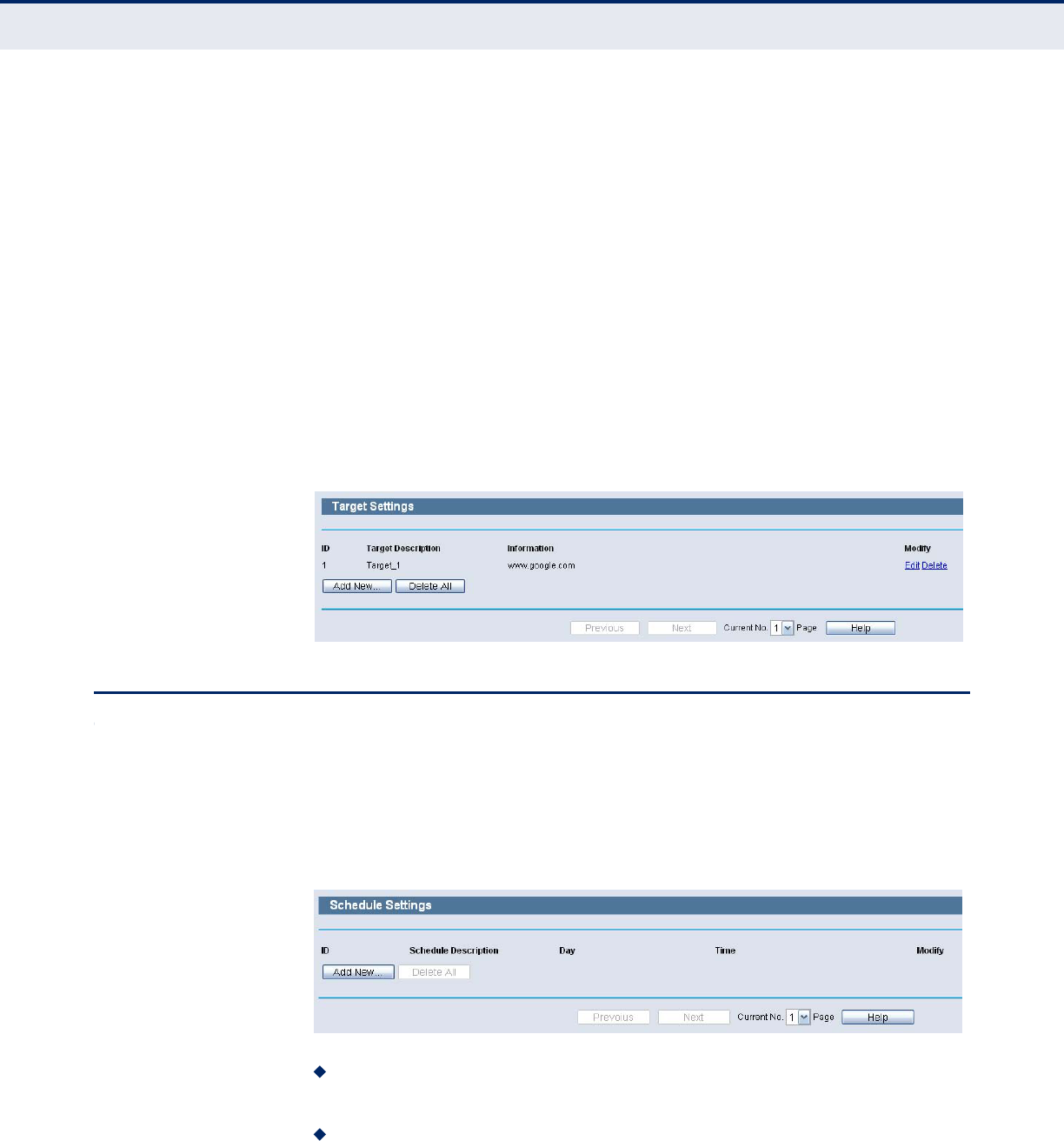
C
HAPTER
11
| Access Control Settings
Schedule
– 90 –
For example: If you desire to restrict the internet activities of host with
MAC address 00-11-22-33-44-AA in the LAN to access www.google.com
only, you should first follow the settings below:
1. Click the Add New button.
2. In Mode field, select Domain Name from the drop-down list.
3. In Target Description field, create a unique description for the target
(e.g. Target_1).
4. In Domain Name field, enter www.google.com.
5. Click Save to complete the settings.
Then you will go back to the Target Settings page and see the following list.
Figure 82: Target Settings-Domain Name Mode
SCHEDULE
Choose menu “Access Control->Schedule”, you can view and set a
Schedule list in the next screen as shown in the following figure. The
Schedule list is necessary for the Access Control Rule.
Figure 83: Schedule Settings
Schedule Description - Here displays the description of the schedule
and this description is unique.
Day - Here displays the day(s) in a week.
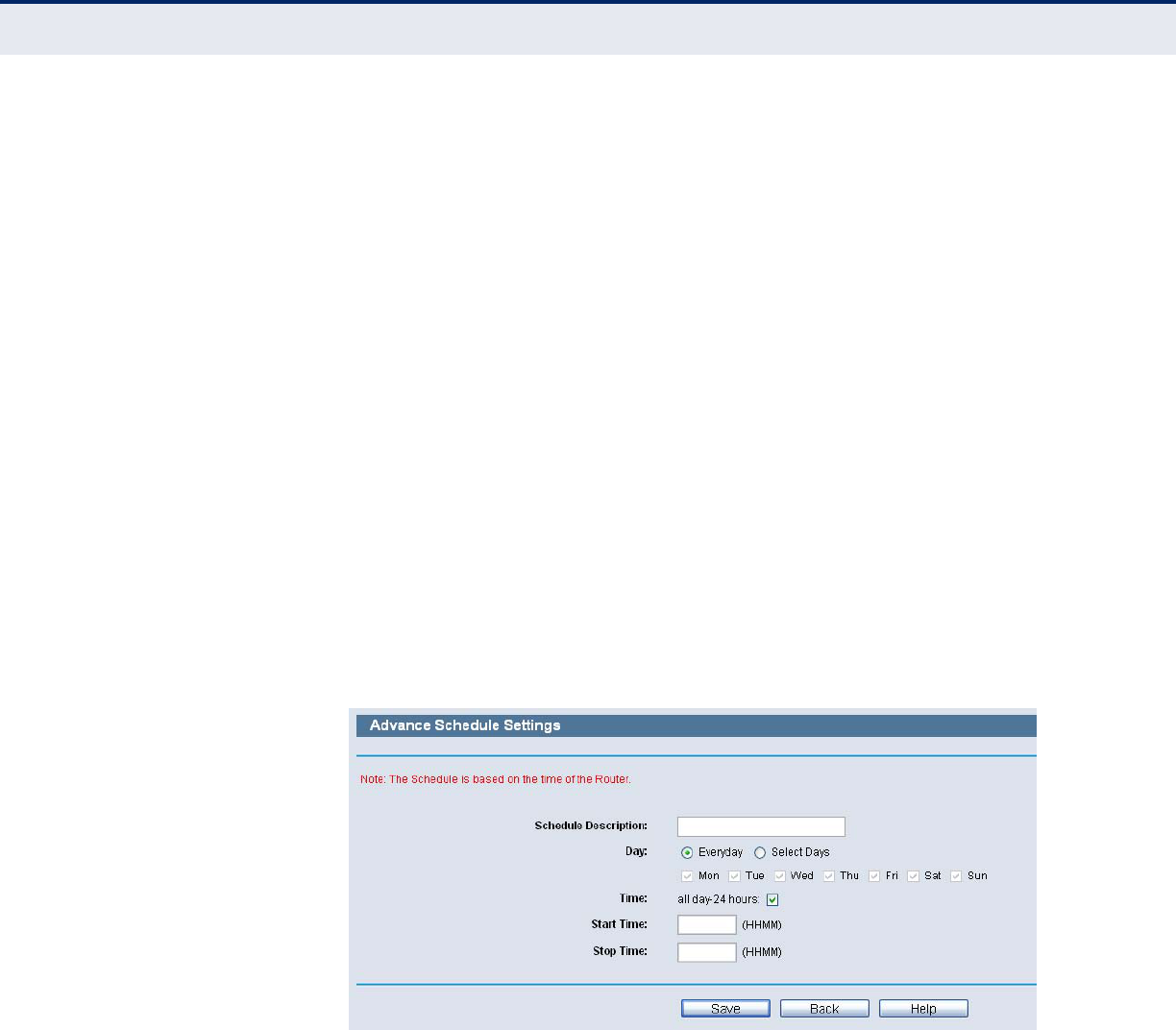
C
HAPTER
11
| Access Control Settings
Schedule
– 91 –
◆Time - Here displays the time period in a day.
◆Modify - Here you can edit or delete an existing schedule.
To add a new schedule, follow the steps below.
1. Click the Add New button shown in Figure 82 and the next screen will
pop-up.
2. In Schedule Description field, create a unique description for the
schedule (e.g. Schedule_1).
3. In Day field, select the day or days you need.
4. In Time field, you can select all day-24 hours or you may enter the
Start Time and Stop Time in the corresponding field.
5. Click Save to complete the settings.
Click the Delete All button to delete all the entries in the table.
Click the Next button to go to the next page, or click the Previous button
return to the previous page.
Figure 84: Advanced Schedule Settings
For example: If you desire to restrict the internet activities of host with
MAC address 00-11-22-33-44-AA to access www.google.com only from
18:00 to 20:00 on Saturday and Sunday, you should first follow the
settings below:
1. Click the Add New button.
2. In Schedule Description field, create a unique description for the
schedule (e.g. Schedule_1).
3. In Day field, check the Select Days radio button and then select Sat and
Sun.
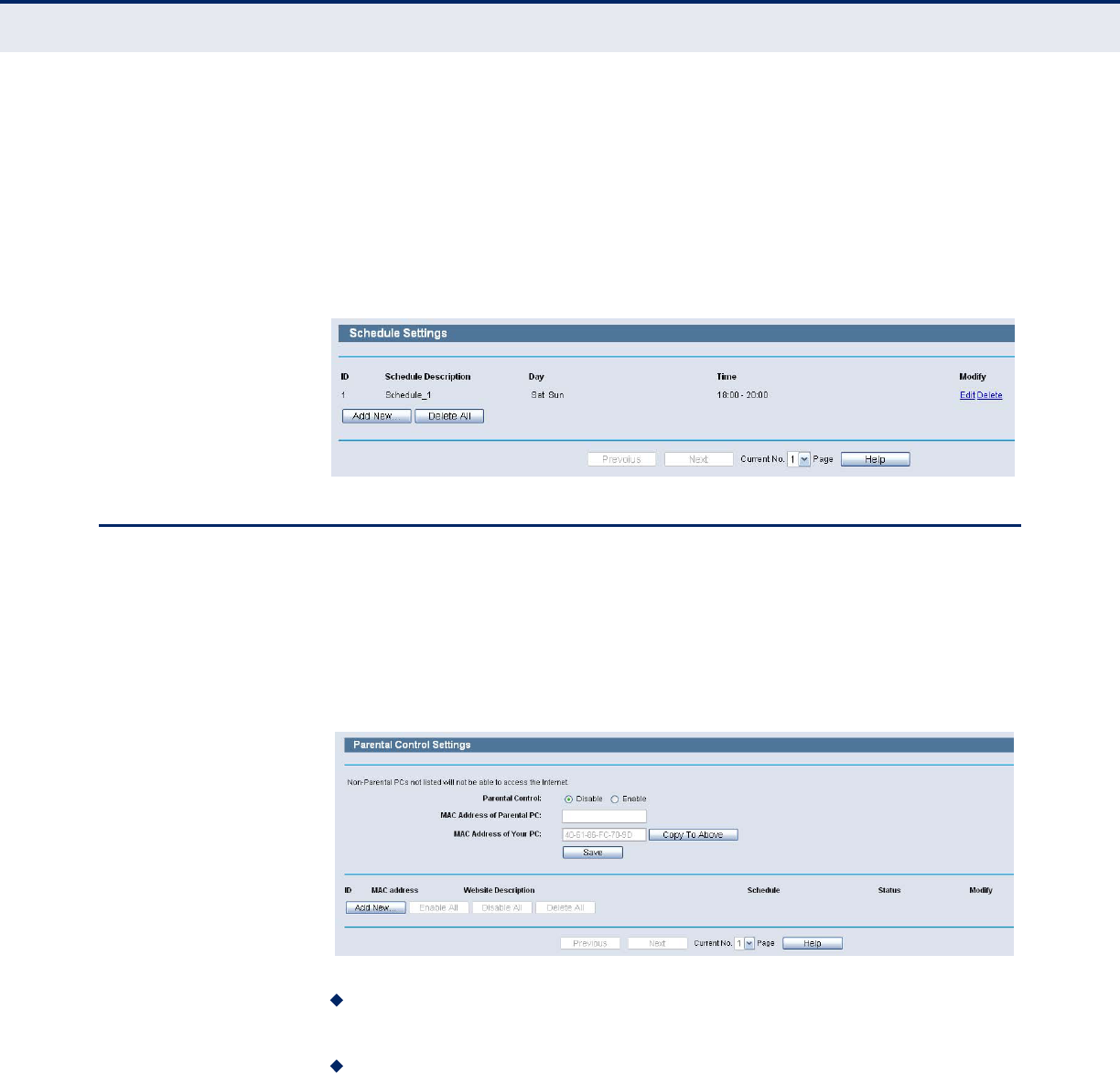
C
HAPTER
11
| Access Control Settings
Parental Control
– 92 –
4. In Time field, enter 1800 in Start Time field and 2000 in Stop Time
field.
5. Click Save to complete the settings.
Then you will go back to the Schedule Settings page and see the following
list.
Figure 85: Schedule Settings
PARENTAL CONTROL
Choose menu “Parental Control”, and you can configure the parental
control in the screen as shown in the following figure. The Parental Control
function can be used to control the internet activities of the child, limit the
child to access certain websites and restrict the time of surfing.
Figure 86: Parental Control Settings
Parental Control - Check Enable if you want this function to take
effect, otherwise check Disable.
MAC Address of Parental PC - In this field, enter the MAC address of
the controlling PC, or you can make use of the Copy To Above button
below.

C
HAPTER
11
| Access Control Settings
Parental Control
– 93 –
◆MAC Address of Your PC - This field displays the MAC address of the
PC that is managing this Router. If the MAC Address of your adapter is
registered, you can click the Copy To Above button to fill this address to
the MAC Address of Parental PC field above.
◆Website Description - Description of the allowed website for the PC
controlled.
◆Schedule - The time period allowed for the PC controlled to access the
Internet. For detailed information, please go to “Access Control ?
Schedule”.
◆Modify - Here you can edit or delete an existing entry.
To add a new entry, please follow the steps below.
1. Click the Add New button.
2. Enter the MAC address of the PC (e.g. 00-11-22-33-44-AA) you’d like
to control in the MAC Address of Child PC field. Or you can choose the
MAC address from the All Address in Current LAN drop-down list.
3. Give a description (e.g. Allow Google) for the website allowed to be
accessed in the Website Description field.
4. Enter the allowed domain name of the website, either the full name or
the keywords (e.g. google) in the Allowed Domain Name field. Any
domain name with keywords in it (www.google.com.cn) will be allowed.
5. Select from the Effective Time drop-down list the schedule (e.g.
Schedule_1) you want the entry to take effect. If there are not suitable
schedules for you, click the Schedule in red below to go to the Advance
Schedule Settings page and create the schedule you need.
6. In the Status field, you can select Enabled or Disabled to enable or
disable your entry.
7. Click the Save button.
Click the Enable All button to enable all the rules in the list.
Click the Disable All button to disable all the rules in the list.
Click the Delete All button to delete all the entries in the table.
Click the Next button to go to the next page, or click the Previous button
return to the previous page.
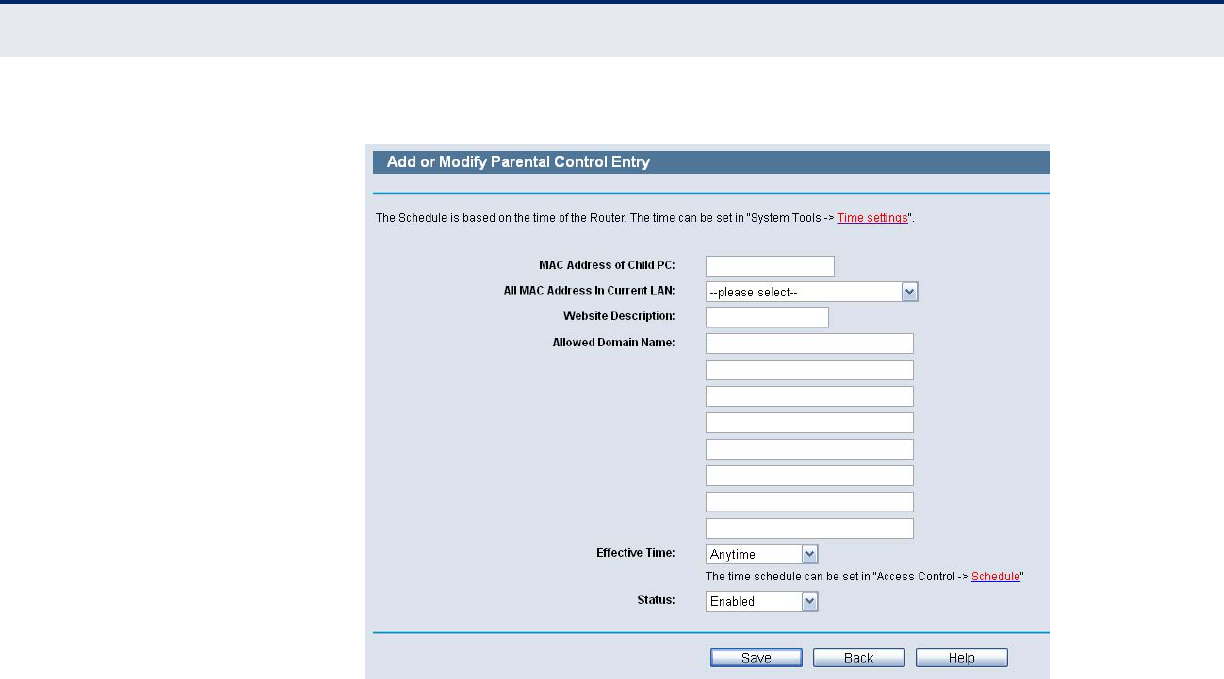
C
HAPTER
11
| Access Control Settings
Parental Control
– 94 –
Figure 87: Add or Modify Parental Control Entry
For example: If you desire that the child PC with MAC address 00-11-22-
33-44-AA can access www.google.com on Saturday only while the parent
PC with MAC address 00-11-22-33-44-BB is without any restriction, you
should follow the settings below.
1. Click “Parental Control” menu on the left to enter the Parental Control
Settings page. Check Enable and enter the MAC address 00-11-22-33-
44-BB in the MAC Address of Parental PC field.
2. Click “Access Control->Schedule” on the left to enter the Schedule
Settings page. Clickthe Add New button to create a new schedule with
Schedule Description is Schedule_1, Day is Sat and Time is all day-24
hours.
3. Click “Parental Control” menu on the left to go back to the Add or
Modify Parental Control Entry page:
■Click the Add New button.
■Enter 00-11-22-33-44-AA in the MAC Address of Child PC field.
■Enter “Allow Google” in the Website Description field.
■Enter “www.google.com” in the Allowed Domain Name field.
■Select “Schedule_1” you create just now from the Effective Time
drop-down list.
■In Status field, select Enable.

C
HAPTER
11
| Access Control Settings
Parental Control
– 95 –
4. Click Save to complete the settings.
Then you will go back to the Parental Control Settings page and see the
following list, as shown in the following figure.
Figure 88: Parental Control Settings
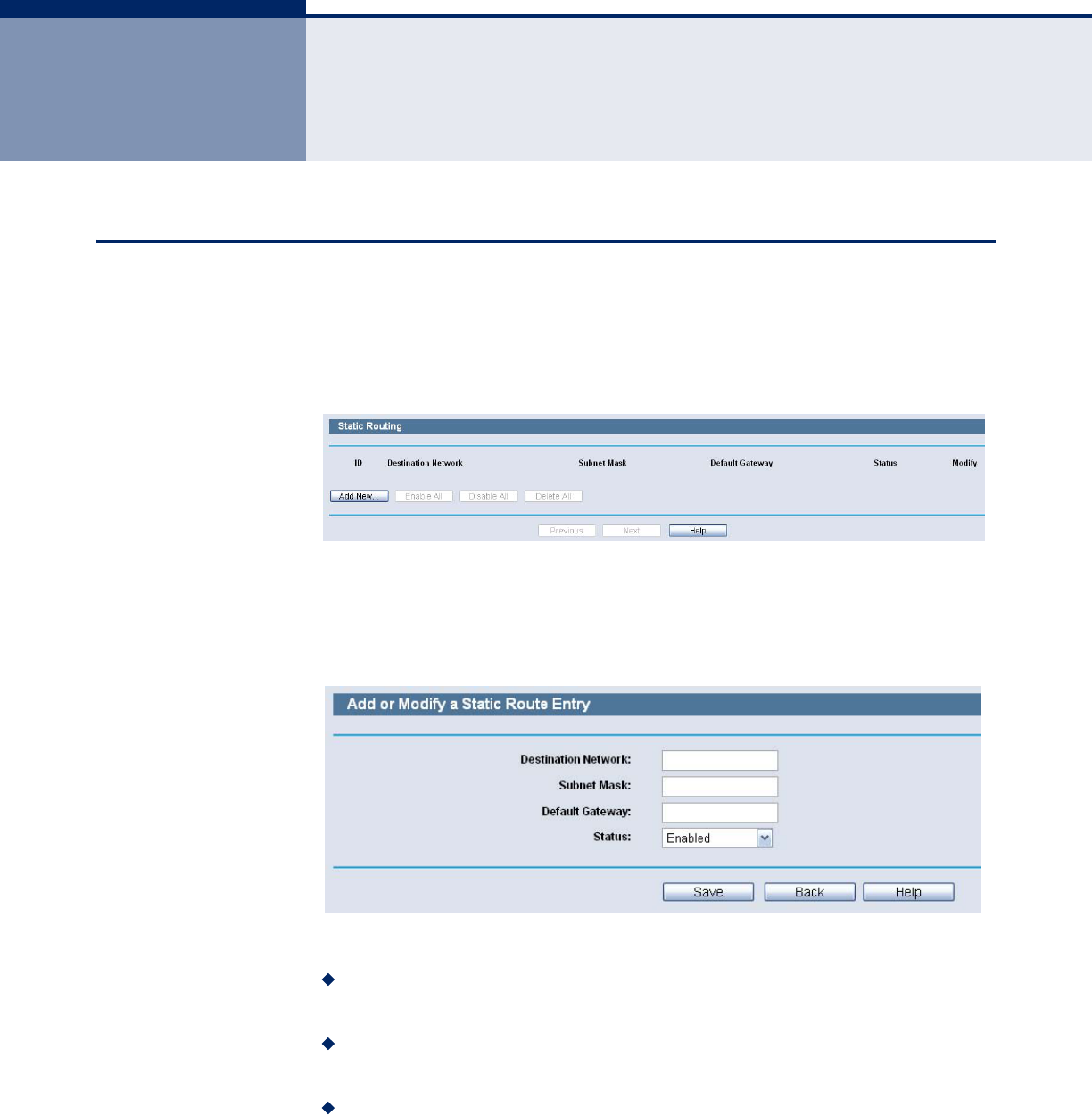
– 96 –
12 ADVANCED ROUTING
STATIC ROUTING LIST
Choose menu “Advanced Routing”, you can configure the static route in the
next screen. A static route is a pre-determined path that network
information must travel to reach a specific host or network.
Figure 89: Static Routing
To add static routing entries:
1. Click the Add New button.
Figure 90: Add or Modify a Static Route Entry
2. Enter the following data:
Destination IP Address - The Destination IP Address is the address
of the network or host that you want to assign to a static route.
Subnet Mask - The Subnet Mask determines which portion of an IP
Address is the network portion, and which portion is the host portion.
Gateway - This is the IP Address of the gateway device that allows for
contact between the Router and the network or host.

C
HAPTER
12
| Advanced Routing
Static Routing List
– 97 –
3. Select Enabled or Disabled for this entry on the Status pull-down list.
4. Click the Save button to make the entry take effect.
Other configurations for the entries:
Click the Delete button to delete the entry.
Click the Enable All button to enable all the entries.
Click the Disable All button to disable all the entries.
Click the Delete All button to delete all the entries.
Click the Previous button to view the information in the previous screen,
click the Next button to view the information in the next screen.
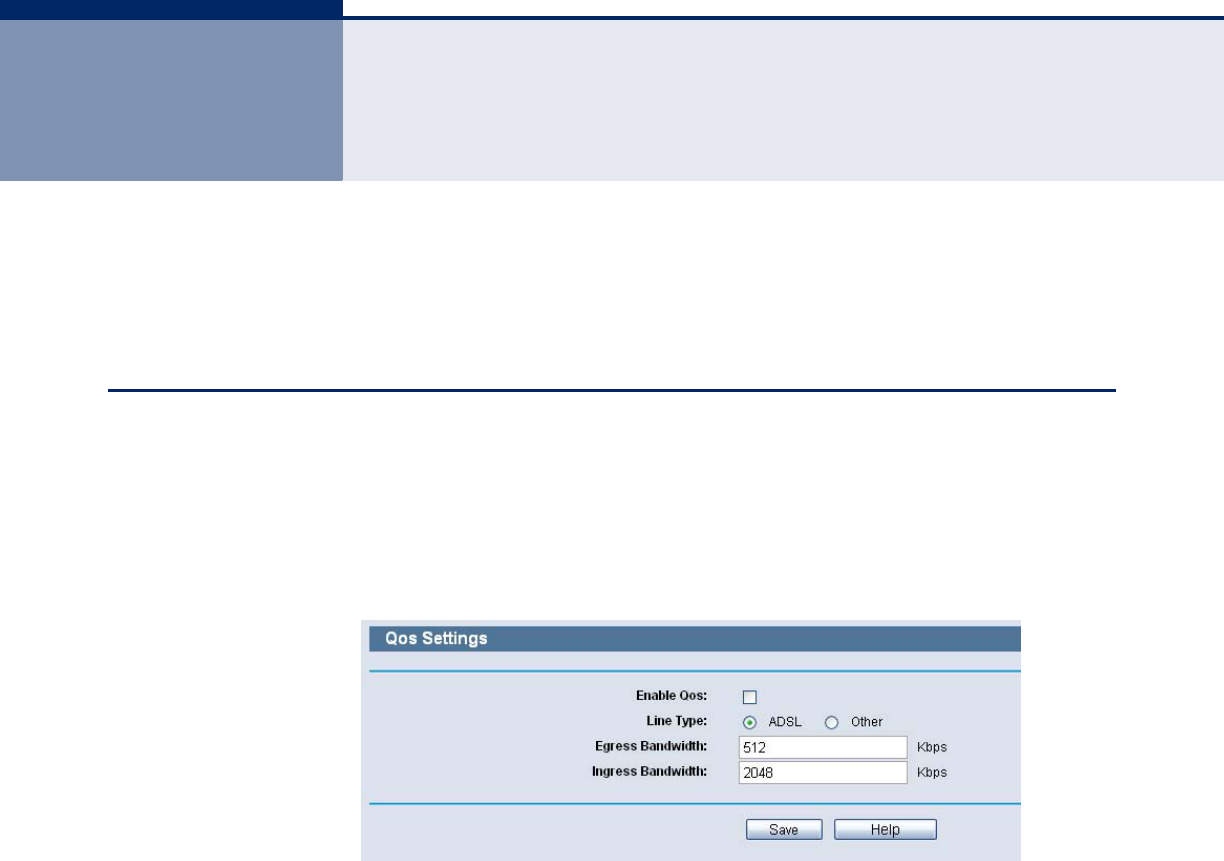
– 98 –
13 QOS SETTINGS
There are two submenus under the QoS menu: QoS Settings and Rules
List. Click any of them, and you will be able to configure the corresponding
function. The detailed explanations for each submenu are provided below.
QOS SETTINGS
Choose menu “QoS->QoS Settings”, you can configure the Egress
Bandwidth and Ingress Bandwidth in the next screen. Their values you
configure should be less than 100000Kbps. For optimal control of the
bandwidth, please select the right Line Type and ask your ISP for the total
bandwidth of the egress and ingress.
Figure 91: QoS Settings
◆Enable QoS - Check this box so that the QoS settings can take effect.
◆Line Type - Select the right type for you network connection. If you
don’t know how to choose, please ask your ISP for the information.
◆Egress Bandwidth - The upload speed through the WAN port.
◆Ingress Bandwidth - The download speed through the WAN port.
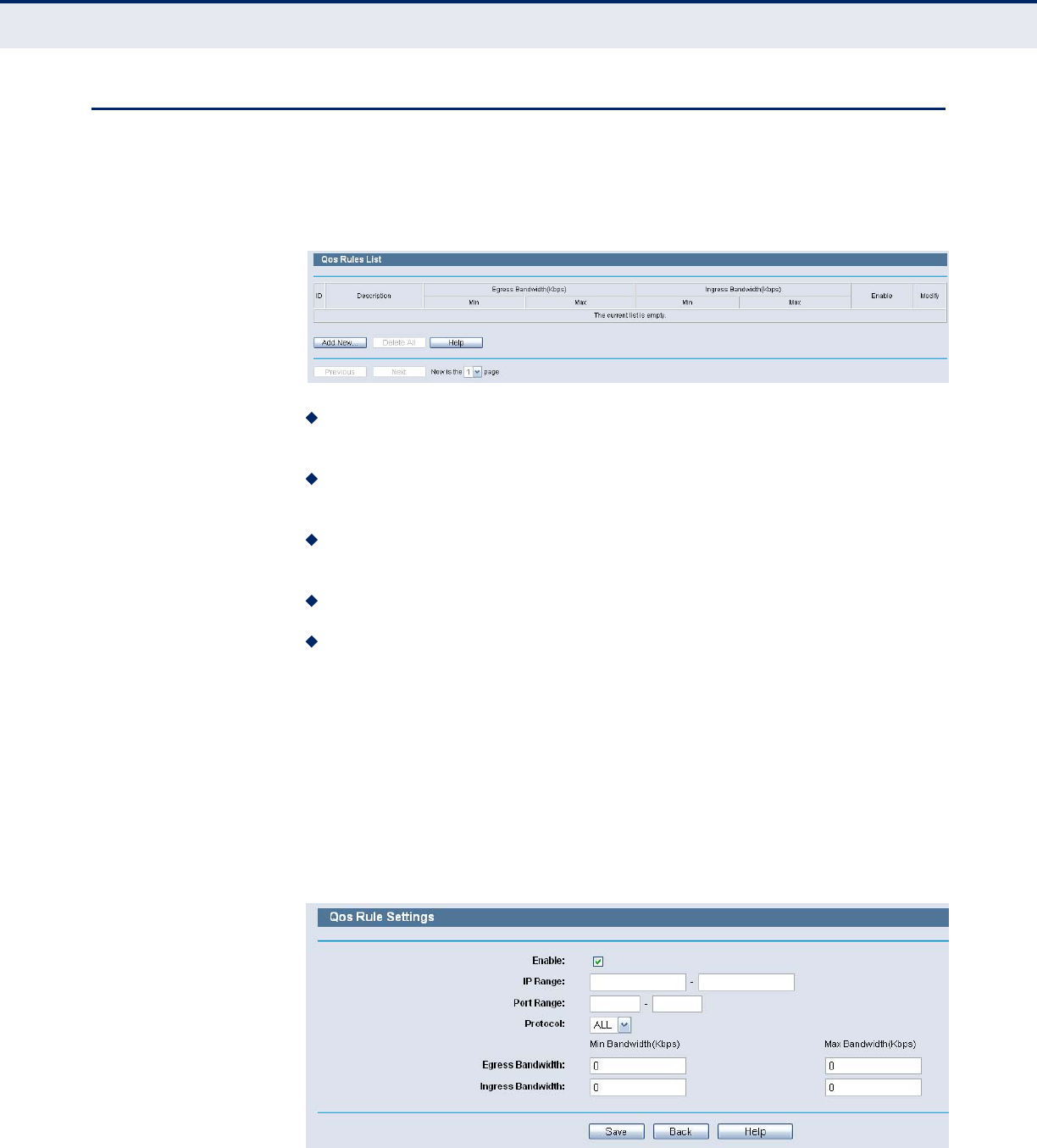
C
HAPTER
13
| QoS Settings
Rules List
– 99 –
RULES LIST
Choose menu “QoS->Rules List”, you can view and configure the QoS rules
in the screen below.
Figure 92: QoS Rules List
Description - This is the information about the rules such as address
range.
Egress bandwidth - This field displays the max and mix upload
bandwidth through the WAN port, the default is 0.
Ingress bandwidth - This field displays the max and mix download
bandwidth through the WAN port, the default is 0.
Enable - This displays the status of the rule.
Modify - Click Modify to edit the rule. Click Delete to delete the rule.
To add/modify a QoS rule, follow the steps below.
1. Click the Add New buttonshown in Figure 91, you will see a new screen
shown in Figure 92.
2. Enter the information like the screen shown below.
3. Click the Save button.
Figure 93: QoS Rule Settings

C
HAPTER
13
| QoS Settings
Rules List
– 100 –
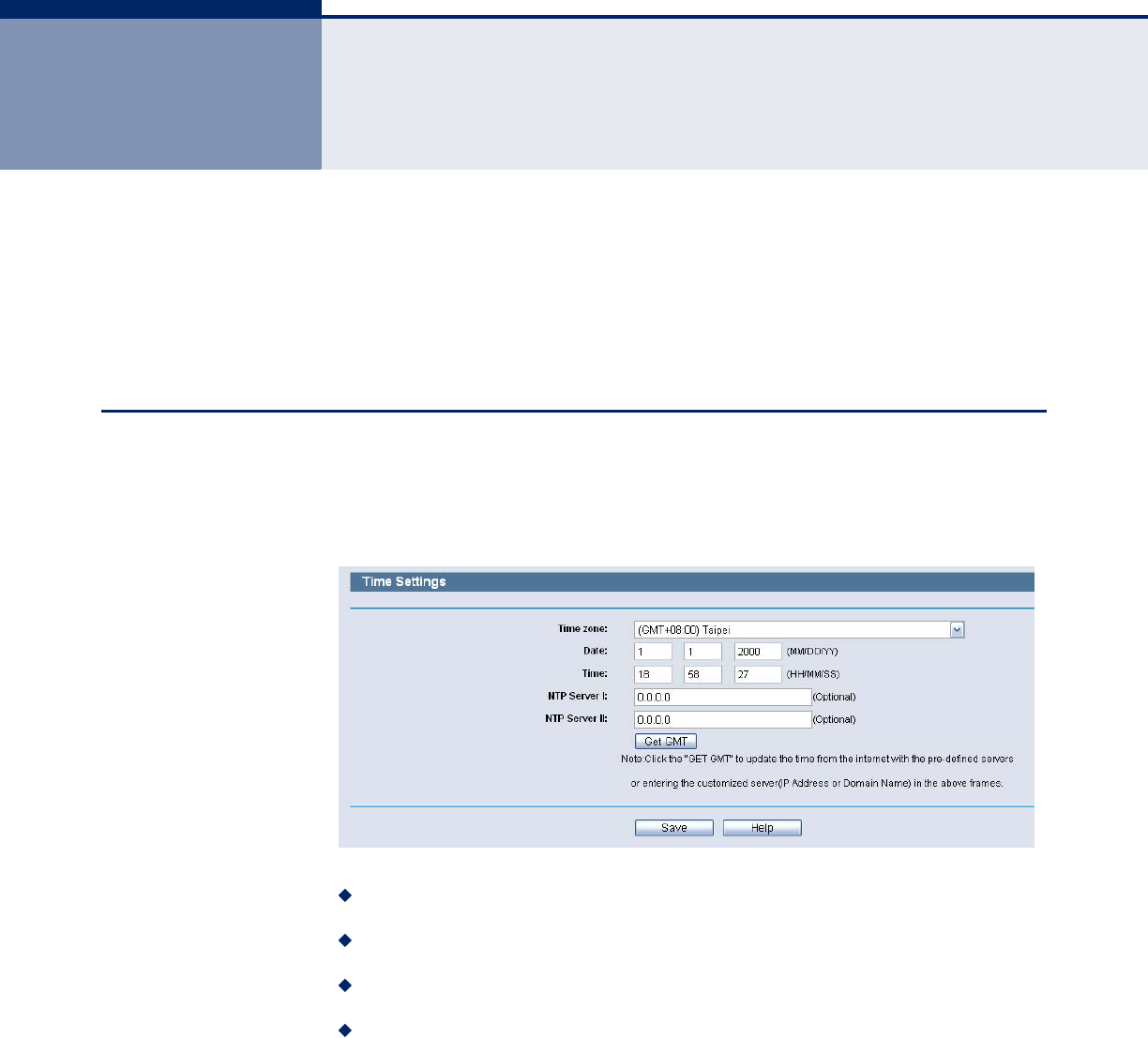
– 101 –
14 SYSTEM TOOLS
Choose menu “System Tools”, and you can see the submenus under the
main menu: Time Settings, Diagnostic, Setting Management, Password,
System Log, Statistics, Local Management and Remote Management. Click
any of them, and you will be able to configure the corresponding function.
The detailed explanations for each submenu are provided below.
TIME SETTING
Choose menu “System Tools->Time Setting”, you can configure the time on
the following screen.
Figure 94: Time Settings
Time Zone - Select your local time zone from this pull down list.
Date - Enter your local date in MM/DD/YY into the right blanks.
Time - Enter your local time in HH/MM/SS into the right blanks.
NTP Server Prior - Enter the address for the NTP Server, then the
Router will get the time from the NTP Server preferentially. In addition,
the Router built-in some common NTP Servers, so it can get time
automatically once it connects the Internet.
To configure the system manually:
1. Select your local time zone.
2. Enter date and time in the right blanks.
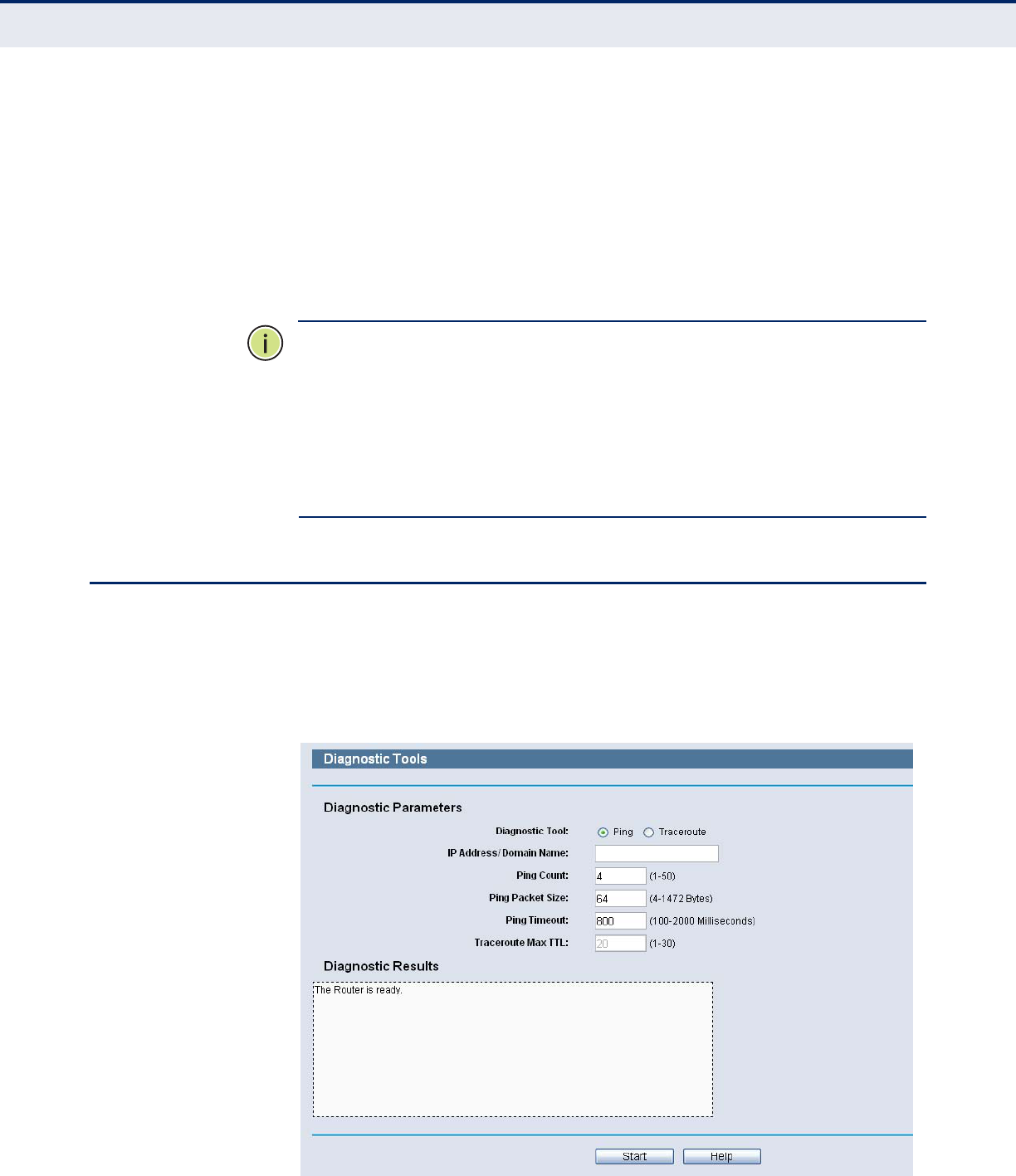
C
HAPTER
14
| System Tools
Diagnostic
– 102 –
3. Click Save to save the configuration.
To configure the system automatically:
1. Select your local time zone.
2. Enter the IP address for NTP Server Prior.
3. Click the Get GMT button to get system time from Internet if you have
connected to the Internet.
N
OTE
:
This setting will be used for some time-based functions such as
firewall. You must specify your time zone once you login to the router
successfully, otherwise, these functions will not take effect.
N
OTE
:
The time will be lost if the router is turned off.
N
OTE
:
The router will obtain GMT automatically from Internet if it has
already connected to Internet.
DIAGNOSTIC
Choose menu “System Tools->Diagnostic”, you can transact Ping or
Traceroute function to check connectivity of your network in the following
screen.
Figure 95: Diagnostic Tools
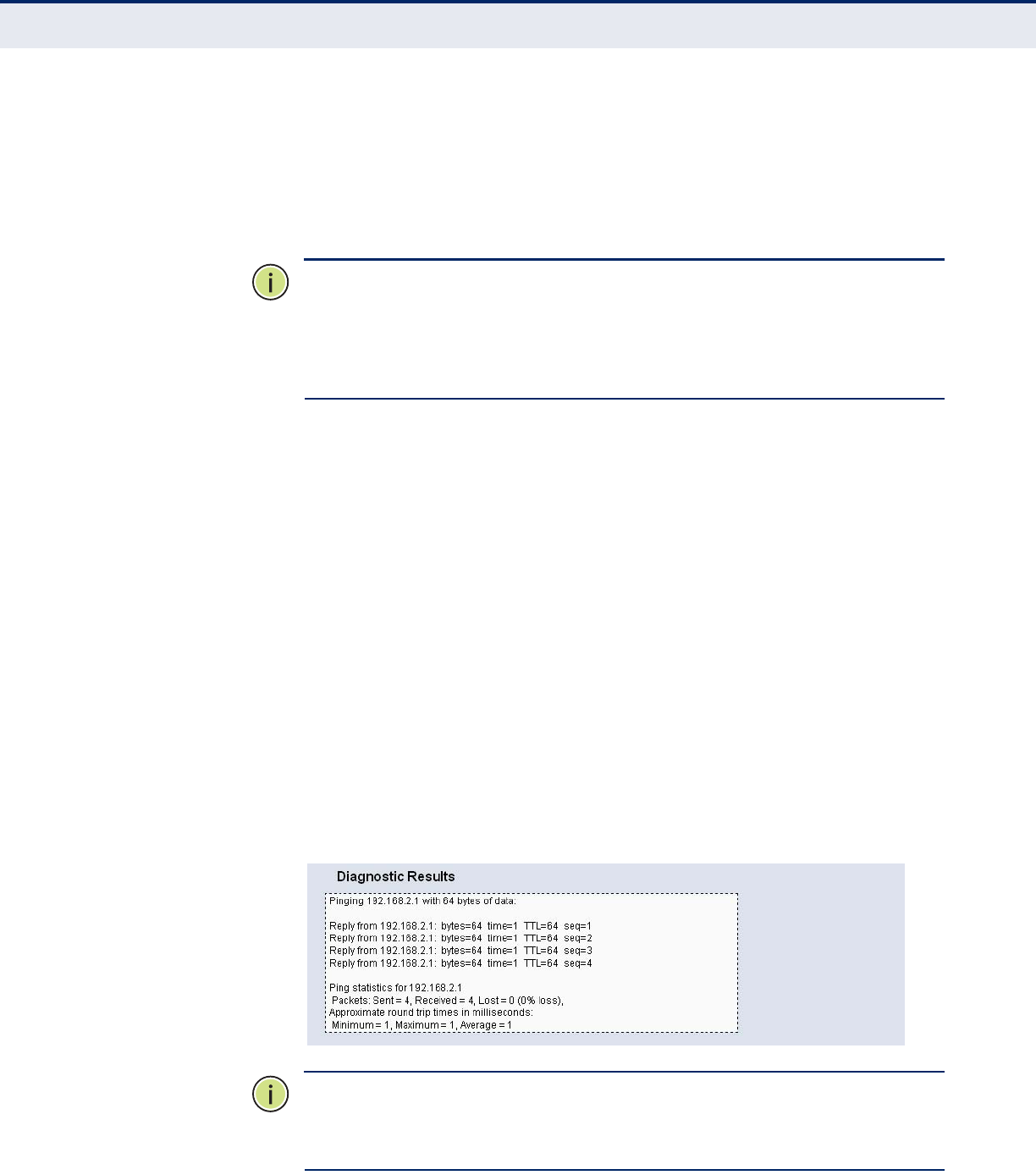
C
HAPTER
14
| System Tools
Diagnostic
– 103 –
◆Diagnostic Tool - Check the radio button to select one diagnostic too.
■Ping - This diagnostic tool troubleshoots connectivity, reachability,
and name resolution to a given host or gateway.
■Traceroute - This diagnostic tool tests the performance of a
connection.
N
OTE
:
You can use ping/traceroute to test both numeric IP address or
domain name. If pinging/tracerouting the IP address is successful, but
pinging/tracerouting the domain name is not, you might have a name
resolution problem. In this case, ensure that the domain name you are
specifying can be resolved by using Domain Name System (DNS) queries.
◆IP Address/Domain Name - Type the destination IP address (such as
202.108.22.5) or Domain name (such as http://www.smc.com)
◆Pings Count - The number of Ping packets for a Ping connection.
◆Ping Packet Size - The size of Ping packet.
◆Ping Timeout - Set the waiting time for the reply of each Ping packet.
If there is no reply in the specified time, the connection is overtime.
◆Traceroute Max TTL - The max number of hops for a Traceroute
connection.
Click Start to check the connectivity of the Internet.
The Diagnostic Results page displays the result of diagnosis.
If the result is similar to the following screen, the connectivity of the
Internet is fine.
Figure 96: Diagnostic Results
N
OTE
:
Only one user can use this tool at one time. Options “Number of
Pings”, “Ping Size” and “Ping Timeout” are used for Ping function. Option
“Tracert Hops” are used for Tracert function.
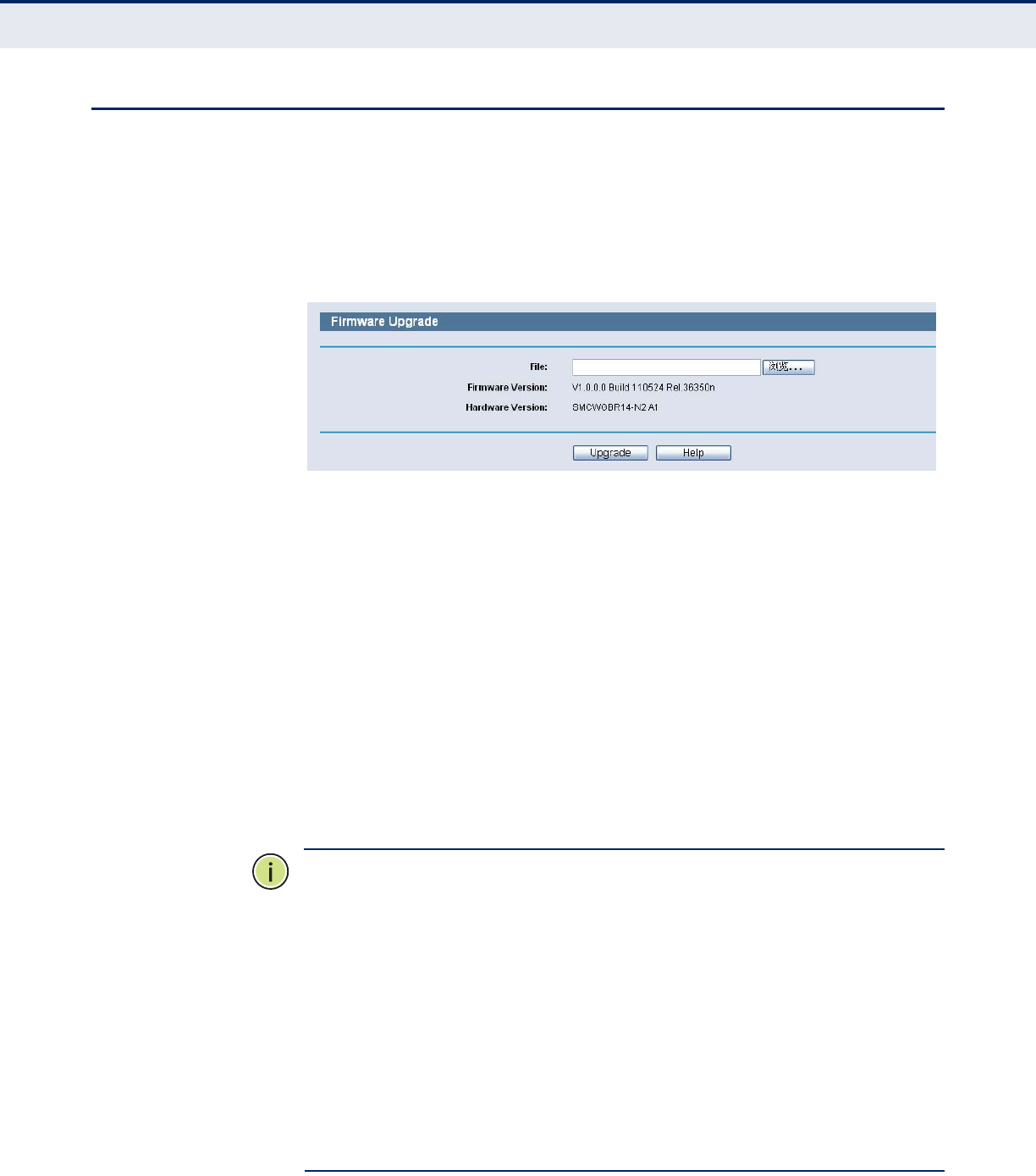
C
HAPTER
14
| System Tools
Settings Management
– 104 –
SETTINGS MANAGEMENT
FIRMWARE UPGRADE Choose menu “System Tools->Firmware Upgrade”, you can update the
latest version of firmware for the Router on the following screen.
Figure 97: Firmware Upgrade
◆Firmware Version - This displays the current firmware version.
◆Hardware Version - This displays the current hardware version. The
hardware version of the upgrade file must accord with the Router’s
current hardware version.
To upgrade the Router's firmware, follow these instructions below:
1. Download a more recent firmware upgrade file from the SMC website
(http://www.smc.com).
2. Type the path and file name of the update file into the File field. Or click
the Browse button to locate the update file.
3. Click the Upgrade button.
N
OTE
:
New firmware versions are posted at http://www.smc.com and can
be downloaded for free. There is no need to upgrade the firmware unless
the new firmware has a new feature you want to use. However, when
experiencing problems caused by the Router rather than the configuration,
you can try to upgrade the firmware.
N
OTE
:
When you upgrade the Router's firmware, you may lose its current
configurations, so before upgrading the firmware please write down some
of your customized settings to avoid losing important settings.
N
OTE
:
Do not turn off the Router or press the Reset button while the
firmware is being upgraded, otherwise, the Router may be damaged.
N
OTE
:
The Router will reboot after the upgrading has been finished.
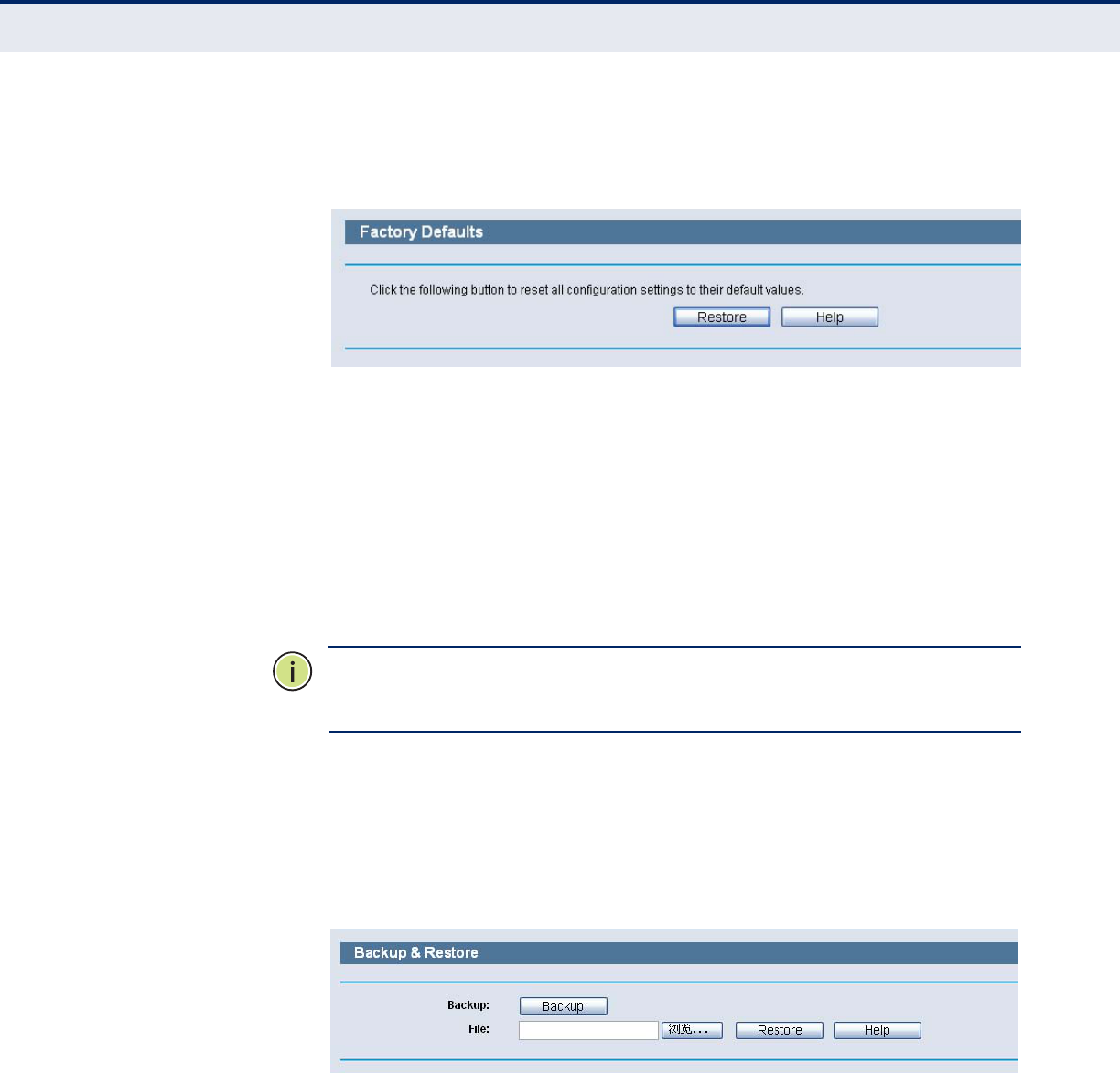
C
HAPTER
14
| System Tools
Settings Management
– 105 –
FACTORY DEFAULTS Choose menu “System Tools-> Factory Defaults”, and you can restore the
configurations of the Router to factory defaults on the following screen.
Figure 98: Restore Factory Default
Click the Restore button to reset all configuration settings to their default
values.
◆The default User Name: admin
◆The default Password: smcadmin
◆The default IP Address: 192.168.2.1
◆The default Subnet Mask: 255.255.255.0
N
OTE
:
Any settings you have saved will be lost when the default settings
are restored.
BACKUP & RESTORE Choose menu “System Tools-> Backup & Restore”, you can save the
current configuration of the Router as a backup file and restore the
configuration via a backup file as shown in the following figure.
Figure 99: Backup & Restore Configuration
◆Click the Backup button to save all configuration settings as a backup
file in your local computer.
◆To upgrade the Router's configuration, follow these instructions.
■Click the Browse… button to locate the update file for the Router, or
enter the exact path to the Setting file in the text box.
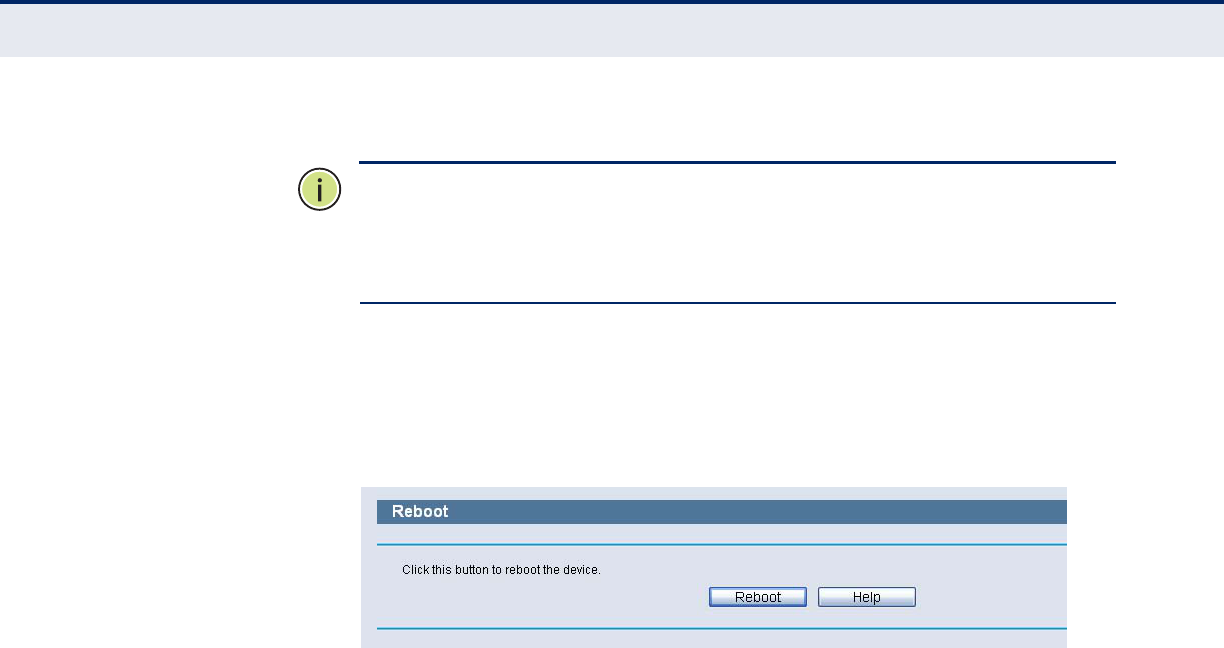
C
HAPTER
14
| System Tools
Settings Management
– 106 –
■Click the Restore button.
N
OTE
:
The current configuration will be covered by the uploading
configuration file. The upgrade process lasts for 20 seconds and the Router
will restart automatically. Keep the Router on during the upgrading process
to prevent any damage.
REBOOT Choose menu “System Tools->Reboot”, you can click the Reboot button to
reboot the Router via the next screen.
Figure 100: Reboot
Some settings of the Router will take effect only after rebooting, which
include
◆Change the LAN IP Address (system will reboot automatically).
◆Change the DHCP Settings.
◆Change the Wireless configurations.
◆Change the Web Management Port.
◆Upgrade the firmware of the Router (system will reboot automatically).
◆Restore the Router's settings to factory defaults (system will reboot
automatically).
◆Update the configuration with the file (system will reboot automatically.
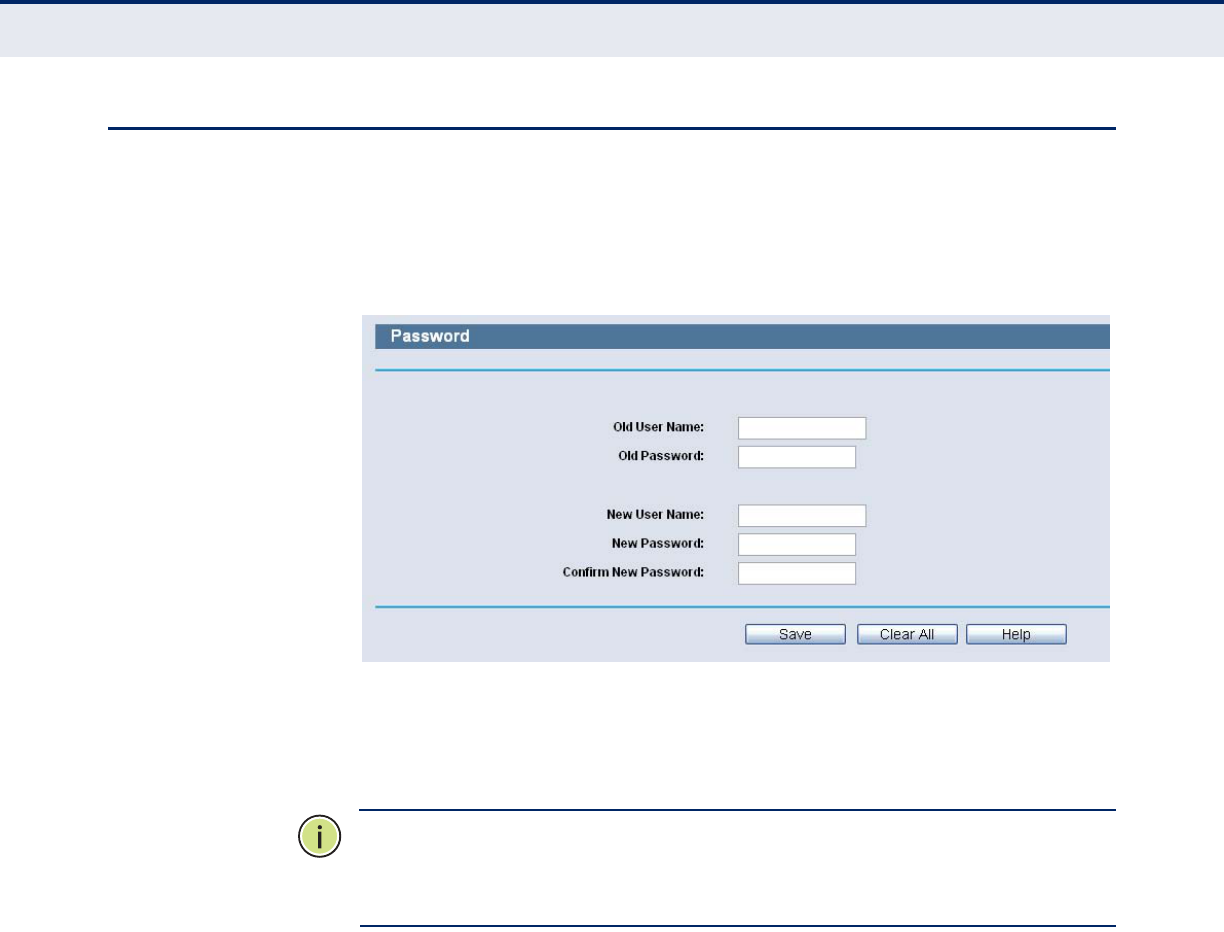
C
HAPTER
14
| System Tools
Password
– 107 –
PASSWORD
Choose menu “System Tools->Password”, you can change the factory
default user name and password of the Router in the next screen as shown
in the following figure.
Figure 101: Password
It is strongly recommended that you should change the factory default
user name and password of the Router, because all users who try to access
the Router's Web-based utility or Quick Setup will be prompted for the
Router's default user name and password.
N
OTE
:
The new user name and password must not exceed 14 characters in
length and not include any spaces. Enter the new Password twice to
confirm.
Click the Save button when finished.
Click the Clear All button to clear all.
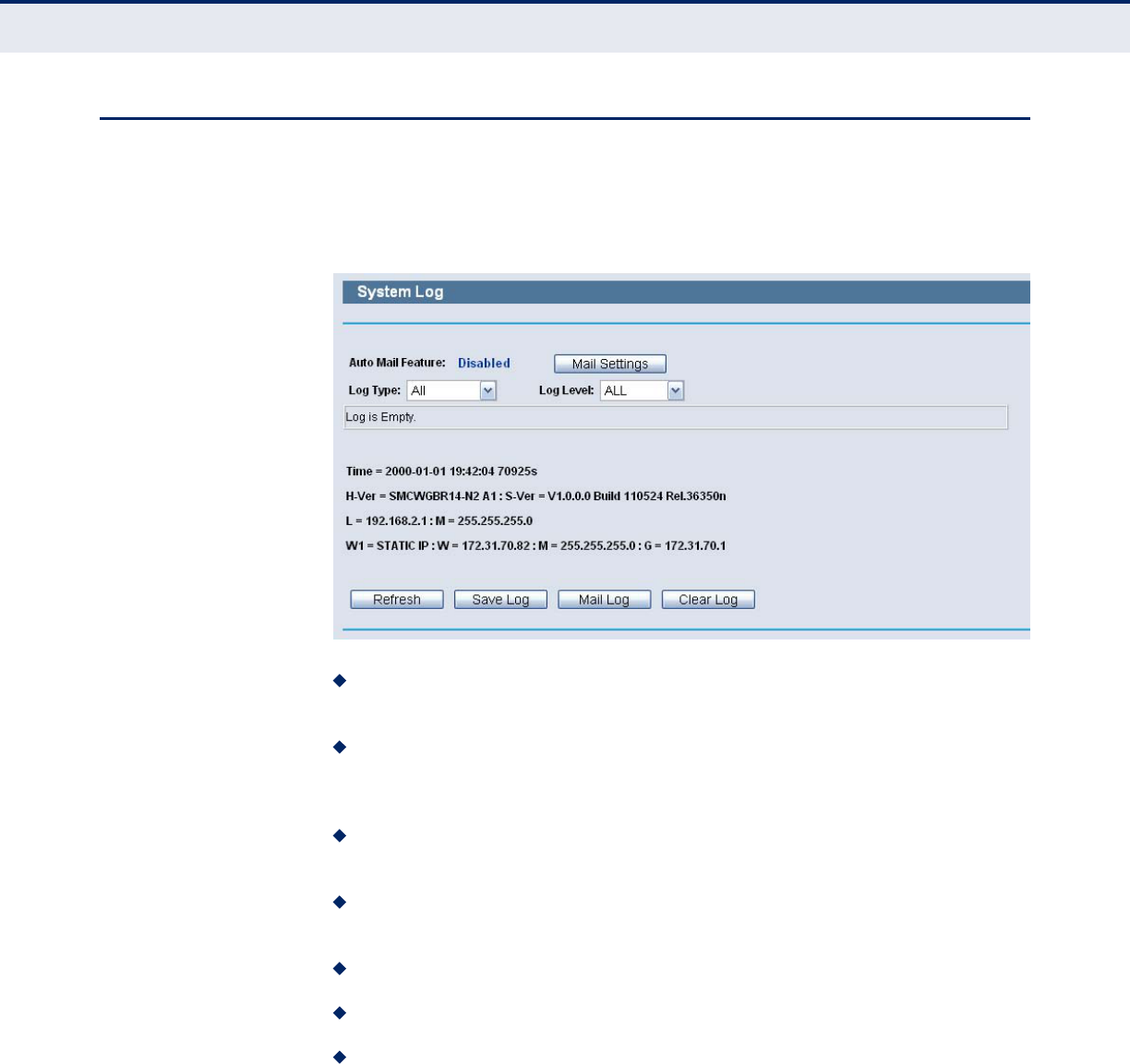
C
HAPTER
14
| System Tools
System Log
– 108 –
SYSTEM LOG
Choose menu “System Tools->System Log”, you can view the logs of the
Router.
Figure 102: System Log
Auto Mail Feature - Indicates whether auto mail feature is enabled or
not.
Mail Settings - Set the receiving and sending mailbox address, server
address, validation information as well as the timetable for Auto Mail
Feature, as shown in Figure 101.
Log Type - By selecting the log type, only logs of this type will be
shown.
Log Level - By selecting the log level, only logs of this level will be
shown.
Refresh - Refresh the page to show the latest log list.
Save Log - Click to save all the logs in a txt file.
Mail Log - Click to send an email of current logs manually according to
the address and validation information set in Mail Settings.
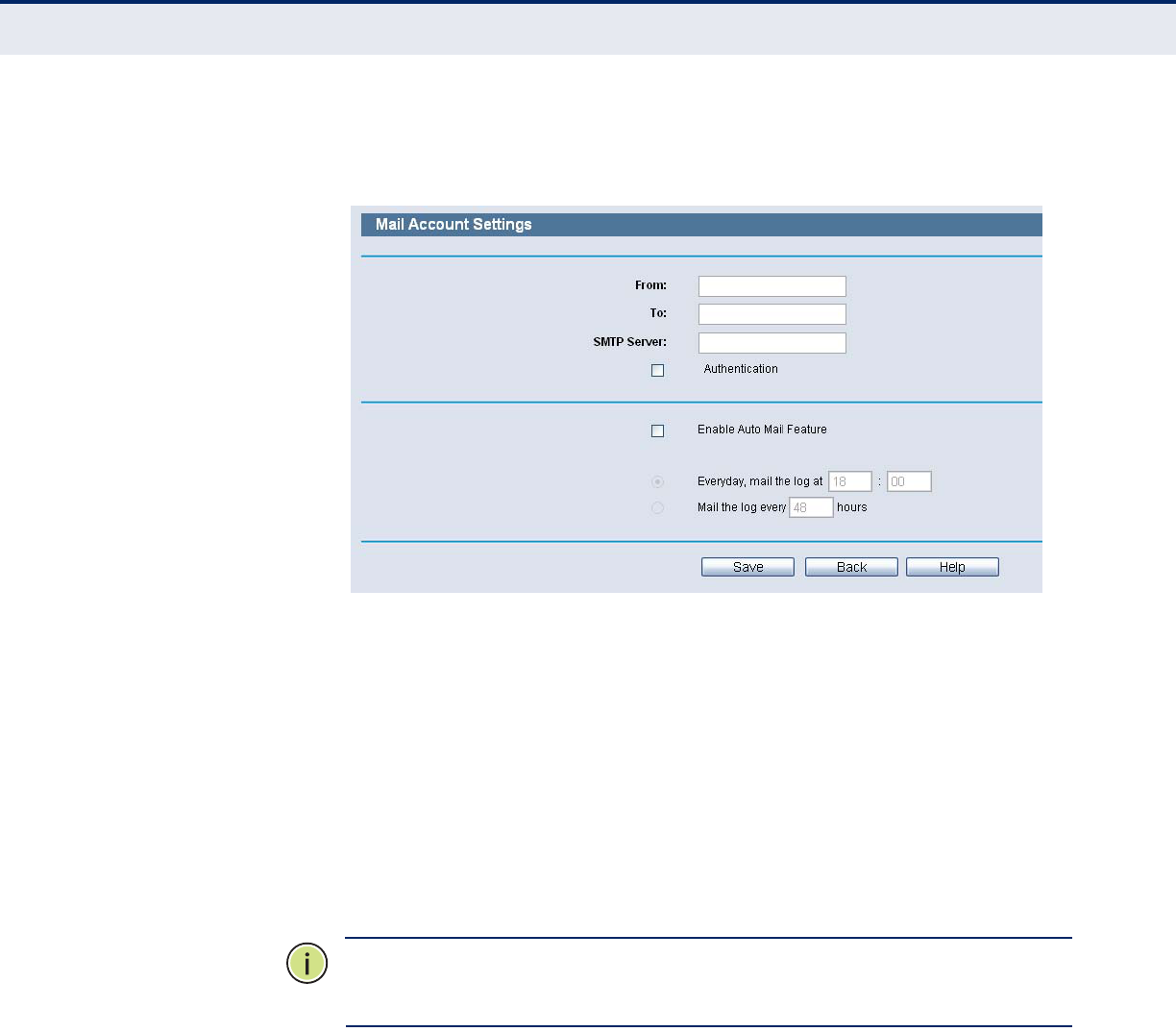
C
HAPTER
14
| System Tools
System Log
– 109 –
◆Clear Log - All the logs will be deleted from the Router permanently,
not just from the page.
Figure 103: Mail Account Settings
◆From - Your mail box address. The Router would connect it to send
logs.
◆To - Recipient’s address. The destination mailbox where the logs would
be received.
◆SMTP Server - Your smtp server. It corresponds with the mailbox filled
in the From field. You can log on the relevant website for Help if you are
not clear with the address.
◆Authentication - Most SMTP Server requires Authentication. It is
required by most mailboxes that need User Name and Password to log
in.
N
OTE
:
Only when you select Authentication, do you have to enter the User
Name and Password in the following fields.
◆User Name - Your mail account name filled in the From field. The part
behind @ is excluded.
◆Password - Your mail account password.
◆Confirm The Password - Enter the password again to confirm.
◆Enable Auto Mail Feature - Select it to mail logs automatically. You
could mail the current logs either at a specified time everyday or by
intervals, but only one could be the current effective rule. Enter the
desired time or intervals in the corresponding field.
Click Save to keep your settings.

C
HAPTER
14
| System Tools
Statistics
– 110 –
Click Back to return to the previous page.
Click the Next button to go to the next page, or click the Previous button
return to the previous page.
STATISTICS
Choose menu “System Tools->Statistics”, you can view the statistics of the
Router, including total traffic and current traffic of the last Packets Statistic
Interval.
Figure 104: Statistics
Current Statistics Status - Enable or Disable. The default value is
disabled. To enable, click the Enable button.
Packets Statistics Interval (5-60) - The default value is 10. Select a
value between 5 and 60 seconds in the pull-down list. The Packets
Statistic interval indicates the time section of the packets statistic.
Select the Auto-refresh checkbox to refresh automatically.
Click the Refresh button to refresh immediately.
Sorted Rules - Select a rule from the pull-down list to display the
corresponding statistics..
Click Reset All to reset the values of all the entries to zero.
Click Delete All to delete all entries in the table.
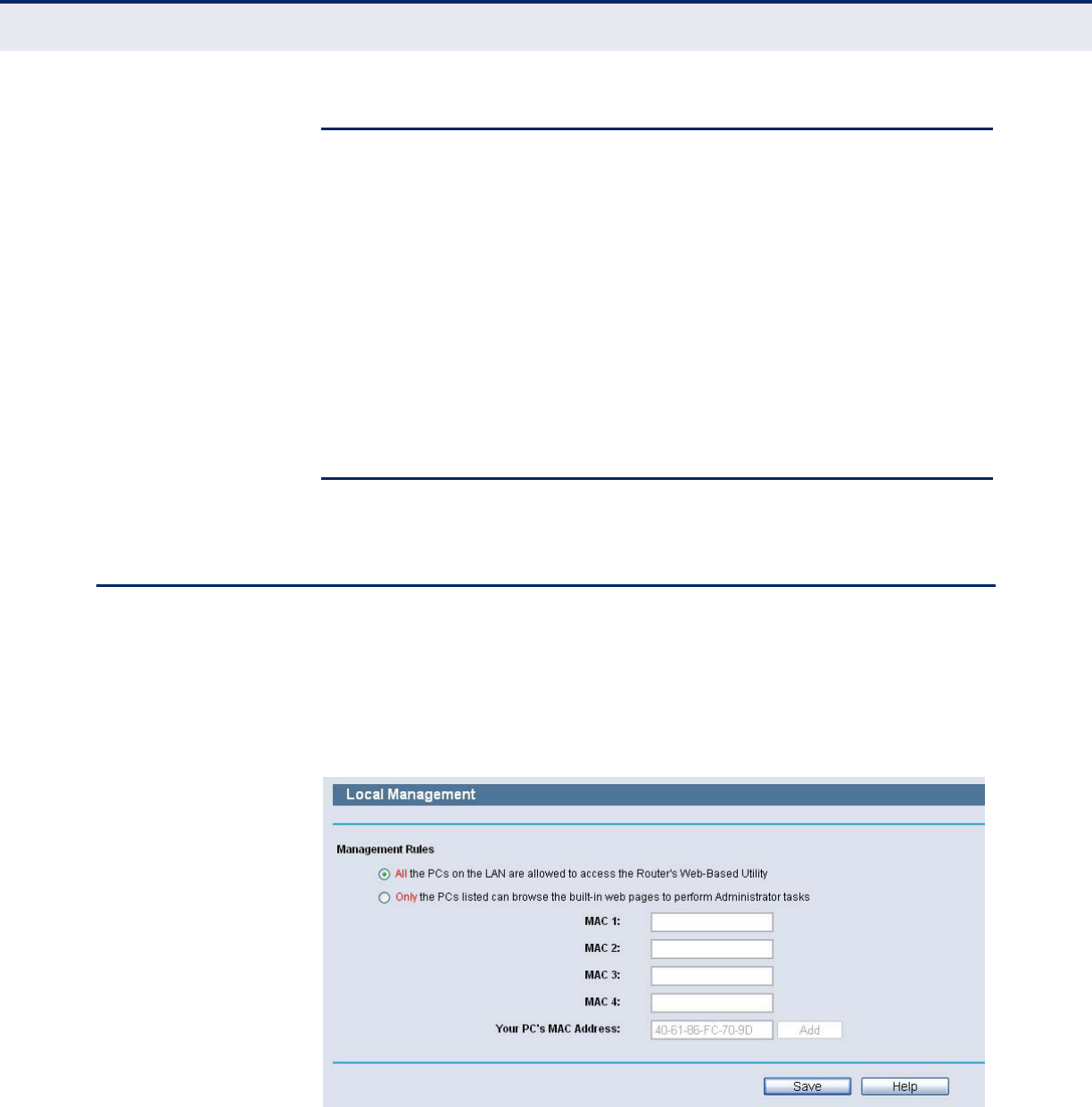
C
HAPTER
14
| System Tools
Local Management
– 111 –
LOCAL MANAGEMENT
Choose menu “Security->Local Management”, you can configure the
management rule in the screen as shown in the following figure. The
management feature allows you to deny computers in LAN from accessing
the Router.
Figure 105: Local Management
Table 3: Statistics Table
IP/MAC Address The IP/MAC Address displayed with statistics
Total Packets The total amount of packets received and transmitted by the
Router.
Bytes The total amount of bytes received and transmitted by the
Router
Current Packets The total amount of packets received and transmitted in the
last Packets Statistic interval seconds.
Bytes The total amount of bytes received and transmitted in the last
Packets Statistic interval seconds.
ICMP Tx The total amount of the ICMP packets transmitted to WAN in
the last Packets Statistic interval seconds.
UDP Tx The total amount of the UDP packets transmitted to WAN in
the last Packets Statistic interval seconds.
TCP SYN Tx The total amount of the TCP SYN packets transmitted to WAN
in the last Packets Statistic interval seconds.
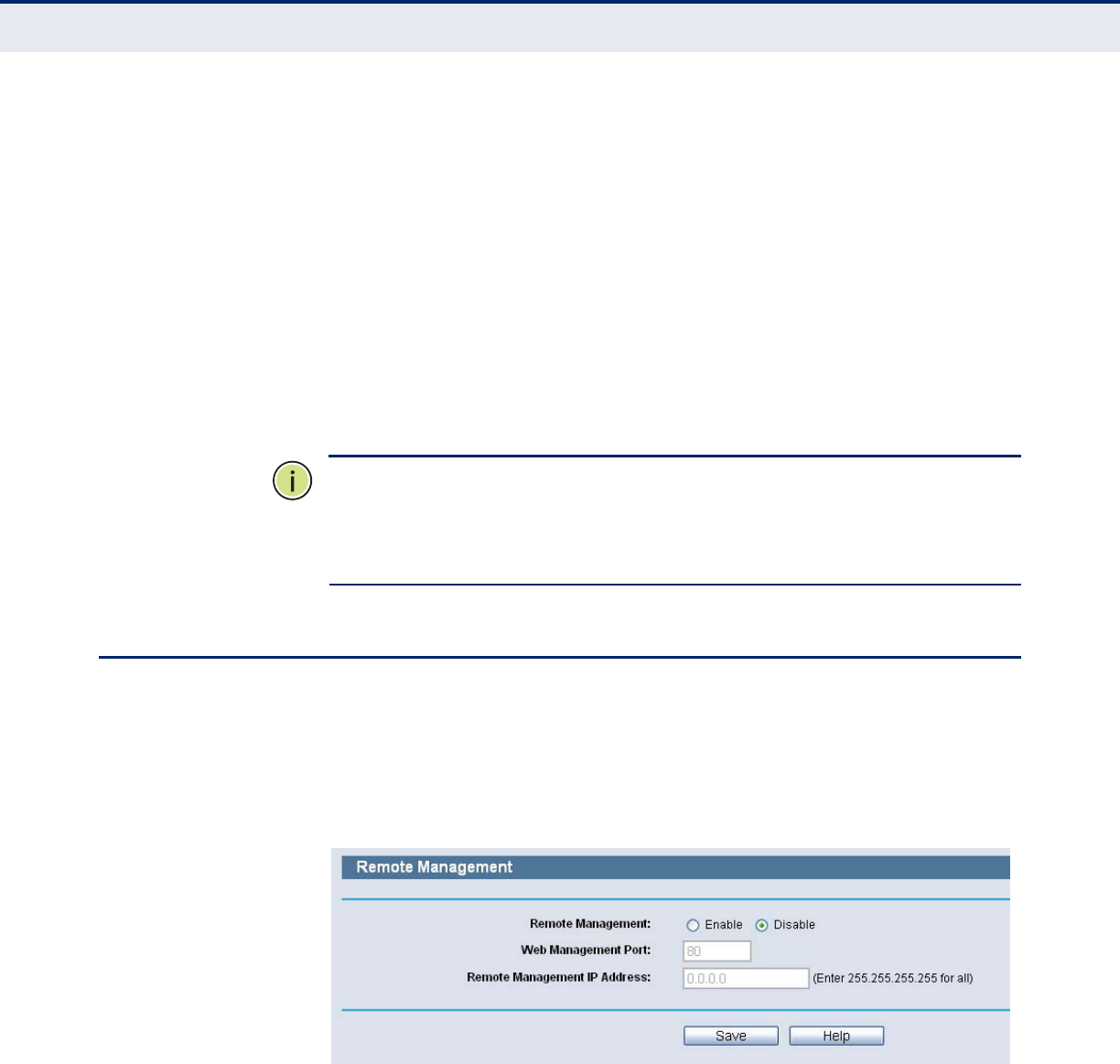
C
HAPTER
14
| System Tools
Remote Management
– 112 –
By default, the radio button “All the PCs on the LAN are allowed to access
the Router's Web-Based Utility” is checked. If you want to allow PCs with
specific MAC Addresses to access the Setup page of the Router's Web-
Based Utility locally from inside the network, check the radio button “Only
the PCs listed can browse the built-in web pages to perform Administrator
tasks”, and then enter each MAC Address in a separate field. The format for
the MAC Address is XX-XX-XX-XX-XX-XX (X is any hexadecimal digit). Only
the PCs with MAC address listed can use the password to browse the built-
in web pages to perform Administrator tasks while all the others will be
blocked.
After click the Add button, your PC's MAC Address will be placed in the list
above.
Click the Save button to save your settings.
N
OTE
:
If your PC is blocked but you want to access the Router again, use a
pin to press and hold the Reset Button (hole) on the back panel for about 5
seconds to reset the Router’s factory defaults on the Router’s Web-Based
Utility.
REMOTE MANAGEMENT
Choose menu “Security->Remote Management”, you can configure the
Remote Management function in the screen as shown in the following
figure. This feature allows you to manage your Router from a remote
location via the Internet.
Figure 106: Remote Management
◆Web Management Port - Web browser access normally uses the
standard HTTP service port 80. This Router's default remote
management web port number is 80. For greater security, you can
change the remote management web port to a custom port by entering
that number in the box provided. Choose a number between 1 and
65534 but do not use the number of any common service port.
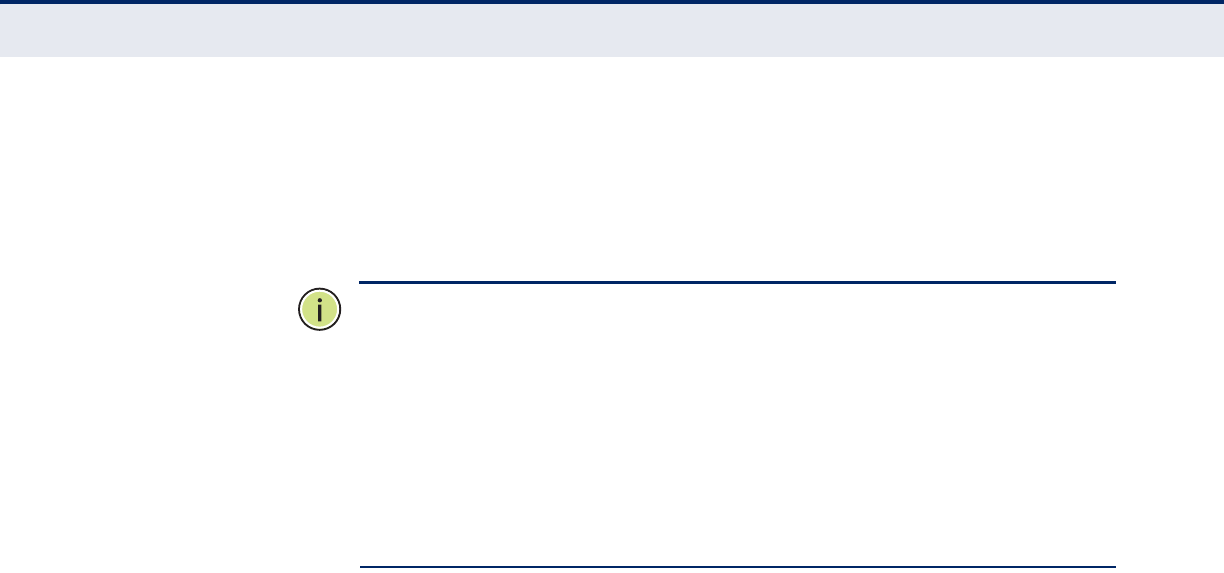
C
HAPTER
14
| System Tools
Remote Management
– 113 –
◆Remote Management IP Address - This is the current address you
will use when accessing your Router from the Internet. This function is
disabled when the IP address is set to the default value of 0.0.0.0. To
enable this function change 0.0.0.0 to a valid IP address. If set to
255.255.255.255, then all the hosts can access the Router from
internet.
N
OTE
:
To access the Router, you should type your Router's WAN IP address
into your browser's address (in IE) or Location (in Navigator) box, followed
by a colon and the custom port number. For example, if your Router's WAN
address is 202.96.12.8, and the port number used is 8080, please enter
http://202.96.12.8:8080 in your browser. Later, you may be asked for the
Router's password. After successfully entering the username and
password, you will be able to access the Router's web-based utility.
N
OTE
:
Be sure to change the Router's default password to a very secure
password.
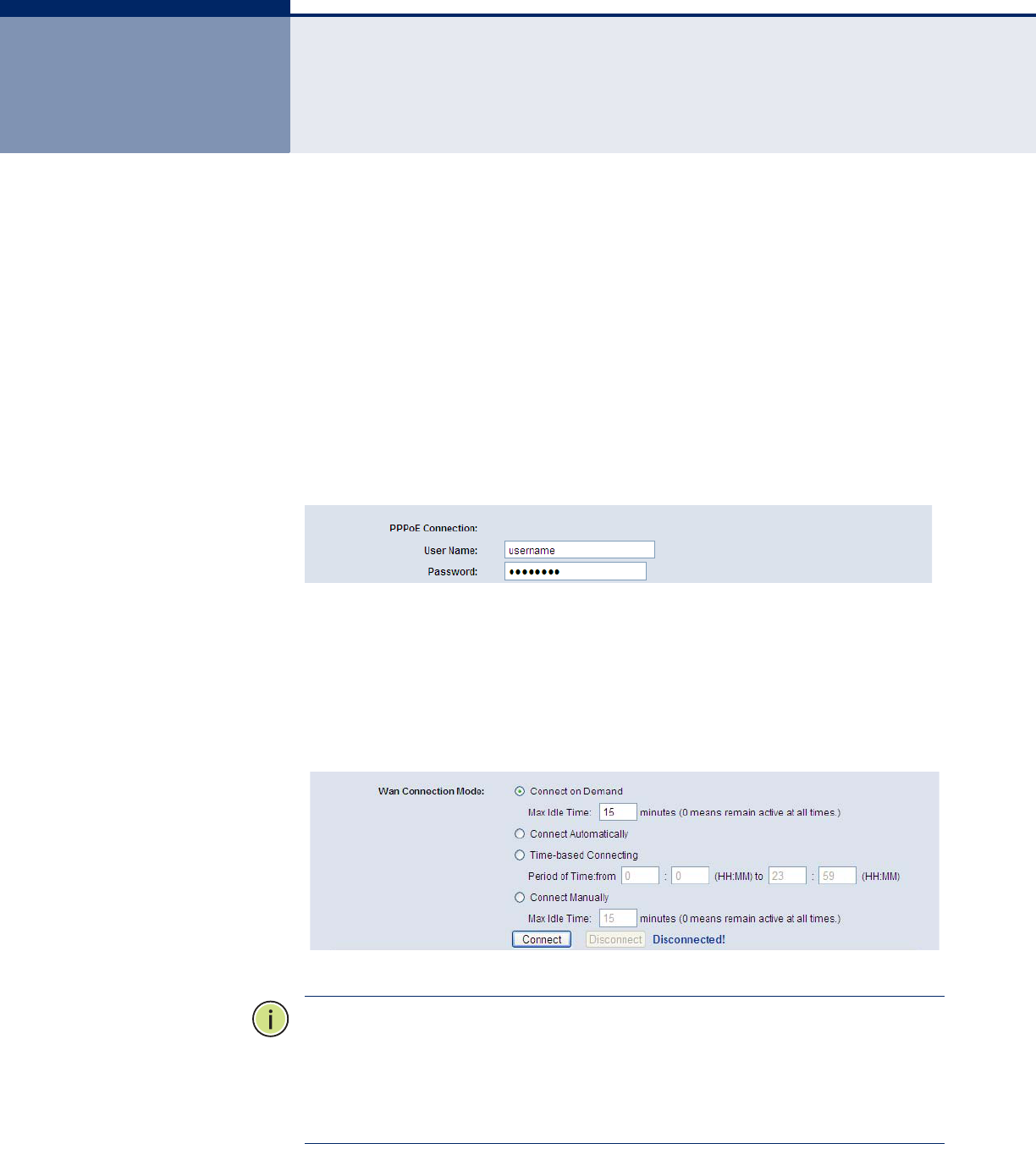
– 114 –
AFAQ
How do I configure the Router to access Internet by ADSL users?
1. First, configure the ADSL Modem configured in RFC1483 bridge model.
2. Connect the Ethernet cable from your ADSL Modem to the WAN port on
the Router. The telephone cord plugs into the Line port of the ADSL
Modem.
3. Login to the Router, click the “Network” menu on the left of your
browser, and click "WAN" submenu. On the WAN page, select “PPPoE”
for WAN Connection Type. Type user name in the “User Name” field and
password in the “Password” field, finish by clicking “Connect”.
Figure 107: PPPoE Connection Type
4. If your ADSL lease is in “pay-according-time” mode, select “Connect on
Demand” or “Connect Manually” for Internet connection mode. Type an
appropriate number for “Max Idle Time” to avoid wasting paid time.
Otherwise, you can select “Auto-connecting” for Internet connection
mode.
Figure 108: PPPoE Connection Mode
N
OTE
:
Sometimes the connection cannot be disconnected although you
specify a time to Max Idle Time, since some applications is visiting the
Internet continually in the background.
N
OTE
:
If you are a Cable user, please configure the Router following the
above steps.
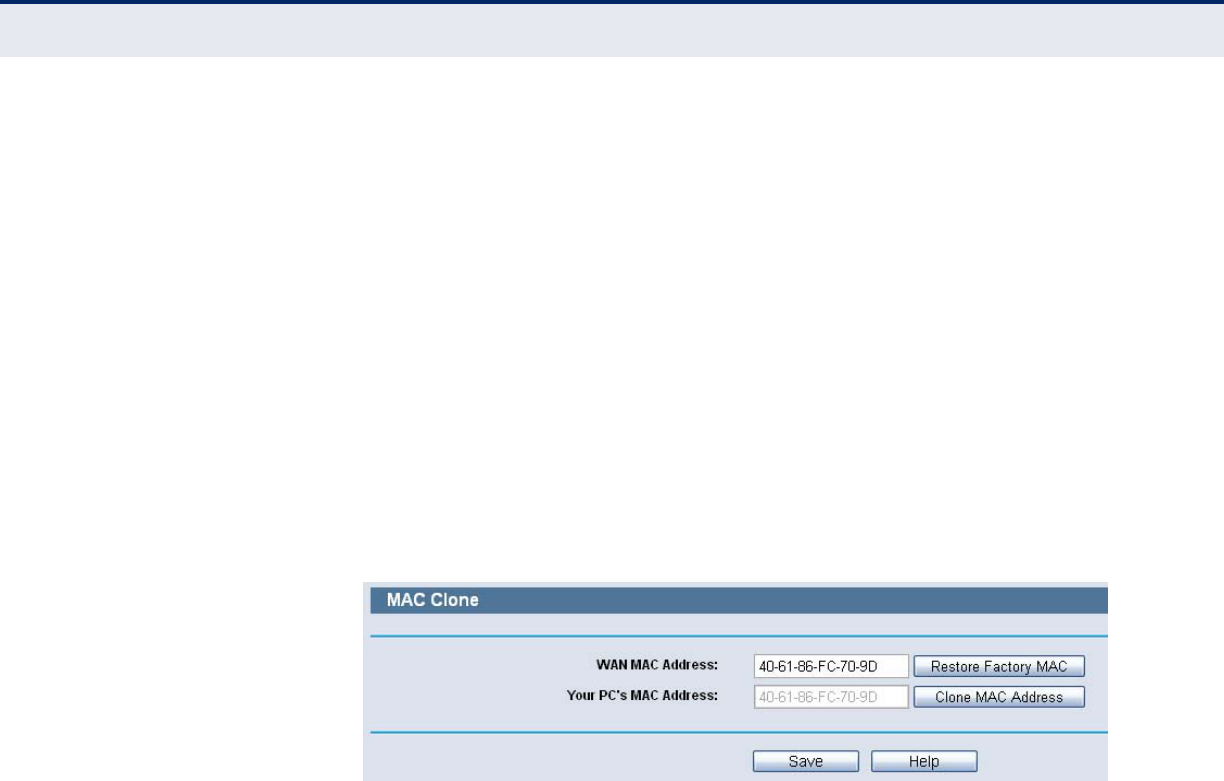
A
PPENDIX
A
| FAQ
– 115 –
How do I configure the Router to access Internet by Ethernet
users?
1. Login to the Router, click the “Network” menu on the left of your
browser, and click "WAN" submenu. On the WAN page, select “Dynamic
IP” for "WAN Connection Type", finish by clicking “Save”.
2. Some ISPs require that you register the MAC Address of your adapter,
which is connected to your cable/DSL Modem during installation. If
your ISP requires MAC register, login to the Router and click the
"Network" menu link on the left of your browser, and then click "MAC
Clone" submenu link. On the "MAC Clone" page, if your PC’s MAC
address is proper MAC address, click the "Clone MAC Address" button
and your PC’s MAC address will fill in the "WAN MAC Address" field. Or
else, type the MAC Address into the "WAN MAC Address" field. The
format for the MAC Address is XX-XX-XX-XX-XX-XX. Then click the
"Save" button. It will take effect after rebooting.
Figure 109: MAC Clone
I want to use Netmeeting, what do I need to do?
1. If you start Netmeeting as a host, you don’t need to do anything with
the Router.
2. If you start as a response, you need to configure Virtual Server or DMZ
Host and make sure the H323 ALG is enabled.
3. How to configure Virtual Server: Log in to the Router, click the “Special
Application” menu on the left of your browser, and click "Virtual
Servers" submenu. On the "Virtual Servers" page, Click the Add New
button. Then on the “Add or Modify a Virtual Server Entry” page, enter
“1720” for the “Service Port” blank, and your IP address for the “IP
Address” blank, taking 192.168.2.169 for an example, remember to
Enable and Save.
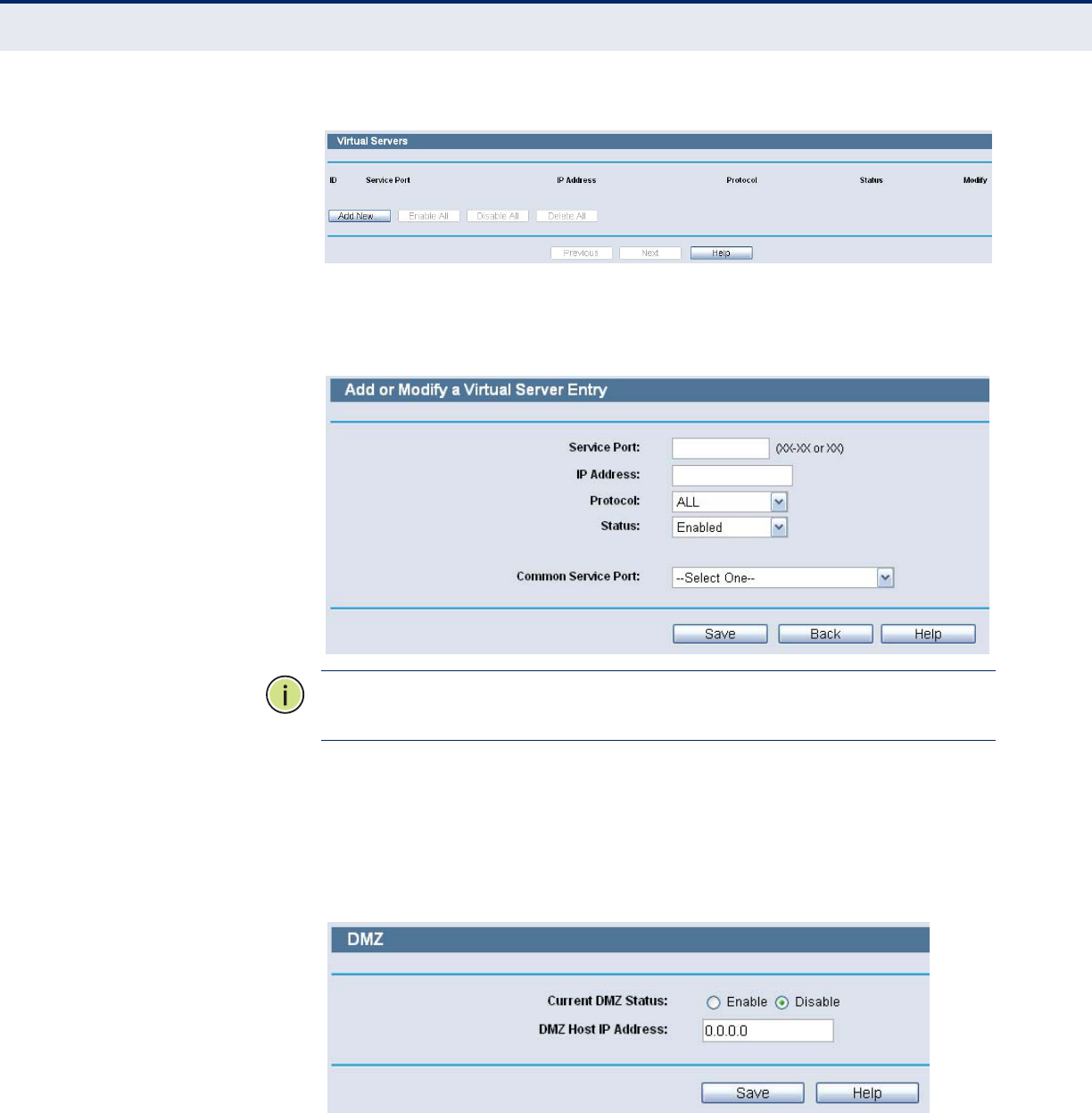
A
PPENDIX
A
| FAQ
– 116 –
Figure 110: Virtual Servers
Figure 111: Virtual Servers
N
OTE
:
Your opposite side should call your WAN IP, which is displayed on
the “Status” page.
4. How to enable DMZ Host: Log in to the Router, click the “Special
Application” menu on the left of your browser, and click "DMZ"
submenu. On the "DMZ" page, click Enable radio button and type your
IP address into the “DMZ Host IP Address” field, using 192.168.2.169
as an example, remember to click the Save button.
Figure 112: DMZ
5. How to enable H323 ALG: Log in to the Router, click the “Security”
menu on the left of your browser, and click “Basic Security” submenu.
On the “Basic Security” page, check the Enable radio button next to
H323 ALG. Remember to click the Save button.
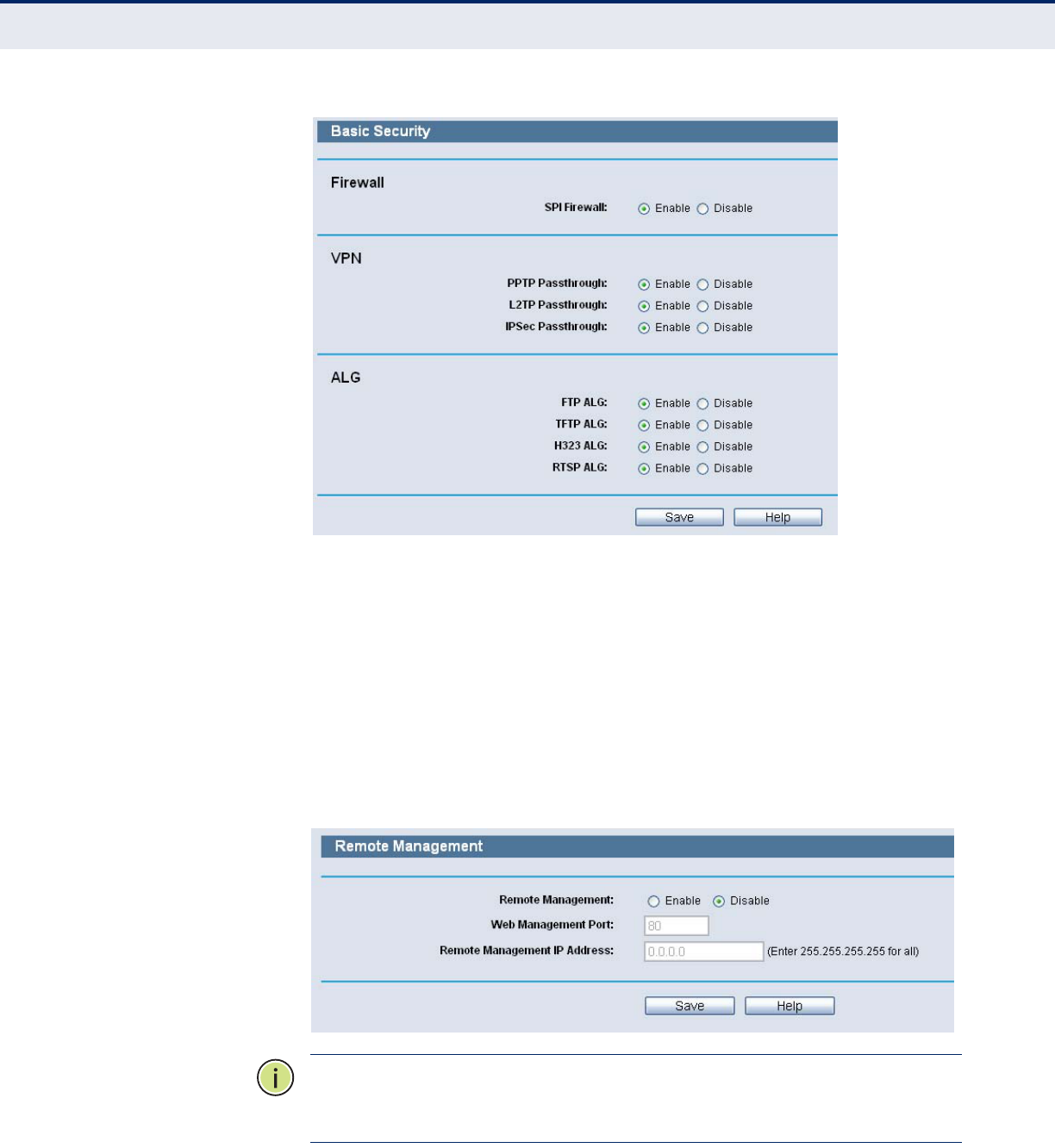
A
PPENDIX
A
| FAQ
– 117 –
Figure 113: Basic Security
I want to build a WEB Server on the LAN, what should I do?
1. Because the WEB Server port 80 will interfere with the WEB
management port 80 on the Router, you must change the WEB
management port number to avoid interference.
2. To change the WEB management port number: Log in to the Router,
click the “Security” menu on the left of your browser, and click "Remote
Management" submenu. On the "Remote Management" page, type a
port number except 80, such as 88, into the "Web Management Port"
field. Click Save and reboot the Router.
Figure 114: Remote Management
N
OTE
:
If the above configuration takes effect, to configure to the Router by
typing http://192.168.2.1:88 (the Router’s LAN IP address: Web
Management Port) in the address field of the Web browser.
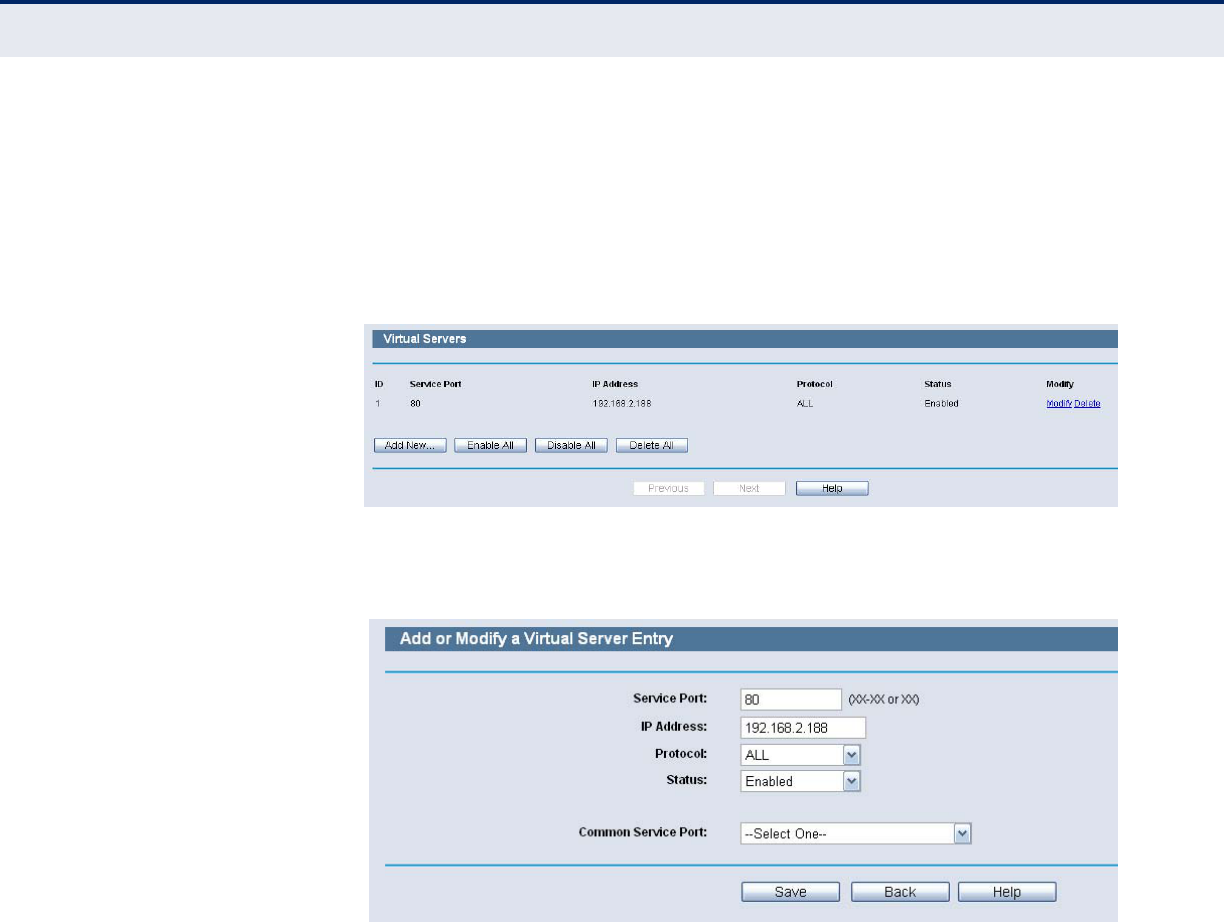
A
PPENDIX
A
| FAQ
– 118 –
3. Log in to the Router, click the “Special Application” menu on the left of
your browser, and click the "Virtual Servers" submenu. On the "Virtual
Servers" page, Click the Add New button, then on the “Add or Modify a
Virtual Server” page, enter “80” into the blank next to the “Service
Port”, and your IP address next to the “IP Address”, assuming
192.168.2.188 for an example, remember to Enable and Save.
Figure 115: Virtual Servers
Figure 116: Add or Modify a Virtual Server Entry
The wireless stations cannot connect to the Router.
1. Make sure the "Wireless Router Radio" is enabled.
2. Make sure that the wireless stations' SSID accord with the Router's
SSID.
3. Make sure the wireless stations have right KEY for encryption when the
Router is encrypted.
4. If the wireless connection is ready, but you can’t access the Router,
check the IP Address of your wireless stations.
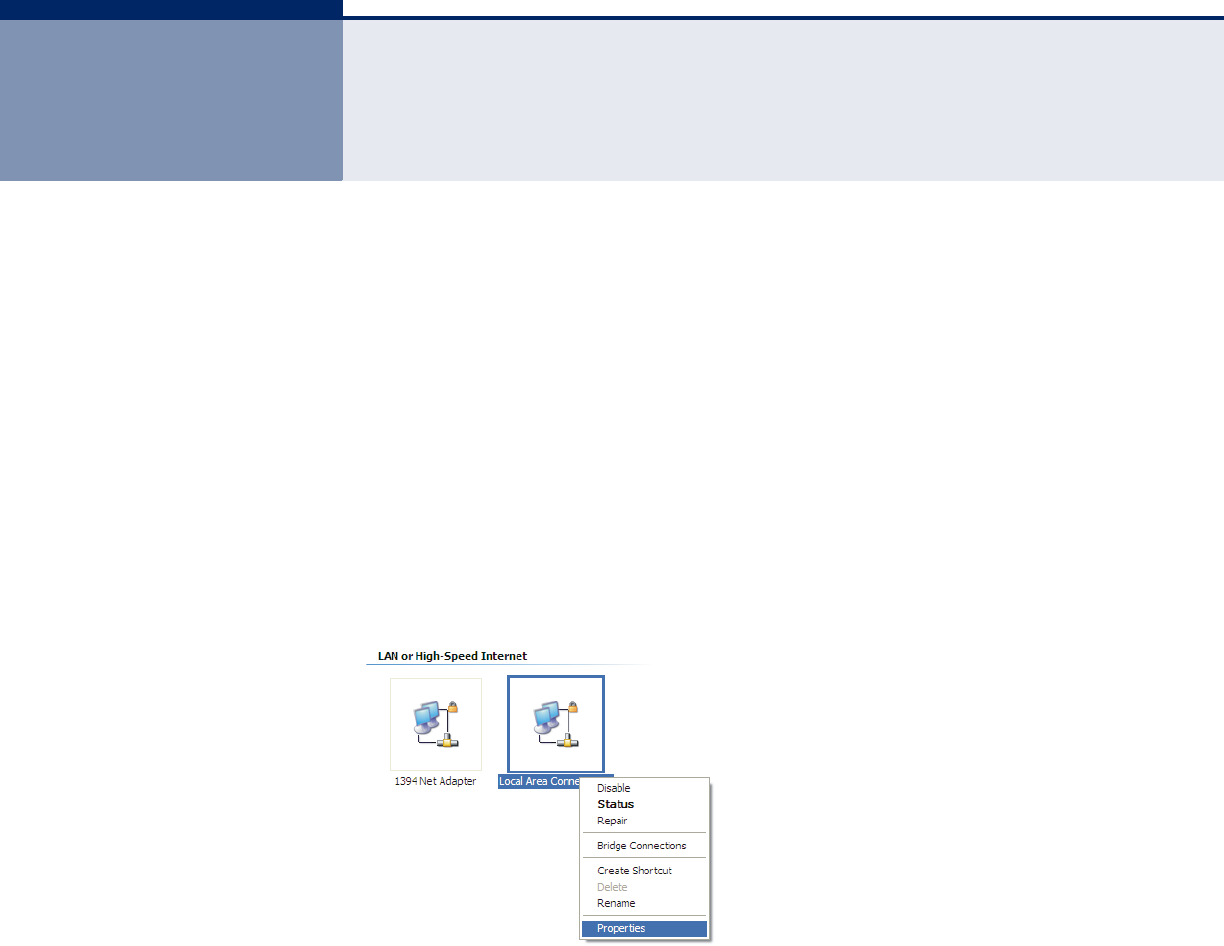
– 119 –
BCONFIGURING THE PCS
In this section, we’ll introduce how to install and configure the TCP/IP
correctly in Windows XP. First make sure your Ethernet Adapter is working,
refer to the adapter’s manual if needed.
1. Install TCP/IP component
a. On the Windows taskbar, click the Start button, point to Settings,
and then click Control Panel.
b. Click the Network and Internet Connections icon, and then click on
the Network Connections tab in the appearing window.
c. Right click the icon that showed below, select Properties on the
prompt page.
Figure 117: Internet Connection
d. In the prompt page that showed below, double click on the Internet
Protocol (TCP/IP).
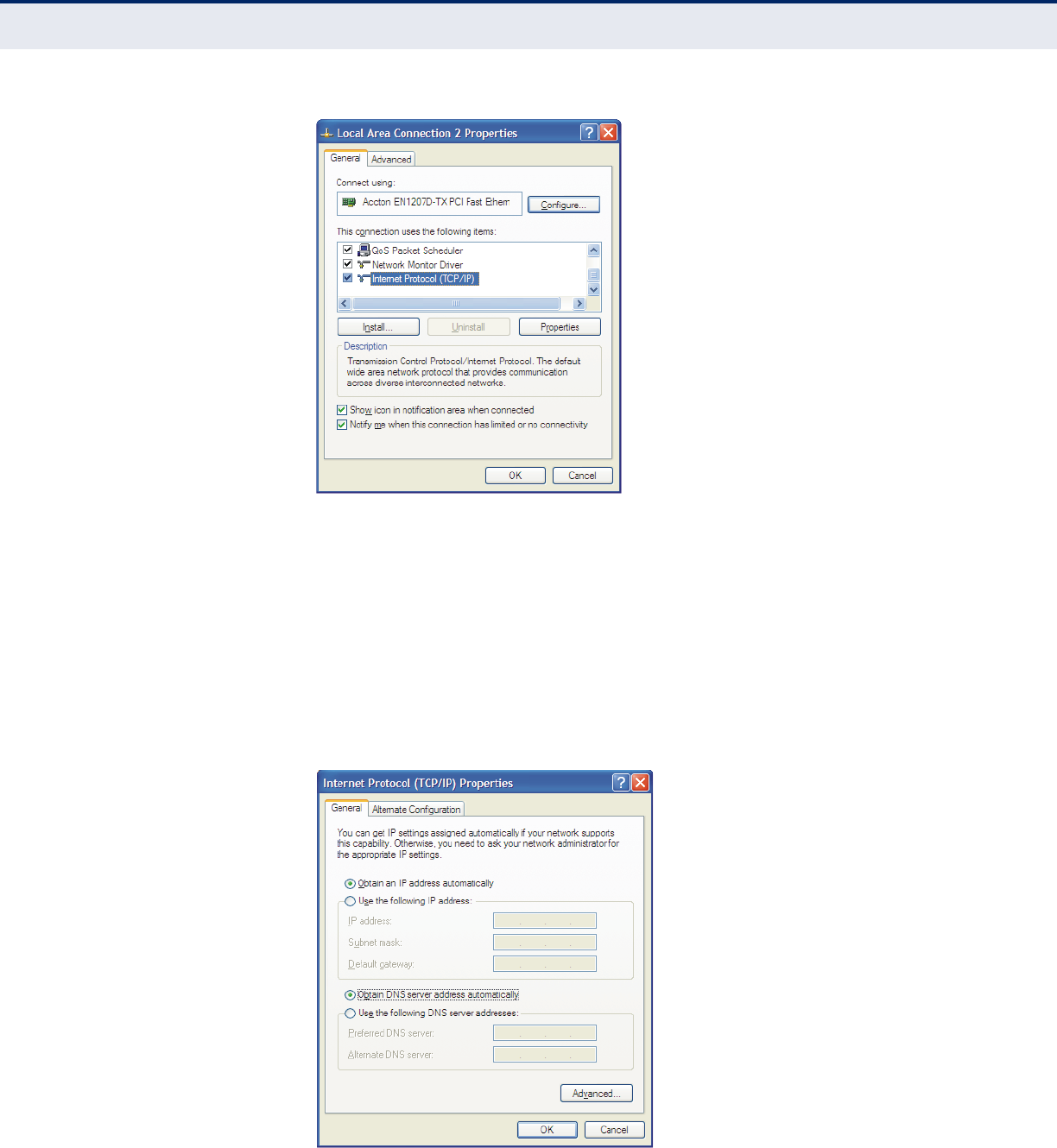
A
PPENDIX
B
| Configuring the PCs
– 120 –
Figure 118: Select TCP/IP
1.5 The following TCP/IP Properties window will display and the IP
Address tab is open on this window by default.
Now you have two ways to configure the TCP/IP protocol below:
Setting IP address automatically
Select Obtain an IP address automatically, Choose Obtain DNS server
automatically, as shown in the Figure below:
Figure 119: Obtain an IP address automatically
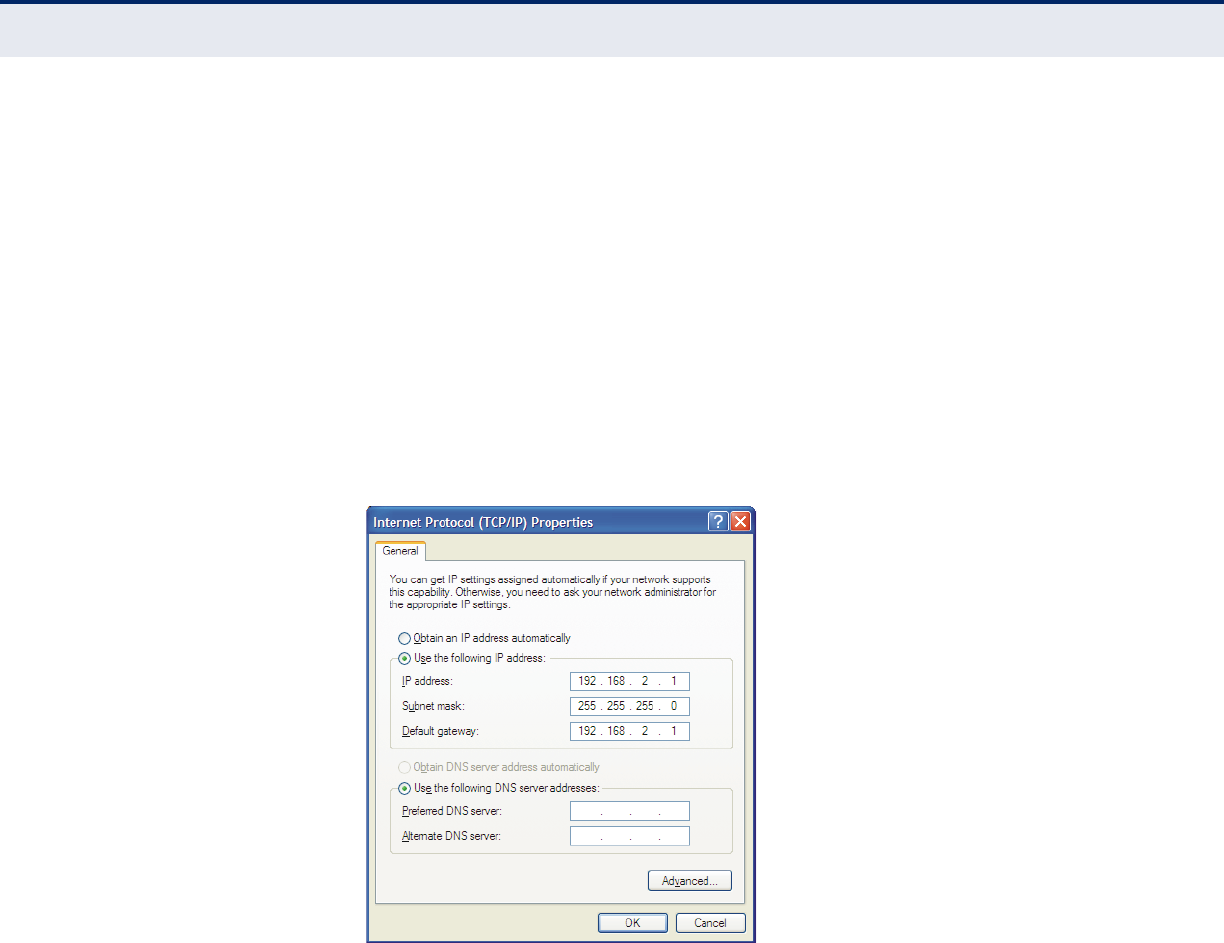
A
PPENDIX
B
| Configuring the PCs
– 121 –
Setting IP address manually
1. Select Use the following IP address radio button. And the following
items available
2. If the Router's LAN IP address is 192.168.2.1, type IP address is
192.168.2.x (x is from 2 to 254), and Subnet mask is 255.255.255.0.
3. Type the Router’s LAN IP address (the default IP is 192.168.2.1) into
the Default gateway field.
4. Select Use the following DNS server addresses radio button. In the
Preferred DNS Server field you can type the DNS server IP address,
which has been provided by your ISP.
Figure 120: Use the Following IP

– 122 –
CHARDWARE SPECIFICATIONS
STANDARDS IEEE 802.3 10BASE-T
IEEE 802.3u 100BASE-TX
IEEE 802.3ab 1000BASE-T
802.11b
802.11g
802.11n
PROTOCOL TCP/IP, PPPoE, DHCP, ICMP, NAT, SNTP
NUMBER OF PORTS 1 10/100/1000 Mbps Auto-Negotiation WAN RJ-45 port
4 10/100/1000 Mbps Auto-Negotiation LAN RJ-45 ports supporting Auto
MDI/MDIX
1 USB 2.0 port
CABLING TYPE 10BASE-T: UTP Category 3, 4, 5 cable (maximum 100 m)
EIA/TIA-568 100 STP (maximum 100 m)
100BASE-TX: UTP Category 5, 5e cable (maximum 100 m)
EIA/TIA-568 100 STP (maximum 100 m)
1000BASE-TX: UTP Category 5e, 6 cable (maximum 100 m)
EIA/TIA-568 100 STP (maximum 100 m)
LED INDICATORS Power, System, WLAN, WAN, LAN (1-4), USB, WPS
FREQUENCY BAND 2.4 ~ 2.4835 GHz
RADIO DATA RATE 11b: 11/5.5/2/1M (Automatic)
11g: 54/48/36/24/18/12/9/6M (Automatic)
11n: up to 300 Mbps (Automatic)
CHANNELS 13
FREQUENCY EXPANSION DSSS (Direct Sequence Spread Spectrum)

A
PPENDIX
C
| Hardware Specifications
– 123 –
MODULATION DBPSK, DQPSK, CCK, OFDM, 16-QAM, 64-QAM
SECURITY WEP/WPA/WPA2/WPA2-PSK/WPA-PSK
SENSITIVITY @PER 270M: -68dBm@10% PER;
130M: -68dBm@10% PER
108M: -68dBm@10% PER;
54M: -68dBm@10% PER
11M: -85dBm@8% PER;
6M: -88dBm@10% PER
1M: -90dBm@8% PER
RF POWER 20dBm (max EIRP)
ANTENNA GAIN 3dBi*3
TEMPERATURE Operating: 0 °C to 40 °C (32 to 104 °F)
Storage: -40 °C to 70 °C (-40 to 158 °F)
HUMIDITY Operating: 10% to 90% (non-condensing)
Storge: 5%-90% (non-condensing)

– 124 –
GLOSSARY
IEEE 802.11BA wireless standard that supports wireless communications in the 2.4 GHz
band using Direct Sequence Spread Spectrum (DSSS). The standard
provides for data rates of 1, 2, 5.5, and 11 Mbps.
IEEE 802.11GA wireless standard that supports wireless communications in the 2.4 GHz
band using Orthogonal Frequency Division Multiplexing (OFDM). The
standard provides for data rates of 6, 9, 12, 18, 24, 36, 48, 54 Mbps. IEEE
802.11g is also backward compatible with IEEE 802.11b.
IEEE 802.11NA wireless standard that supports wireless communications in the 2.4 GHz
band using Orthogonal Frequency Division Multiplexing (OFDM). The
standard provides for data rates of
27, 54, 81, 108, 162, 216, 243, 270,
300
Mbps. IEEE 802.11n is also backward compatible with IEEE 802.11b/g.
DDNS (DYNAMIC
DOMAIN NAME SYSTEM)
The capability of assigning a fixed host and domain name to a dynamic
Internet IP Address.
DHCP Dynamic Host Configuration Protocol: Provides a framework for passing
configuration information to hosts on a TCP/IP network. DHCP is based on
the Bootstrap Protocol (BOOTP), adding the capability of automatic
allocation of reusable network addresses and additional configuration
options.
DMZ (DEMILITARIZED
ZONE)
A Demilitarized Zone allows one local host to be exposed to the Internet for
a special-purpose service such as Internet gaming or videoconferencing.
DNS (DOMAIN NAME
SYSTEM)
An Internet Service that translates the names of websites into IP
addresses.
DOMAIN NAME A descriptive name for an address or group of addresses on the Internet.
DSL (DIGITAL
SUBSCRIBER LINE)
A technology that allows data to be sent or received over existing
traditional phone lines.

G
LOSSARY
– 125 –
ISP (INTERNET SERVICE
PROVIDER)
A company that provides access to the Internet.
MTU (MAXIMUM
TRANSMISSION UNIT)
The size in bytes of the largest packet that can be transmitted.
NAT (NETWORK
ADDRESS TRANSLATION)
NAT technology translates IP addresses of a local area network to a
different IP address for the Internet.
PPPOE (POINT TO POINT
PROTOCOL OVER
ETHERNET)
PPPoE is a protocol for connecting remote hosts to the Internet over an
always-on connection by simulating a dial-up connection.
SSID A Service Set Identification is a thirty-two character (maximum)
alphanumeric key identifying a wireless local area network. For the wireless
devices in a network to communicate with each other, all devices must be
configured with the same SSID. This is typically the configuration
parameter for a wireless PC card. It corresponds to the ESSID in the
wireless Access Point and to the wireless network name.
WEP (WIRED
EQUIVALENT PRIVACY)
A data privacy mechanism based on a 64-bit or 128-bit or 152-bit shared
key algorithm, as described in the IEEE 802.11 standard.
WI-FIA trade name for the 802.11b wireless networking standard, given by the
Wireless Ethernet Compatibility Alliance (WECA, see http://www.wi-fi.net),
an industry standards group promoting interoperability among 802.11b
devices.
WLAN (WIRELESS
LOCAL AREA NETWORK)
A group of computers and associated devices communicate with each other
wirelessly, which network serving users are limited in a local area.
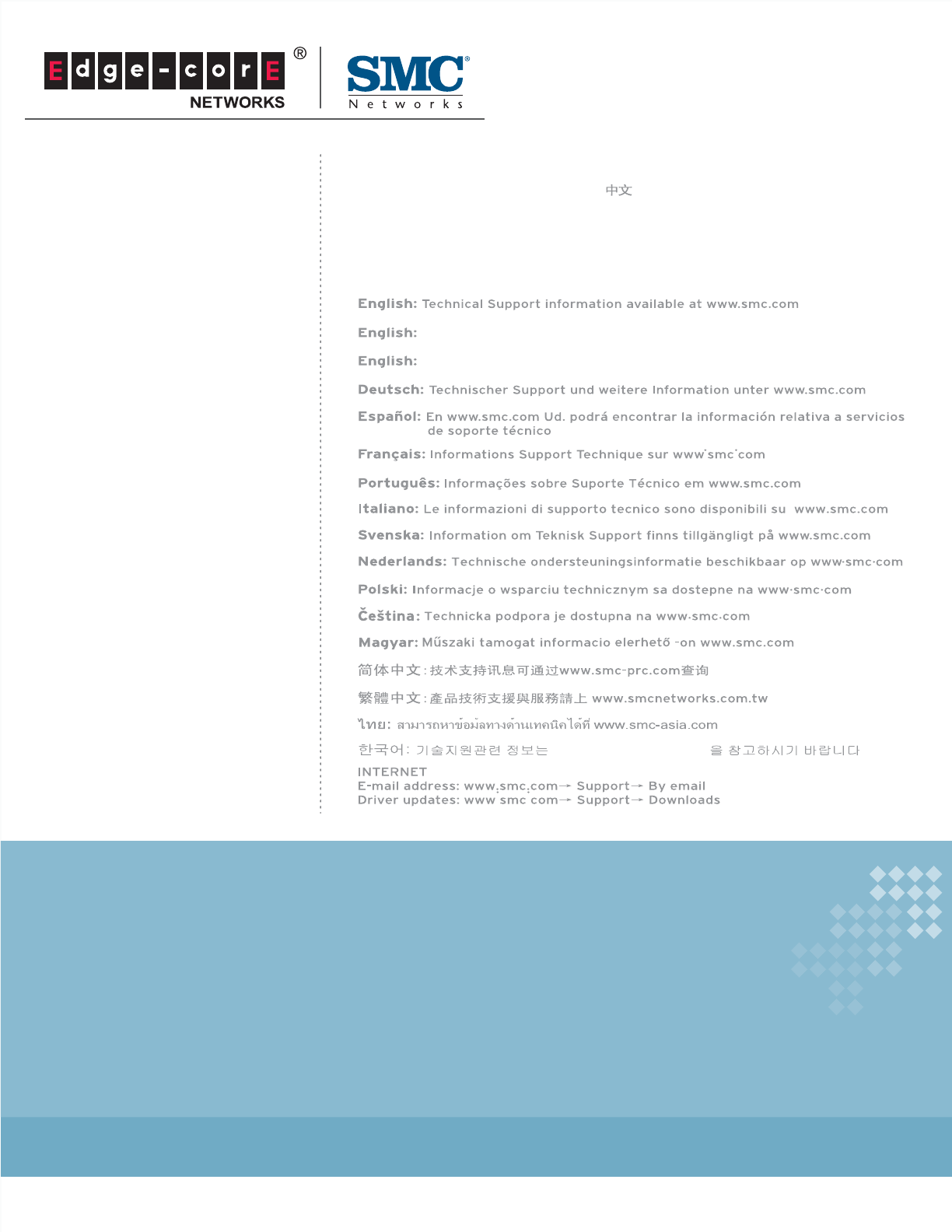
1910020410
Middle East Office
Office No. 416, Le Solarium Bldg
Dubai Silicon Oasis
Dubai, U.A.E.
Tel: +971-4-3564800
Fax:+971-4-3564801
Europe & N. Africa Office
C/Fructuós Gelabert 6-8, 2o, 2a
Edificio Conata II
08970 Sant Joan Despí
Barcelona, Spain
Tel: +34 93 477 4920
Asia-Pacific Office
1 Coleman Street
#07-09, The Adelphi
Singapore 179803
Tel: +65-63387667
Fax: +65-63387767
(for Asia-Pacific): Technical Support information at www.smc-asia.com
Headquarters &
Sub-Sahara Africa Office
No. 1, Creation Rd. III
Hsinchu Science Park
Taiwan 30077
Tel: +886 3 5770270
Fax: +886 3 5780764
North America Office
20 Mason
Irvine CA 92618 U.S.A.
Tel: +1 (949) 679-8000
SMC NETWORKS TECHNICAL SUPPORT
From U.S.A. and Canada (24 hours a day, 7 days a week)
Tel: +1 (800) SMC-4-YOU/+1 (949) 679-8000 Fax: +1 (949) 679-1481
www.smcnetworks.co.kr
From Singapore in English and (Mon.-Fri. 9 AM to 5 PM)
Tel: +65-63387667, Ext. 4
From the United Arab Emirates in English (Sun.-Thu. 9 AM to 6 PM)
Tel: +971 800 222866/+971 4 3564810
(for Middle East): Technical Support information at muneer@smc-asia.com
www.edge-core.com / www.smc.com
SMCWGBR14-N2